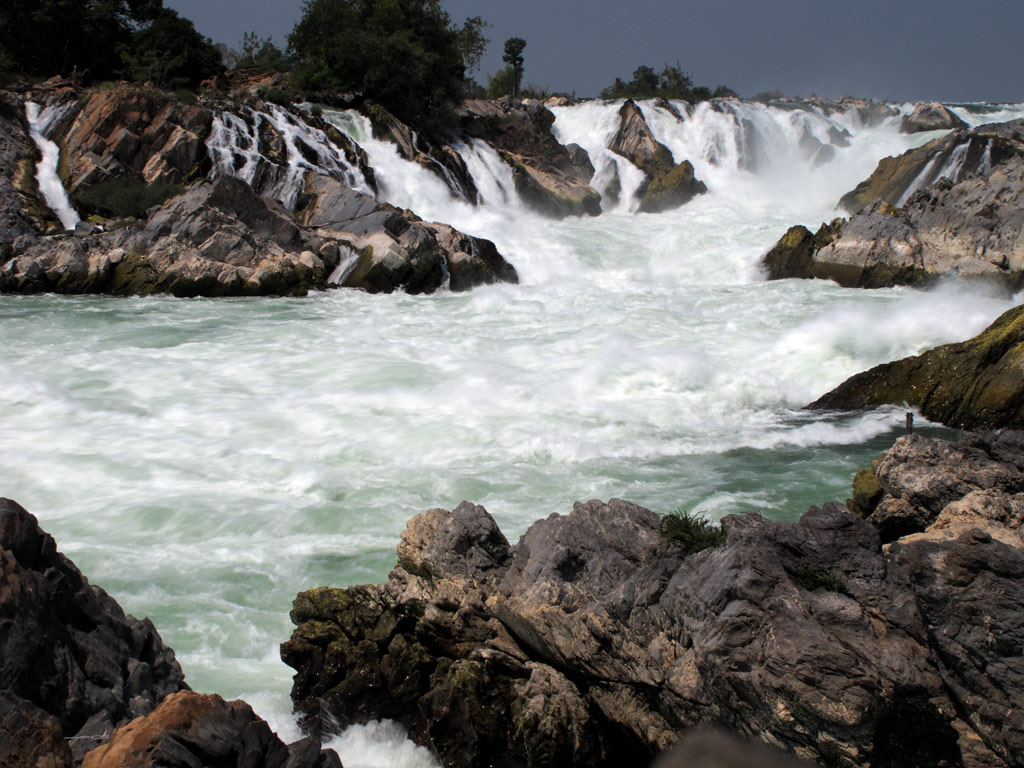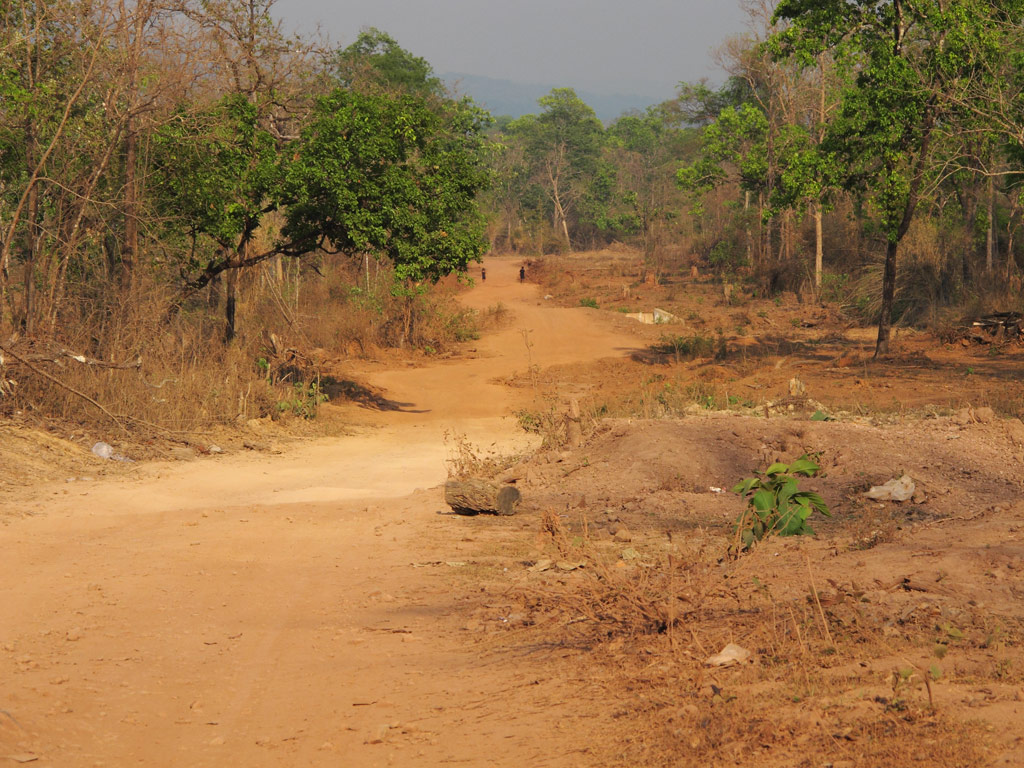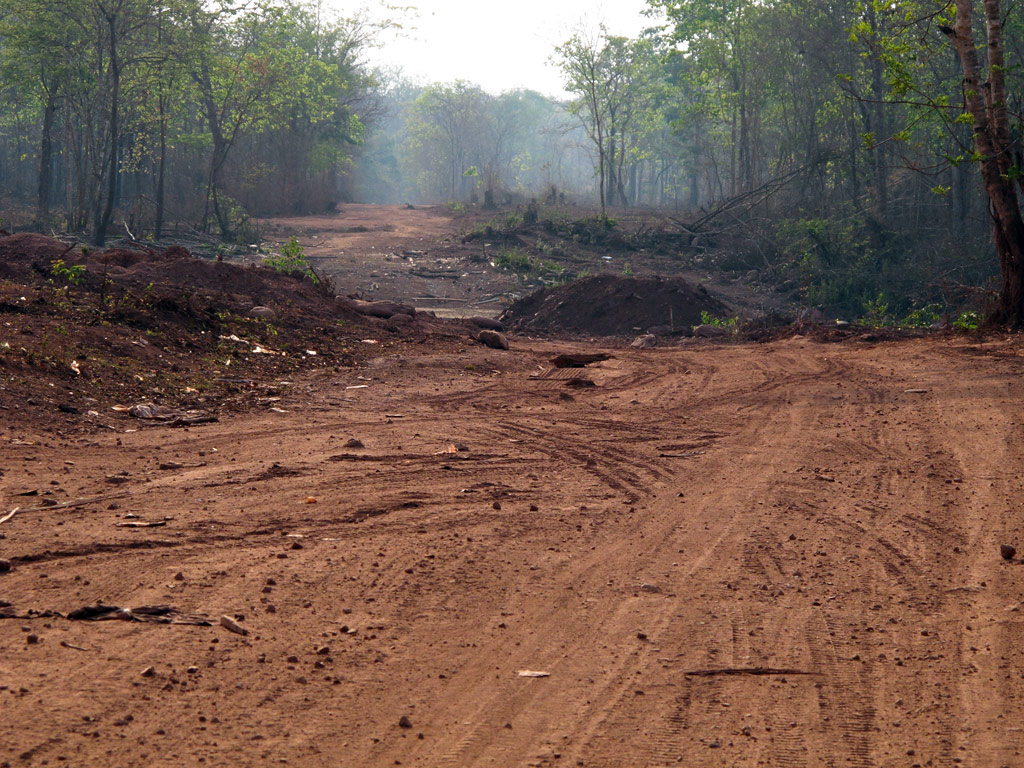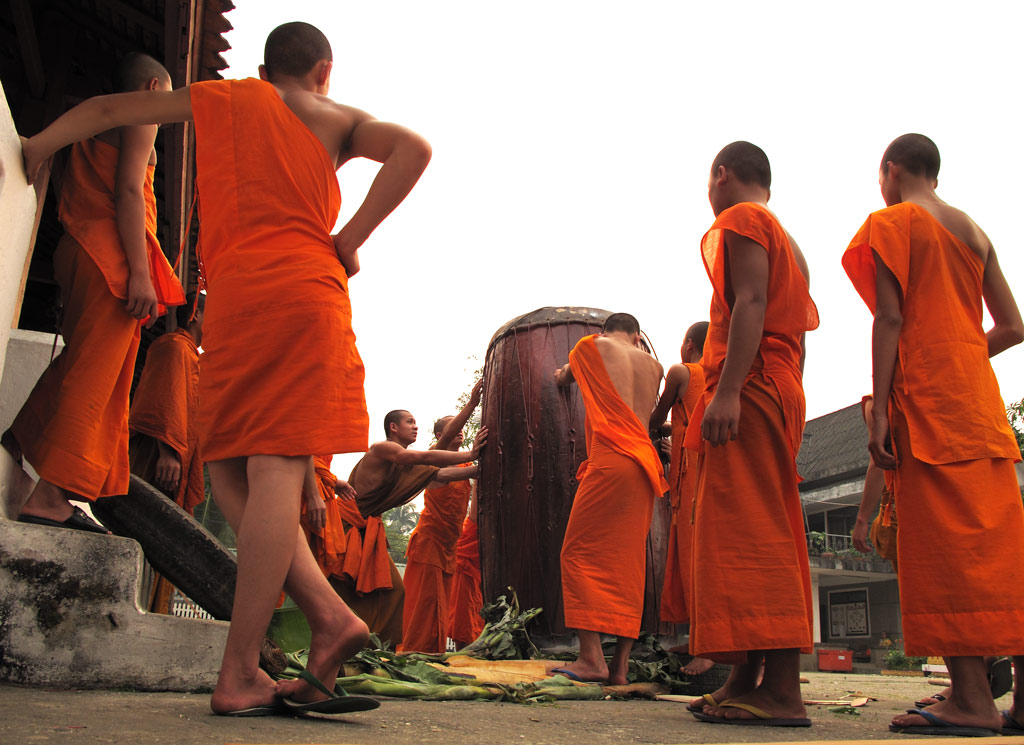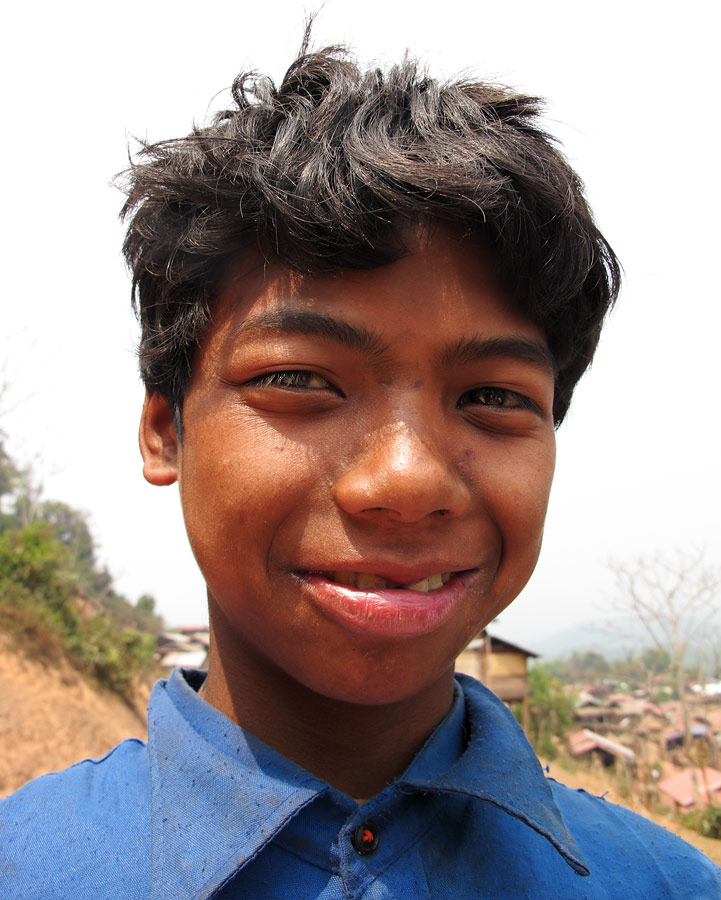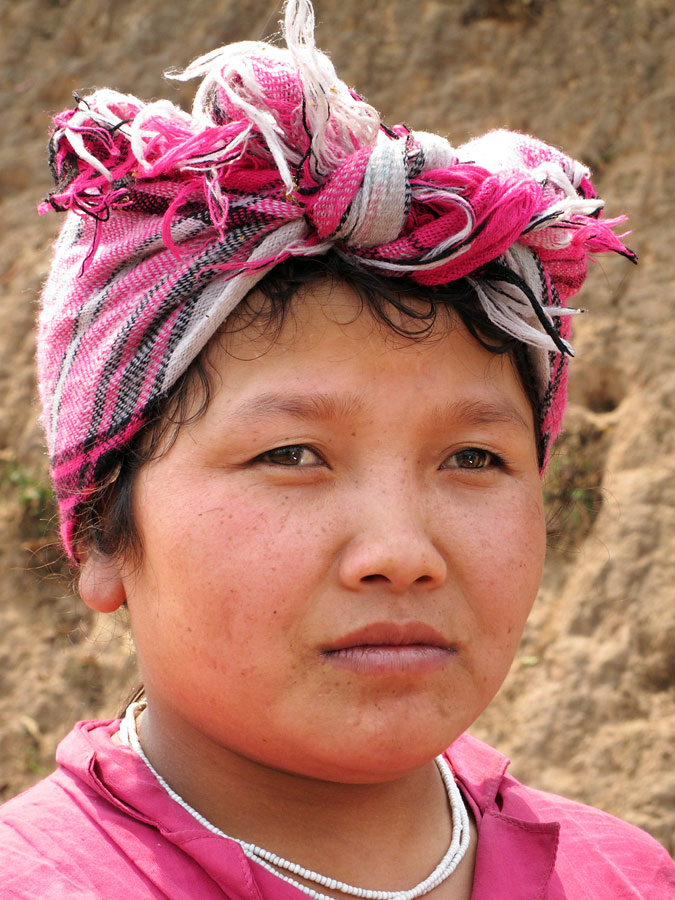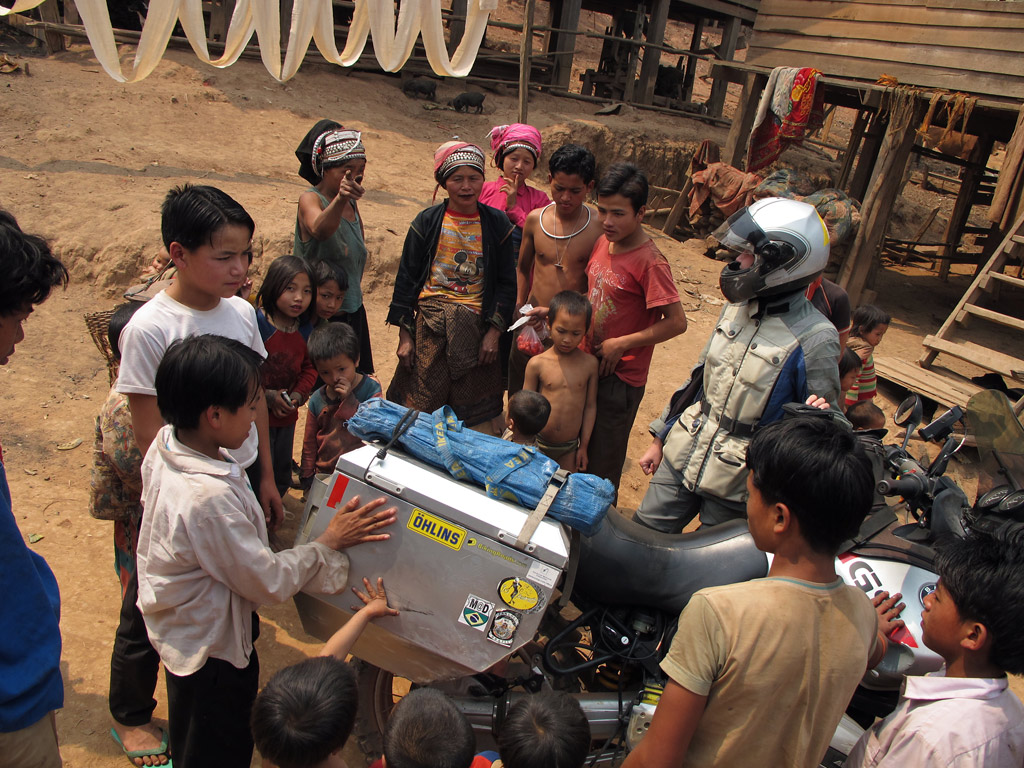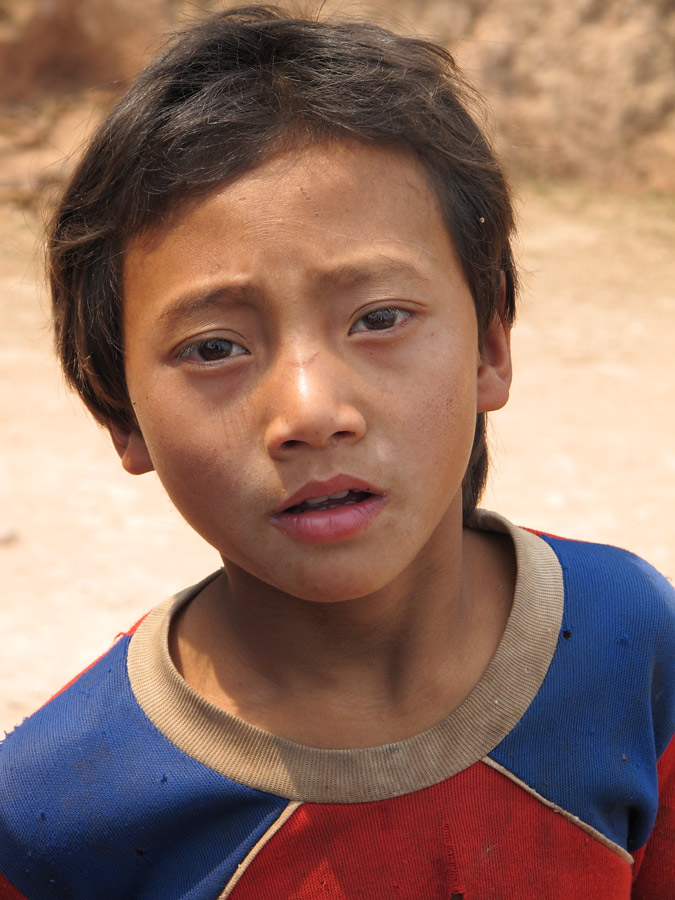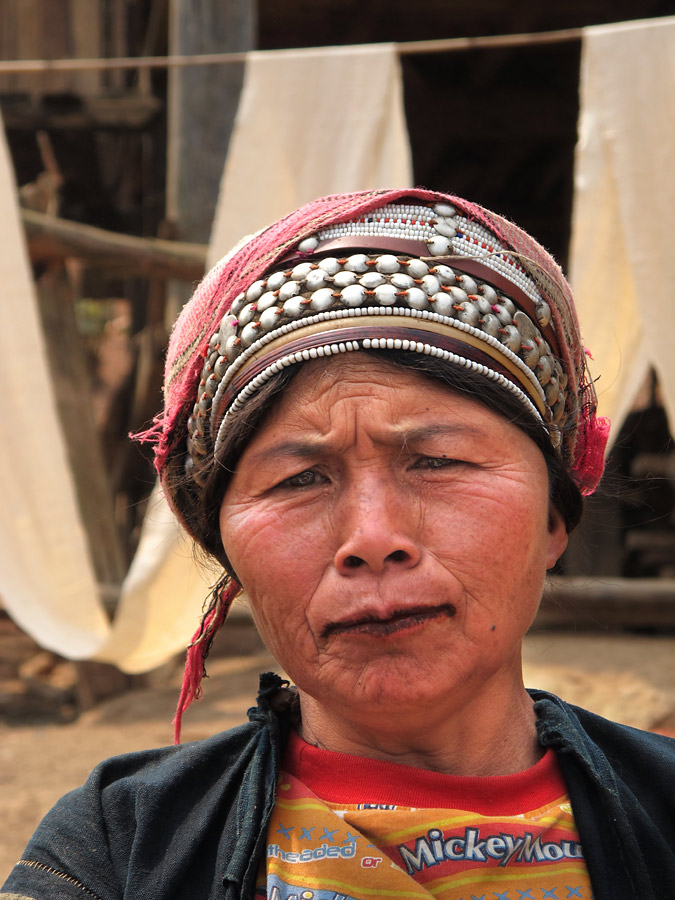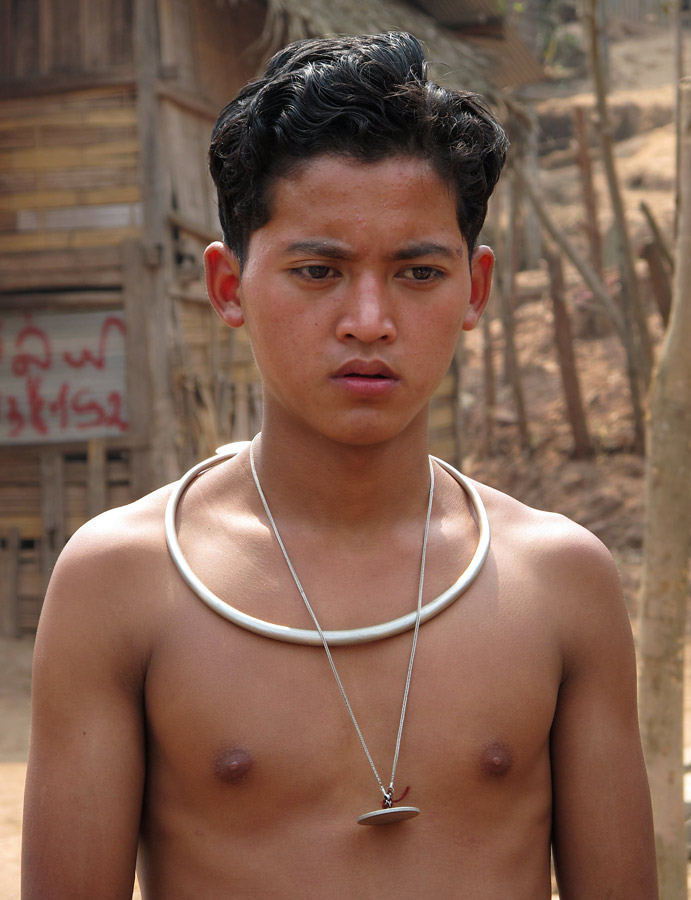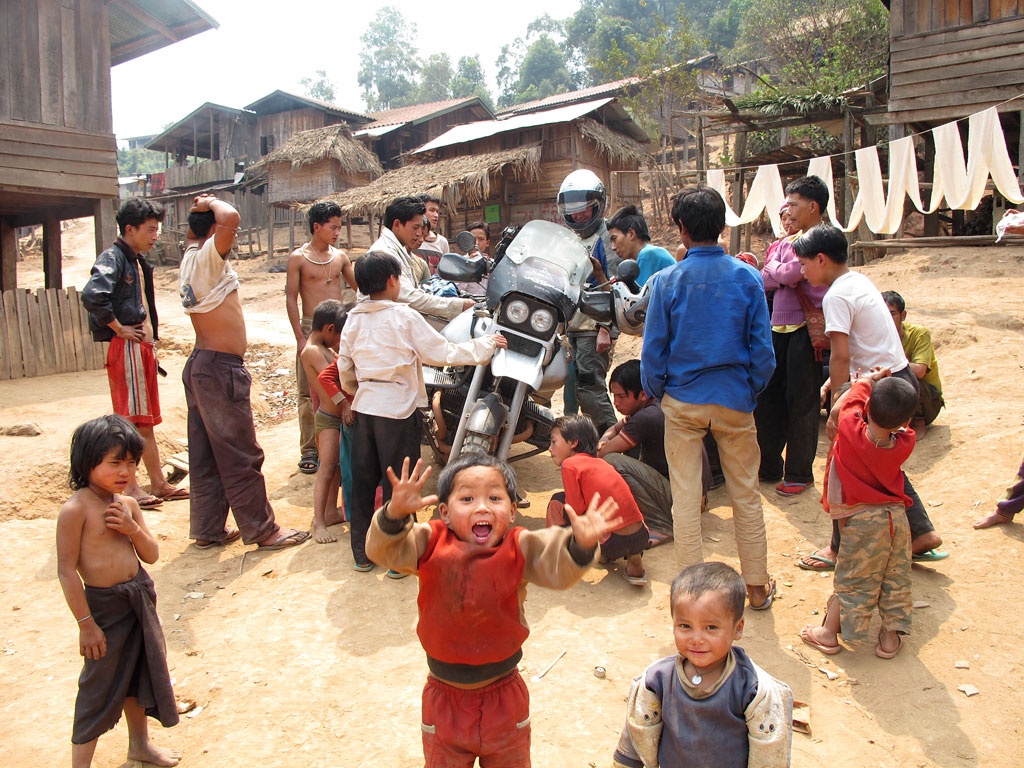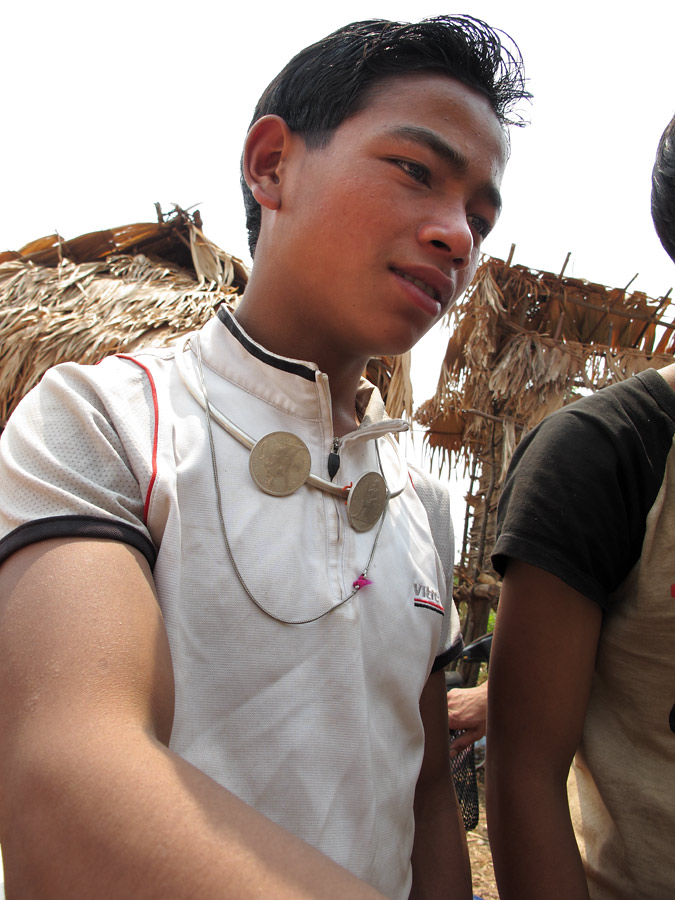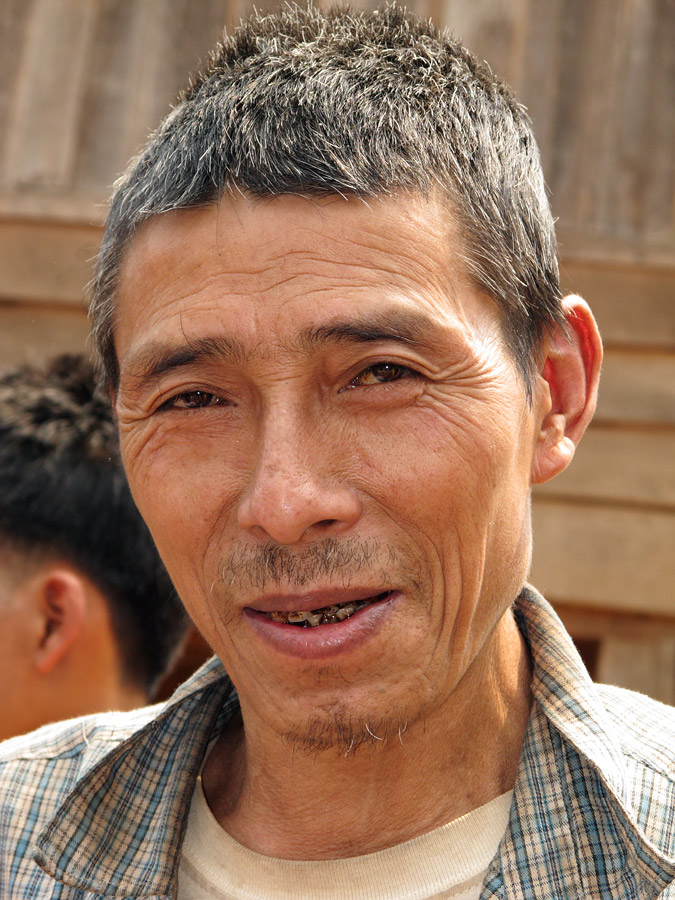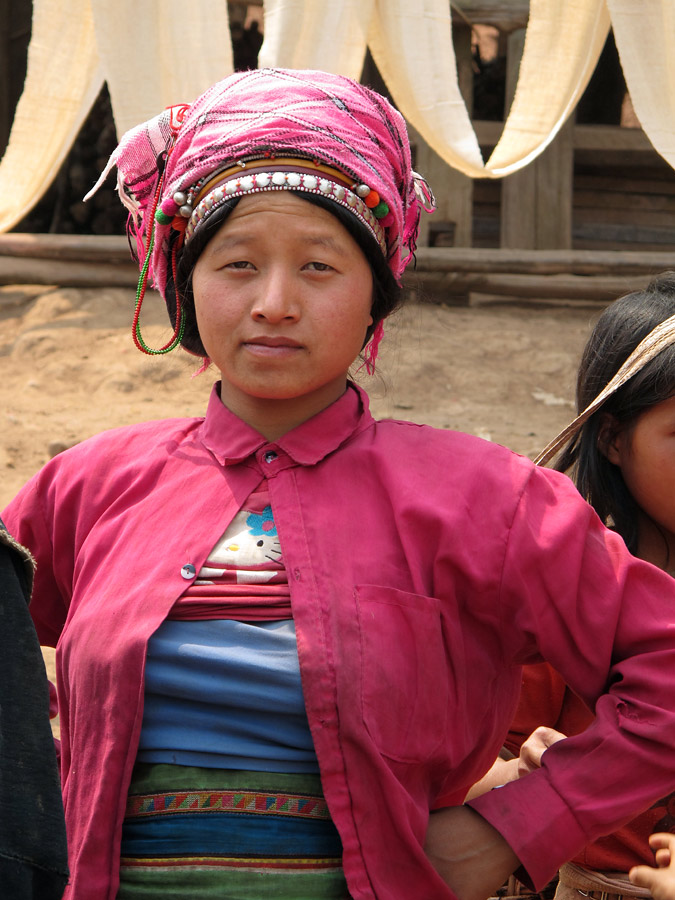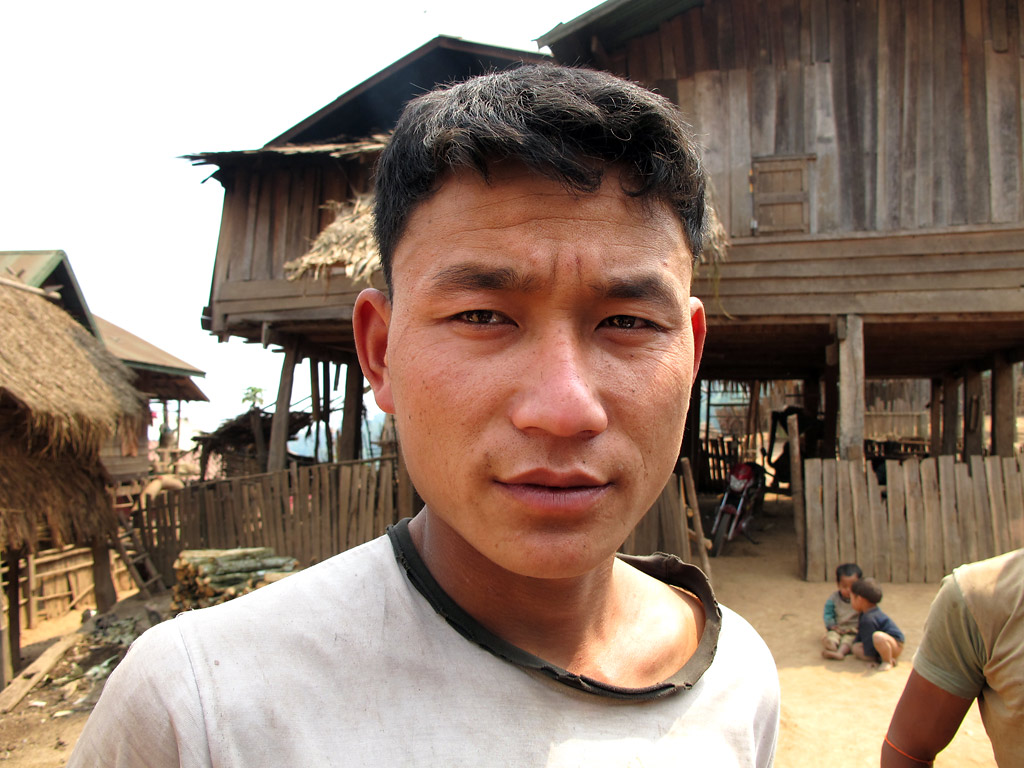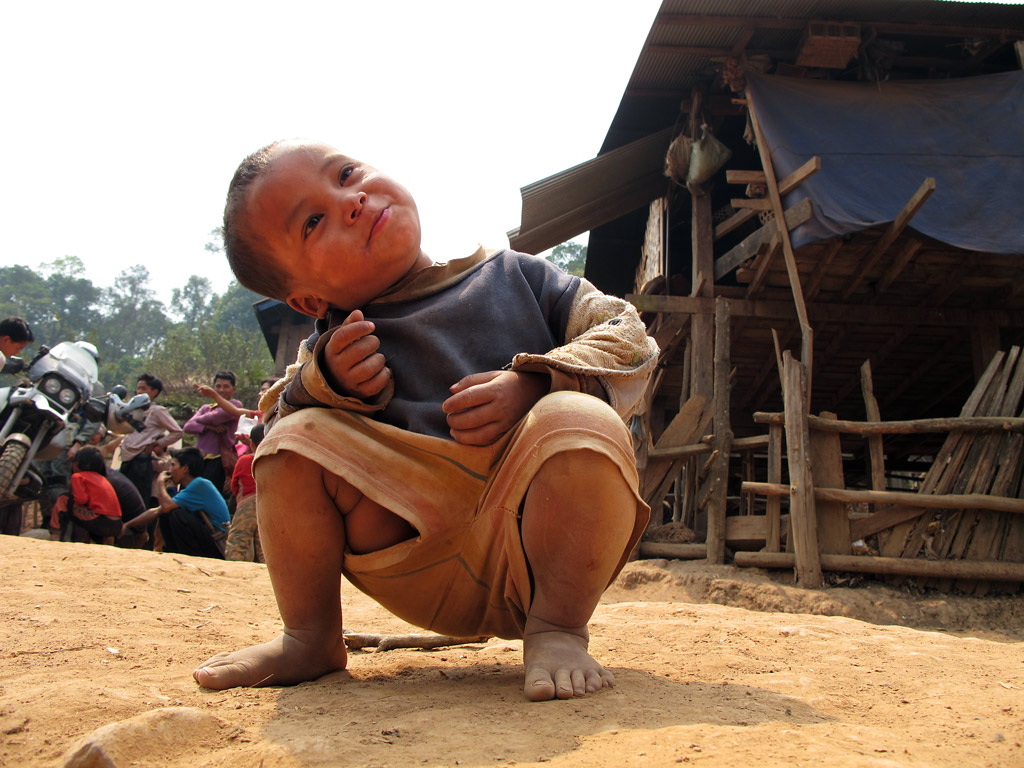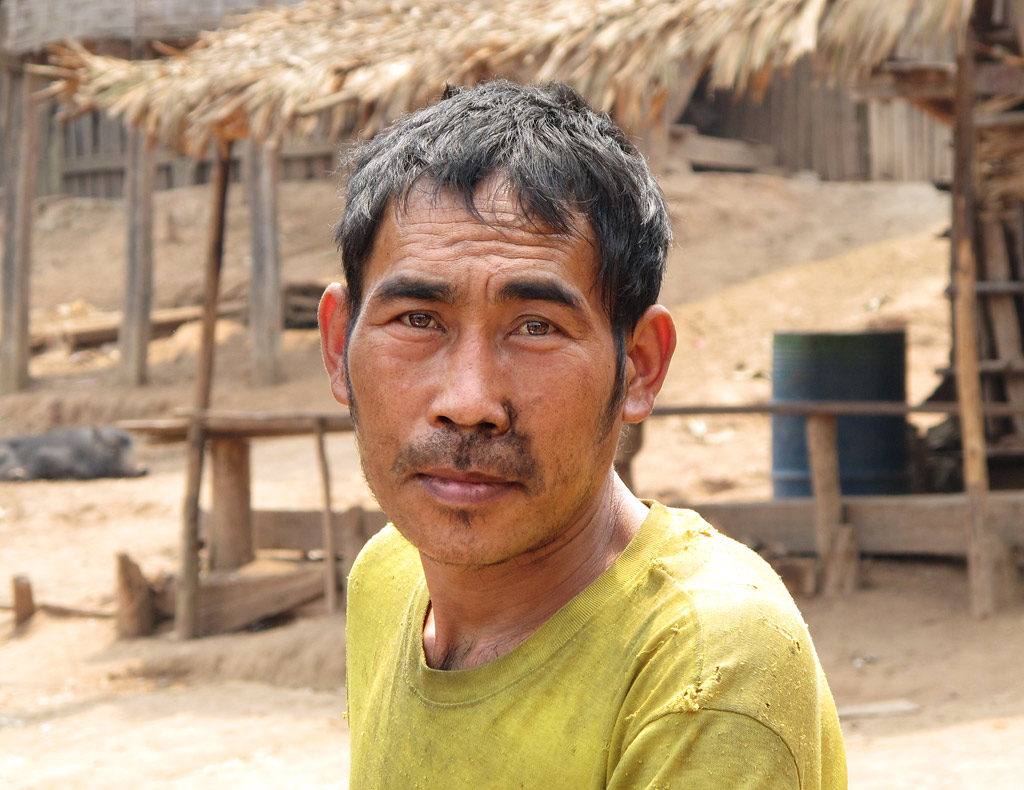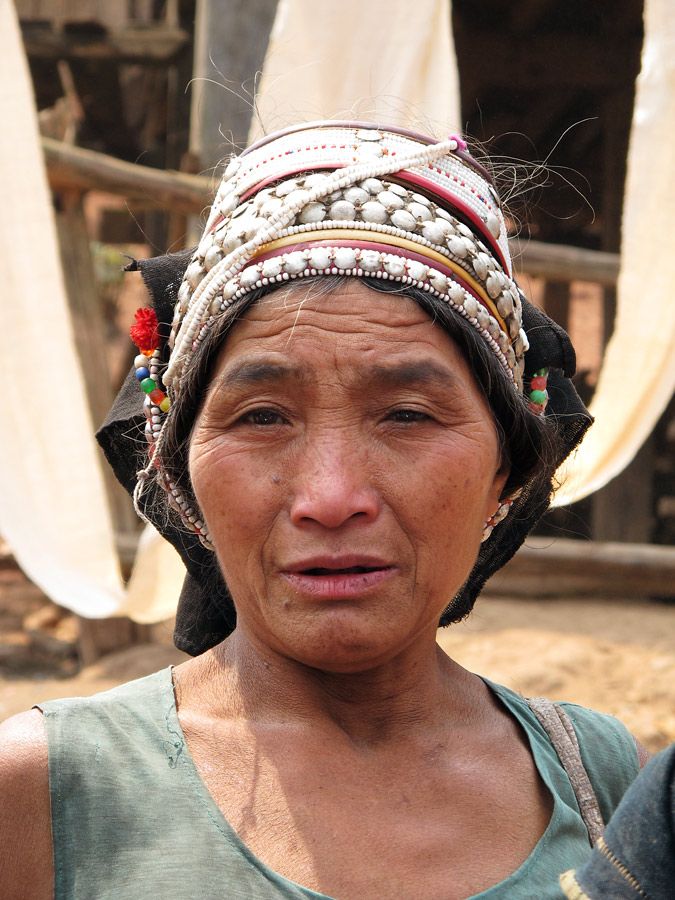The border crossing from Cambodia to Laos was easy, except for the nasty migration officers on both sides that have been spoiled by tourists who are willing to give money away just like that, even if they know that their dollars go straight into the officers' pockets. The Cambodians were easy to deal with. They asked for one dollar, and we asked for a receipt. They know damn well that we know that they shouldn't be asking for "stamping fees", so our passport were stamped with no dollars involved. It was a tad more difficult on the Lao side, where the rather young (and a bit nervous, after we asked for a receipt with is name) officer called his boss to clarify the subject to us, but all he could say to justify the one dollar stamping fee, was that "everybody pays". Well, we were not so eager to support corruption, so we insisted on a receipt, and got our passport stamped without flashing any money. Great success!
We rode off the border post and made a small detour to see what is supposed to be one of South-East Asia's biggest waterfalls, at least by volume. Although it is the dry season here, the Khong Phapheng still looked pretty impressive.
As we travelled further north we were stunned by the good (and I mean it!) quality of the road, because we had only heard about how bad and muddy the Lao roads are. But it was all smooth tarmac, just as if we had arrived in some develpoed country. But the countryside looked pretty rustic and undeveloped with the thatched huts, and we were surprised to see communist memorials and bright red flags here and there. We had not suspected Laos was a communist country.
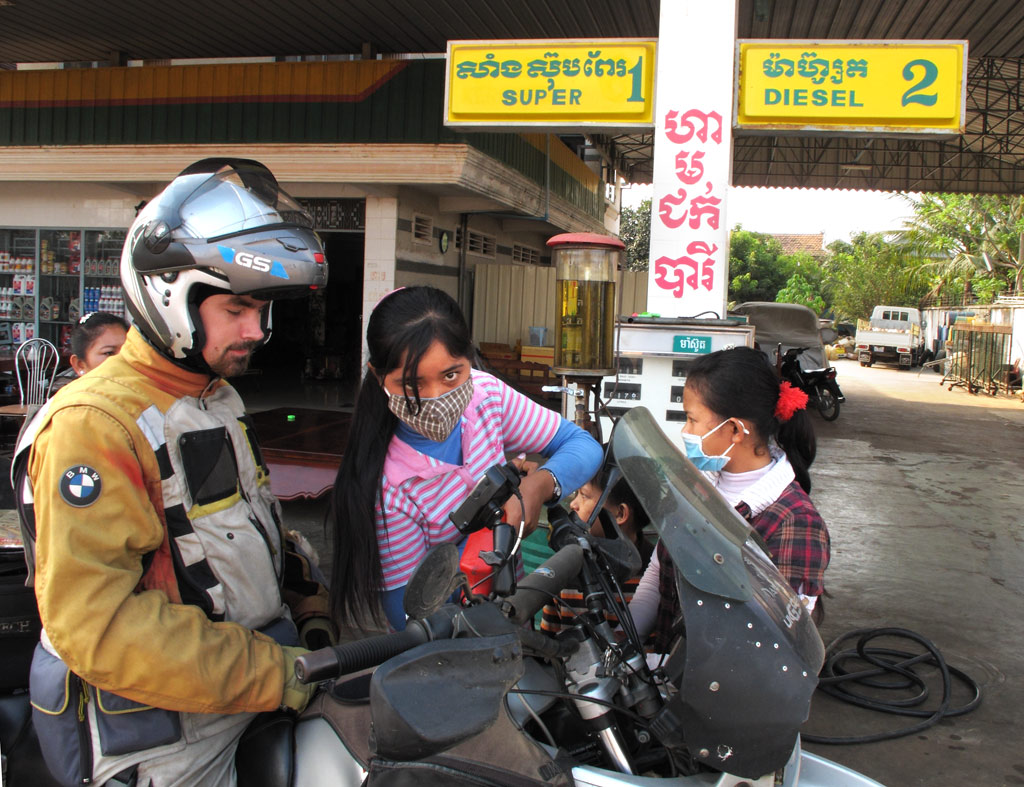
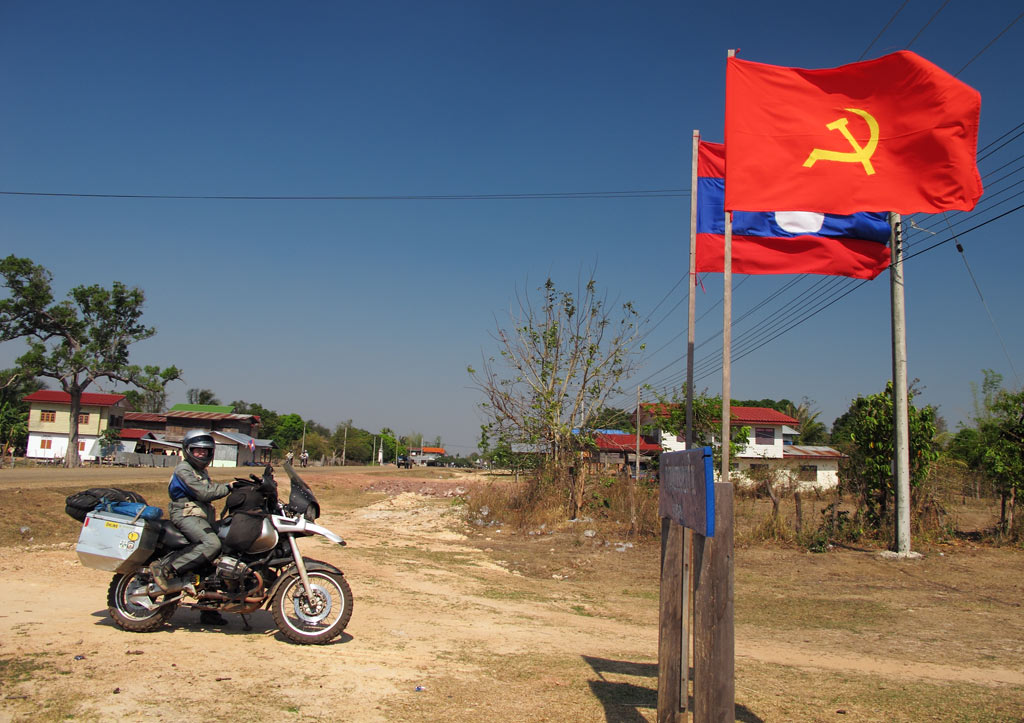
Communism is alive an kicking in Laos. The same soviet rhetorics still going strong.
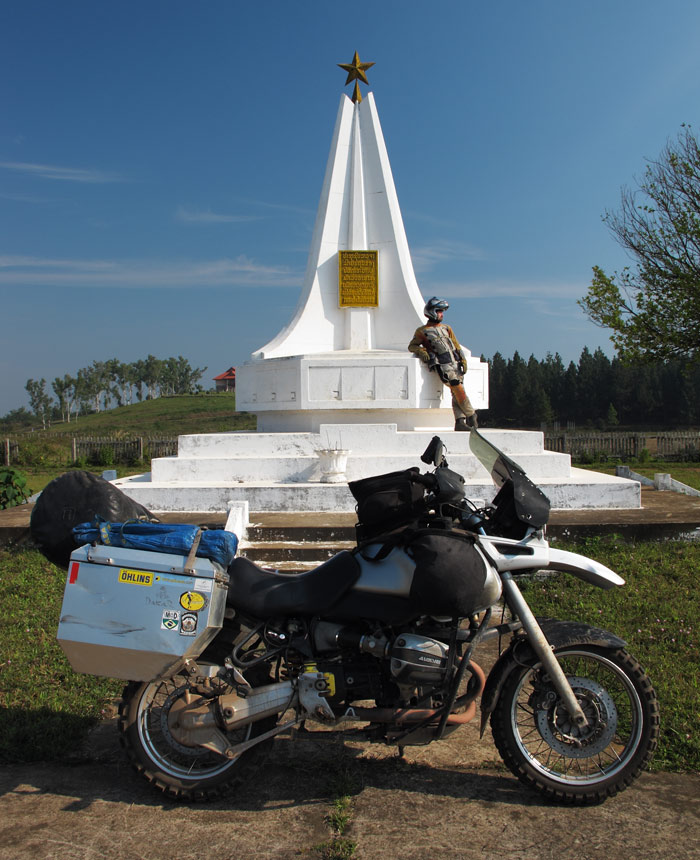
Communist monument.
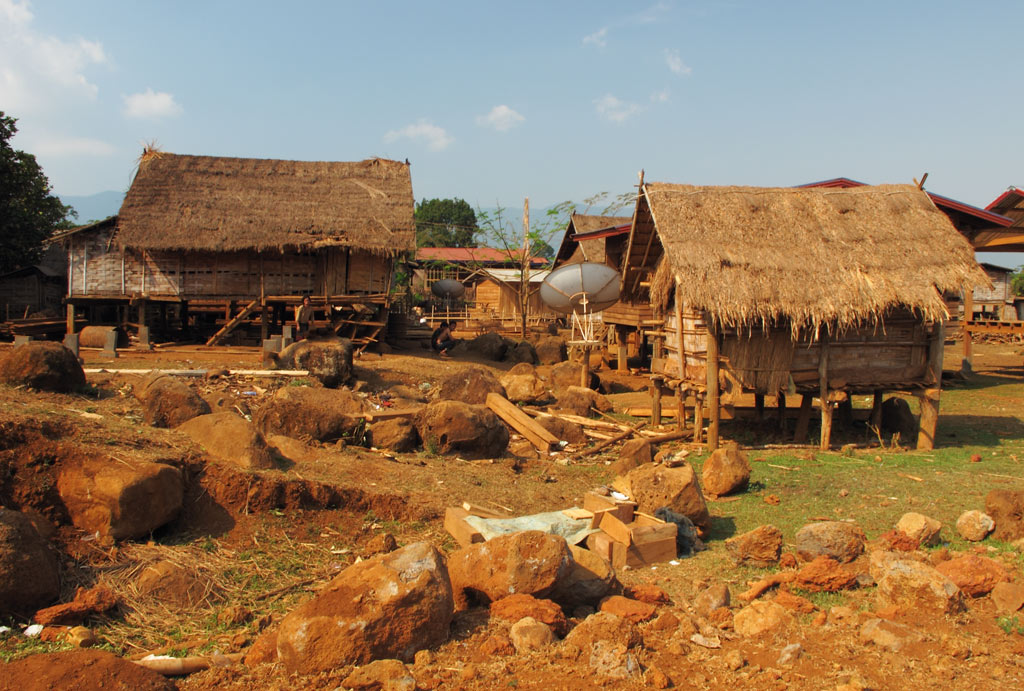
Typical Lao village.
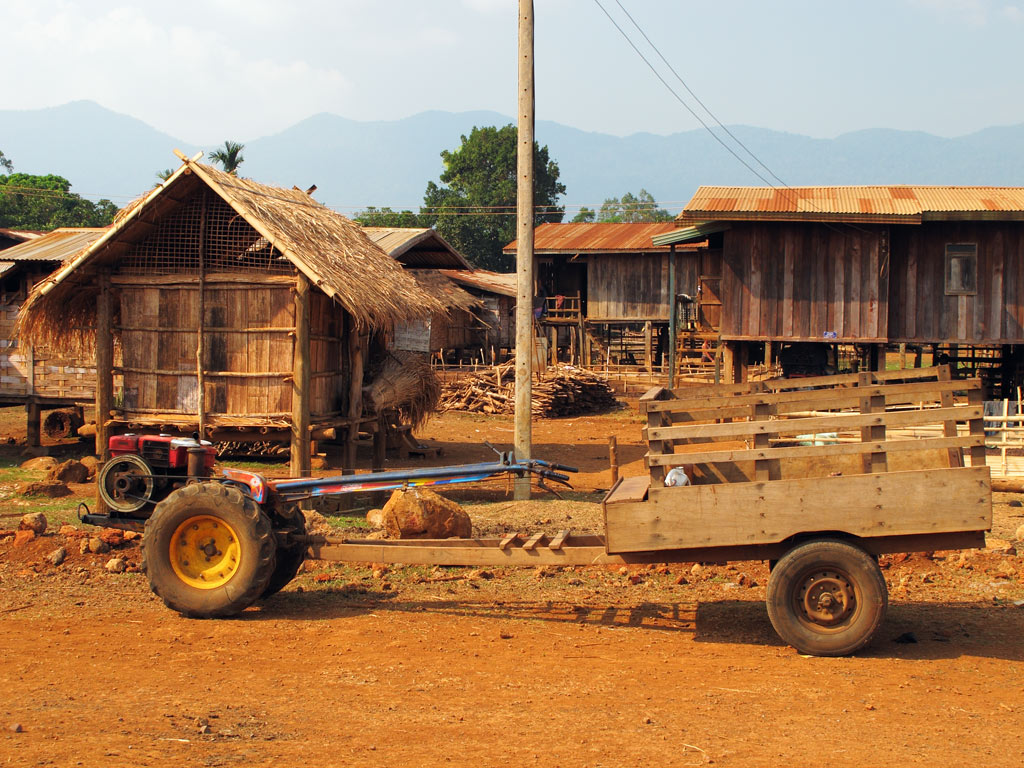
Local transport in front of Lao village.
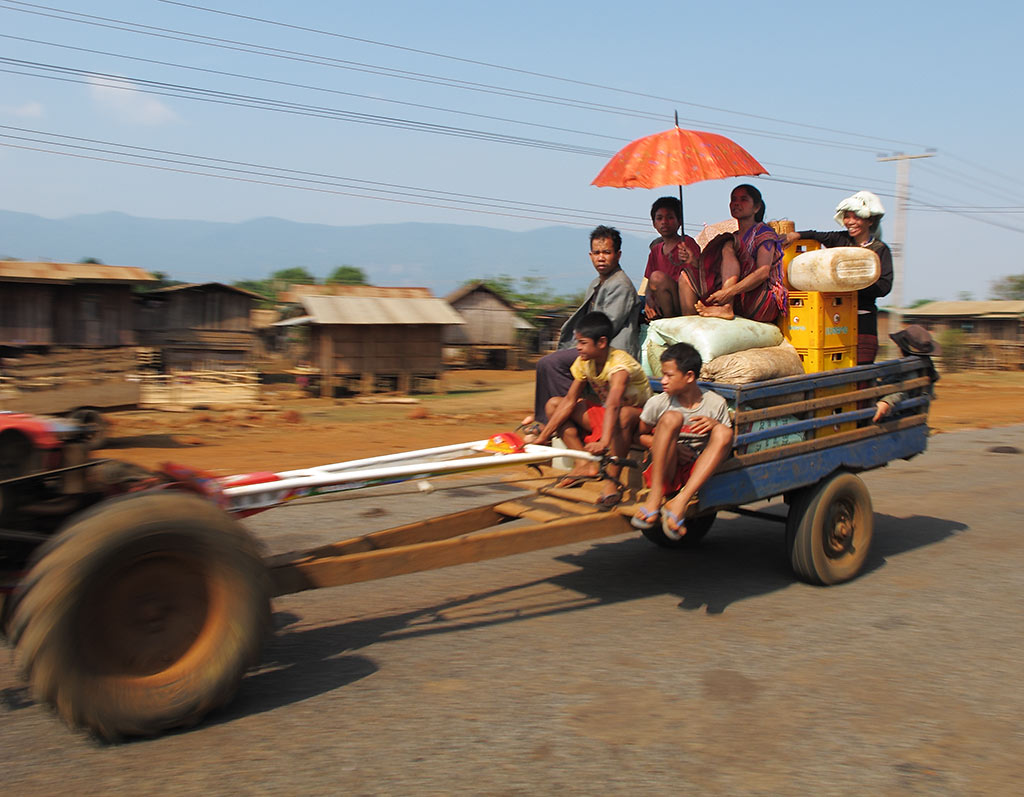
Transport in Laos way
We plunged deeper into the countryside and decided to check out some smaller roads. We had managed to pick a road that was just in the process of being constructed, and it was rough indeed - pretty rocky and included some river crossings and conditions got tougher all the time - there were almost no traffic on the road in the end - it was more varying technical terrain riding, with some patches of better gravel. On one patch as we stopped to take a picture and to relax from hard physical work we had to endure on technical sections, Kariina told me that I was not going to like what she had to show me.
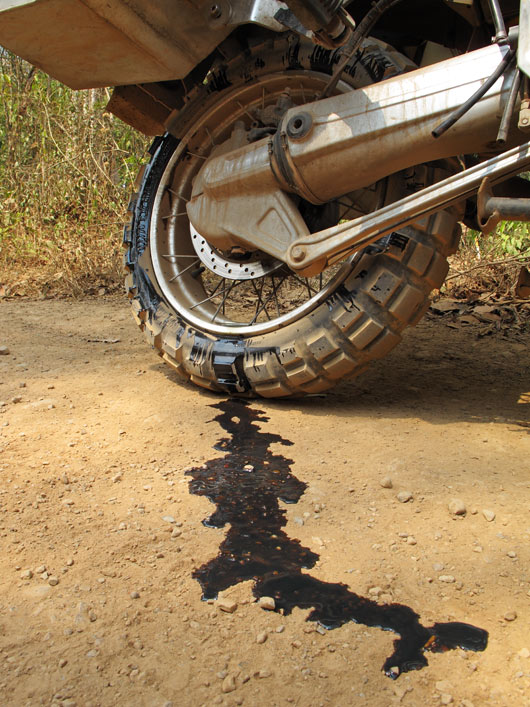
The final drive was leaking, badly, and we could see small pieces of metal in the oil. Great! According to our map, the nearest village was tens of kilometers away, so we just stood there and watched it drain. And while we did, some bugs were making strange, almost hypnotizing noises in the trees, just as if it was a movie and something odd was going to happen.
Some road work trucks passed us, but none stopped.
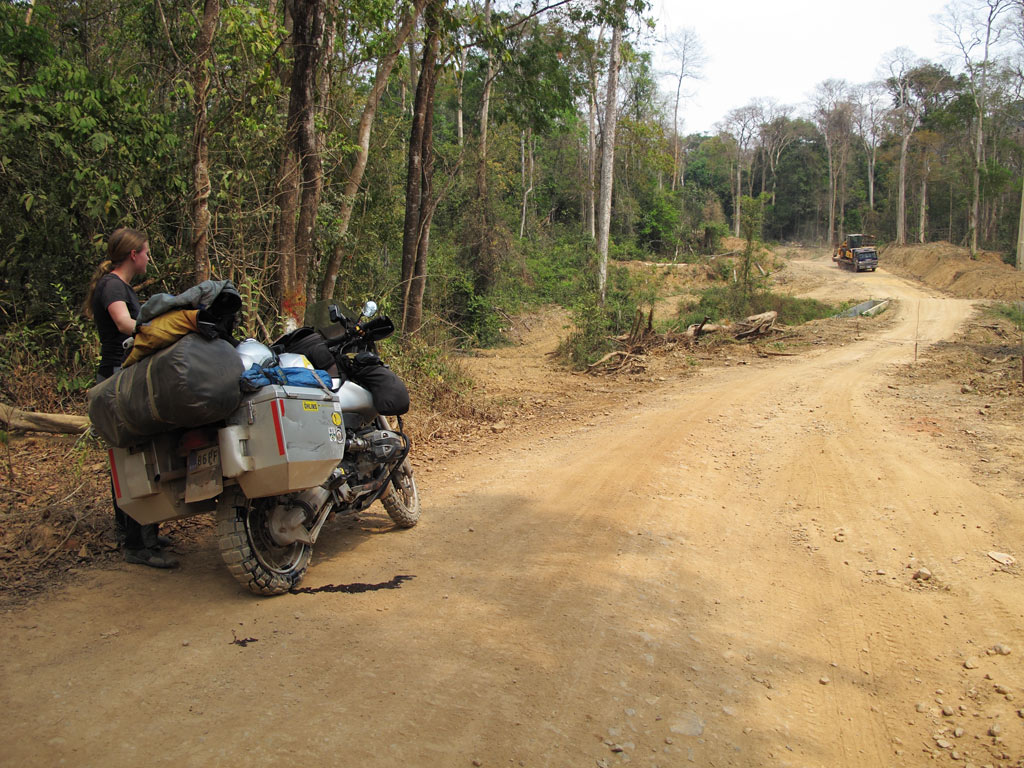
We kept our cool. In fact, we did not feel any anxiety at all, and as two guys on a scooter approached us, speaking no English at all, and giggled at the sight of oil flowing onto the dusty ground, all we could do is laugh with them. It was an absurd situation.
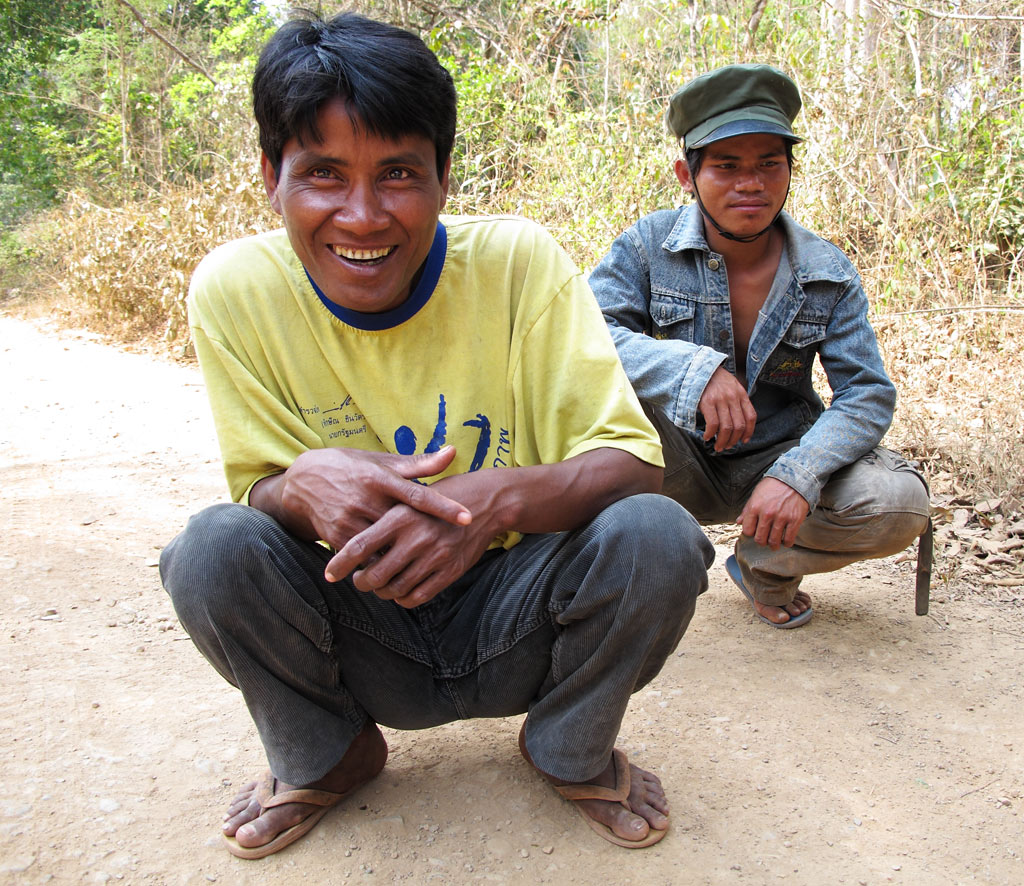
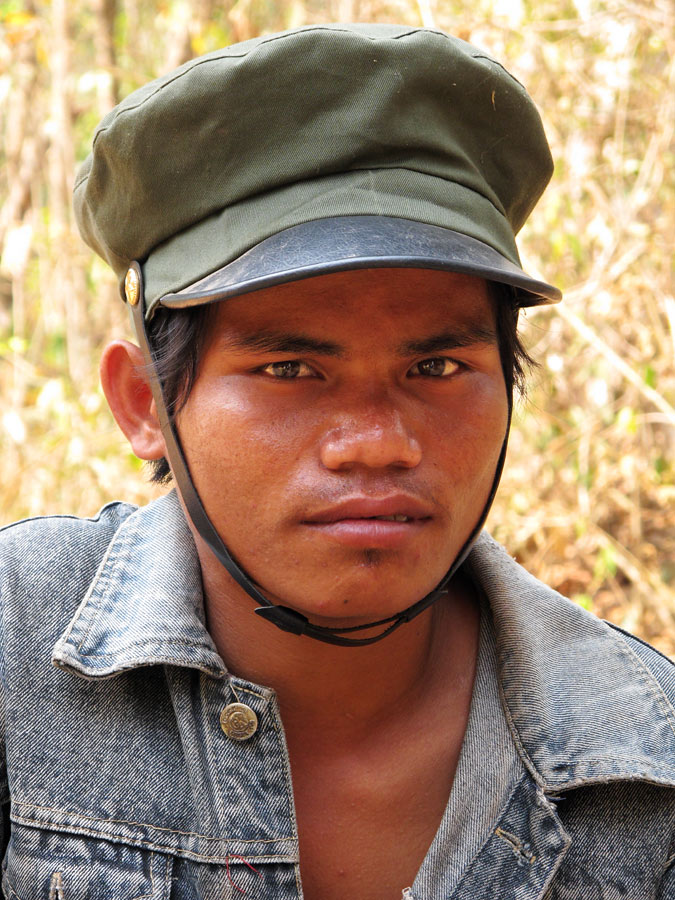
They rolled off, we stayed. It was not a first time sight for us. The first time the shaft drive leaked we were on Ruta 40 in Argentina, and we had managed to replace both the bearing and the seal in the small village of Perito Moreno. Both back then and now we had the spare parts with us, so no problem, but undertaking the repairs while still aside the road would have been perhaps too much adventure. Continuing to ride to the next village would not have been an option (although that is what we did the last time, but back then it was dripping slowly), since the shaft drive this time had leaked basically empty (the seal was totally ripped) and riding like that would have done a lot of damage. We had to wait for someone to come and pick us up.
But there was virtually no traffic, and after a half an hour we decided to switch to Plan B - to ride, despite all, to the nearest place where there are people. After three kilometers of slow and careful riding we arrived in a place with a couple of simple huts. It was no village, but there were people. We tried explaining to them what had happened and that we needed a pick-up truck or something, but no English was spoken, as usual, so we decided to wait by one of the huts.
The family was friendly, and their kids were curious about us and our bike.
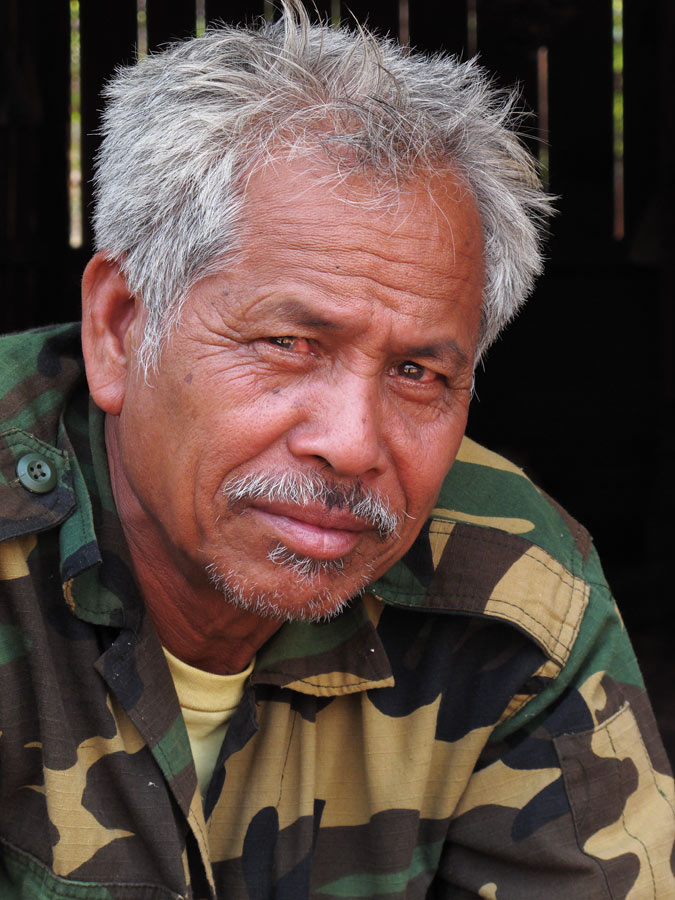
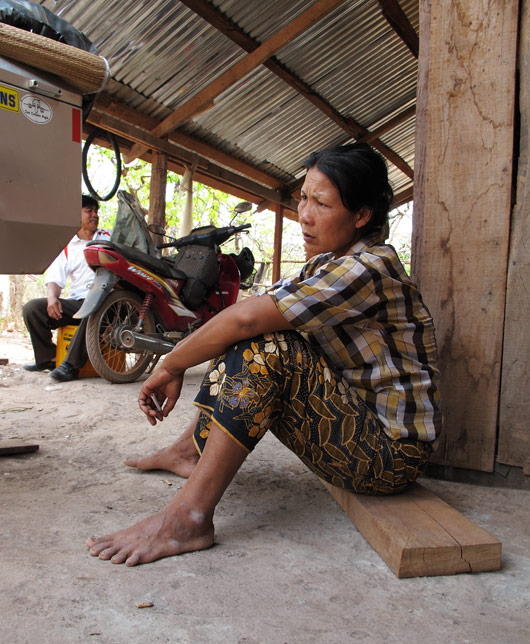
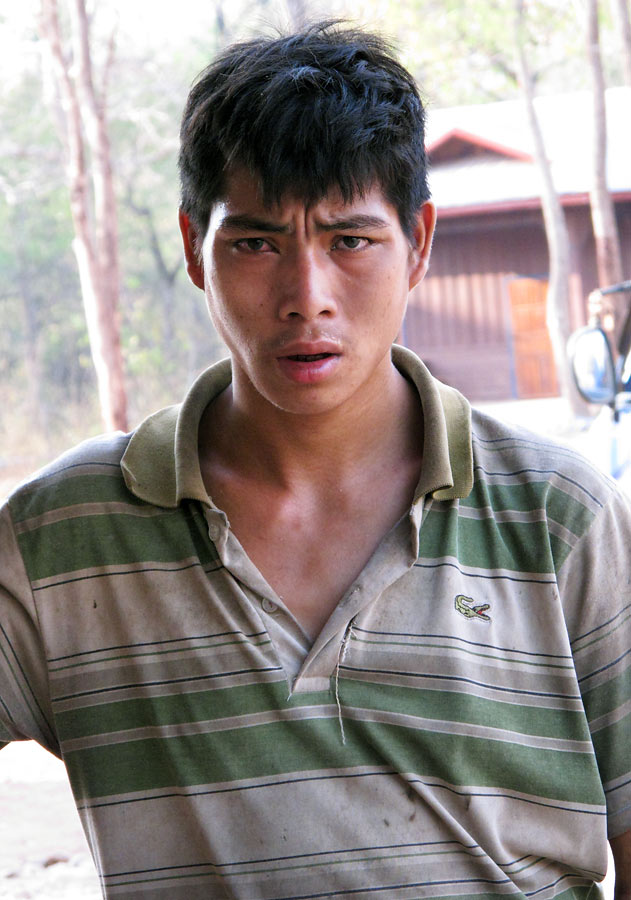
Mouth-open amazed seeing us and a GS.
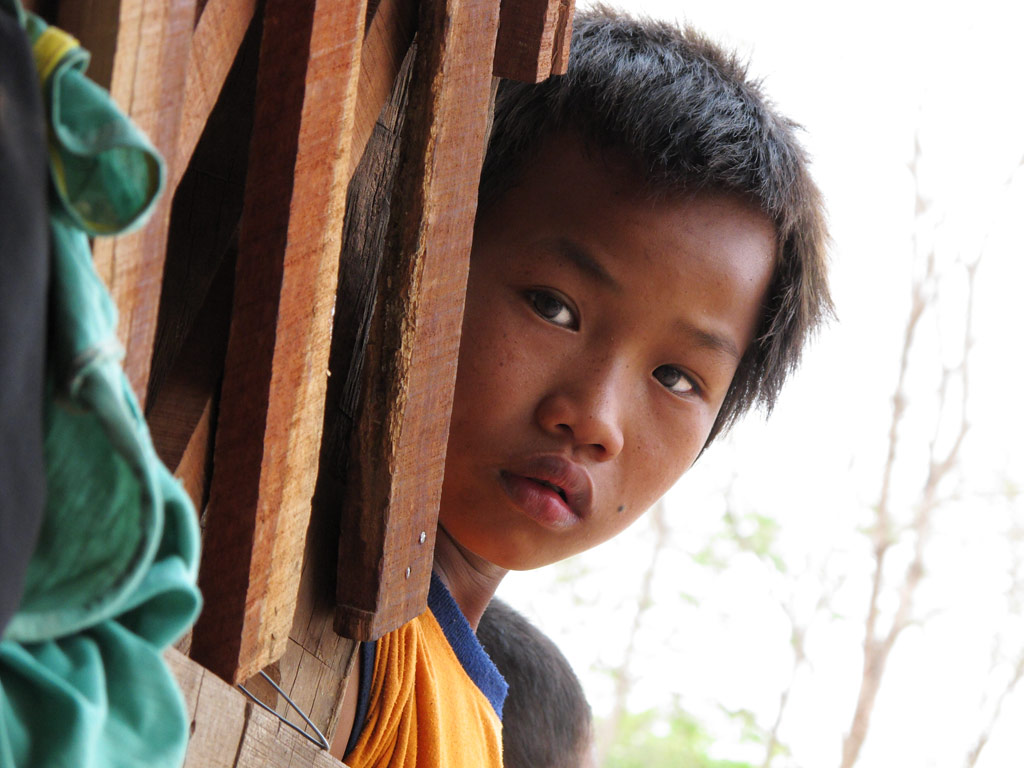
Shy village children staring.
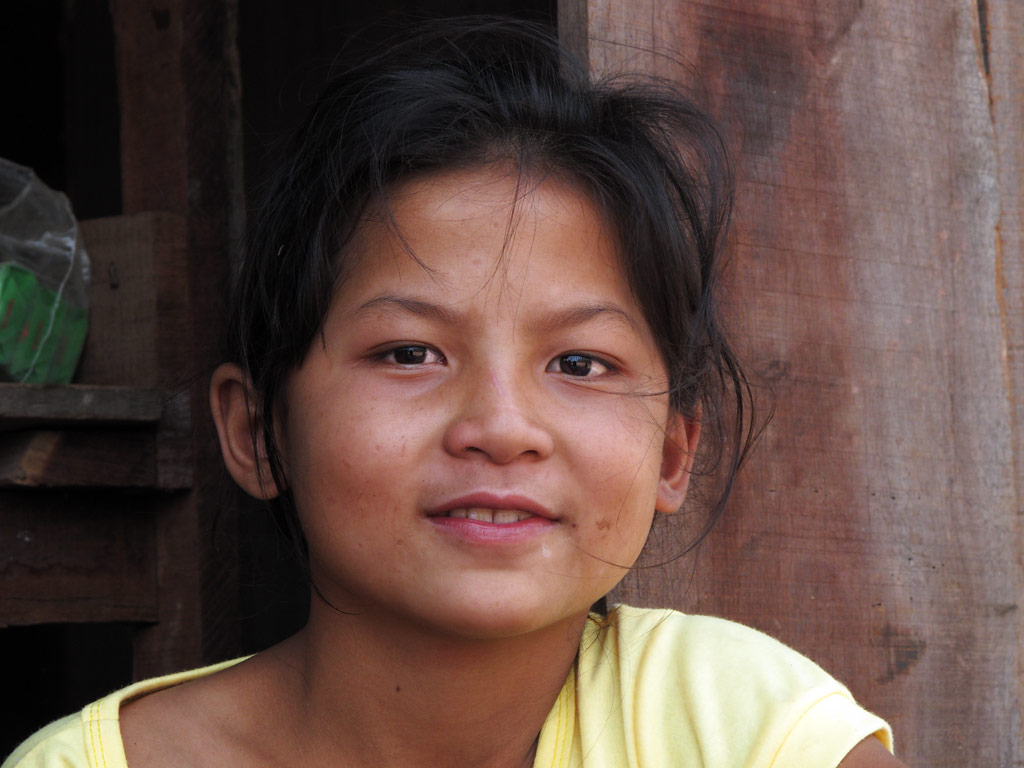
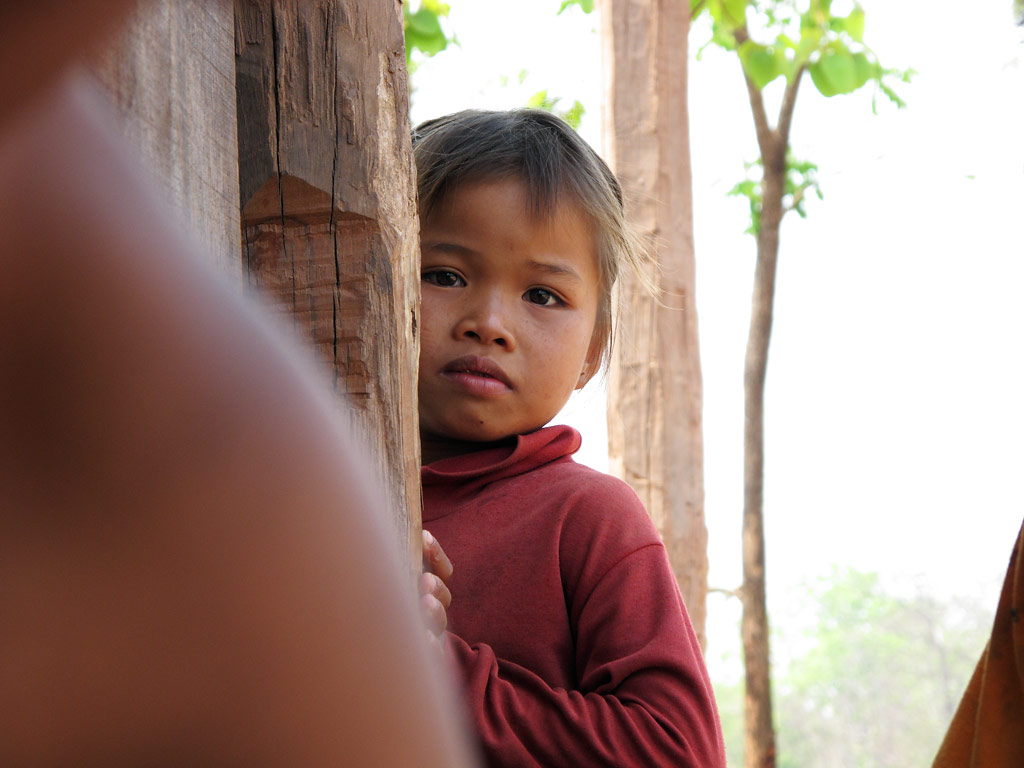
The children did not appear to have any toys, so no wonder they play with whatever they find. One of the boys, for example, took a big bug, and ate it in front of us!
<object width="640" height="480"><param name="movie" value="http://www.youtube.com/v/FUo3Cc-KMTI&hl=en_US&fs=1&"></param><param name="allowFullScreen" value="true"></param><param name="allowscriptaccess" value="always"></param><embed src="http://www.youtube.com/v/FUo3Cc-KMTI&hl=en_US&fs=1&" type="application/x-shockwave-flash" allowscriptaccess="always" allowfullscreen="true" width="640" height="480"></embed></object>
While waiting I decided to remove the rear wheel and determine the gravity of the problem. It appeared that the bearing had been virtually destroyed - there were big pieces of metal. Even the locals could understand by seeing it that the bike was not going anywhere without a pickup truck.
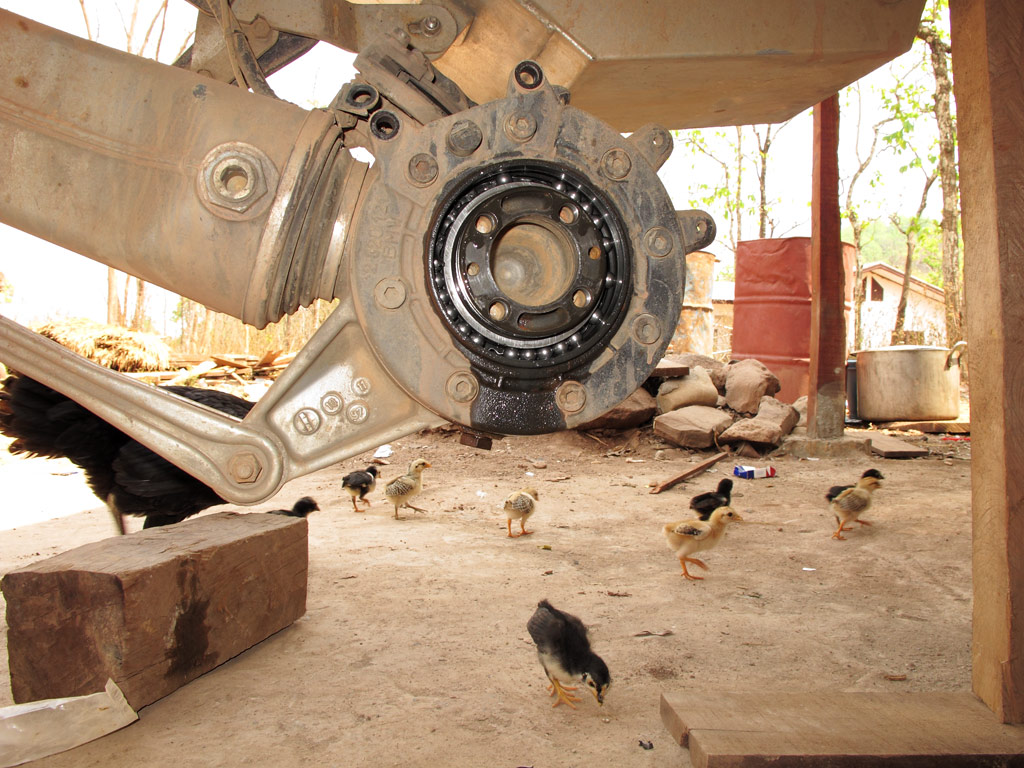
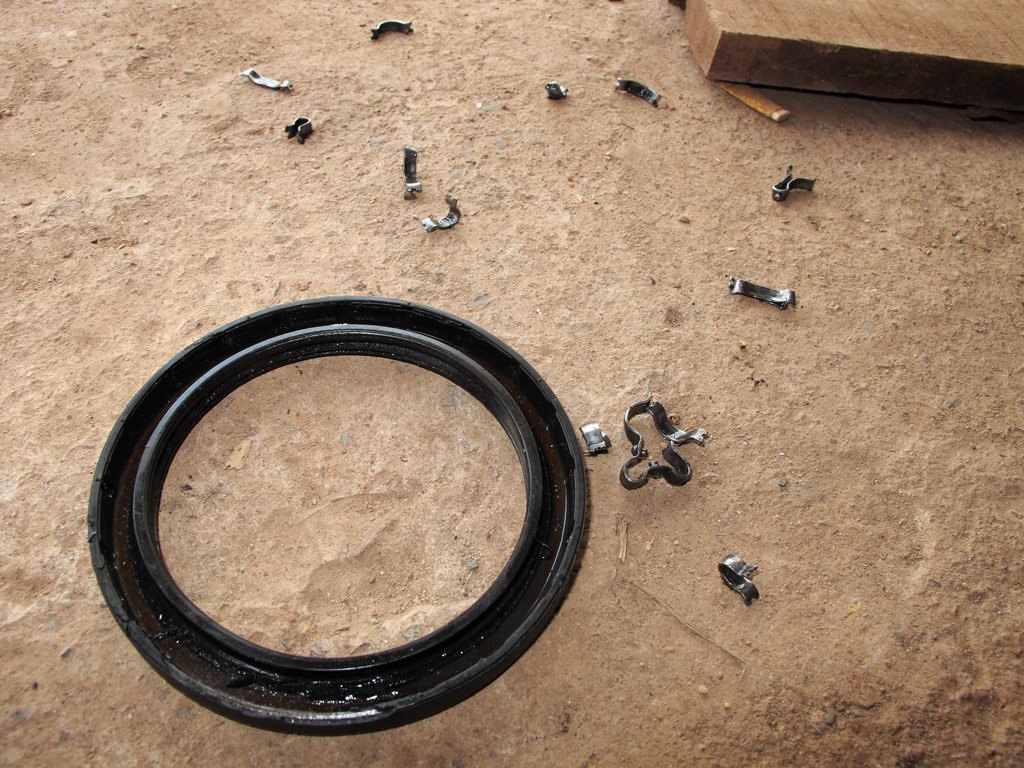
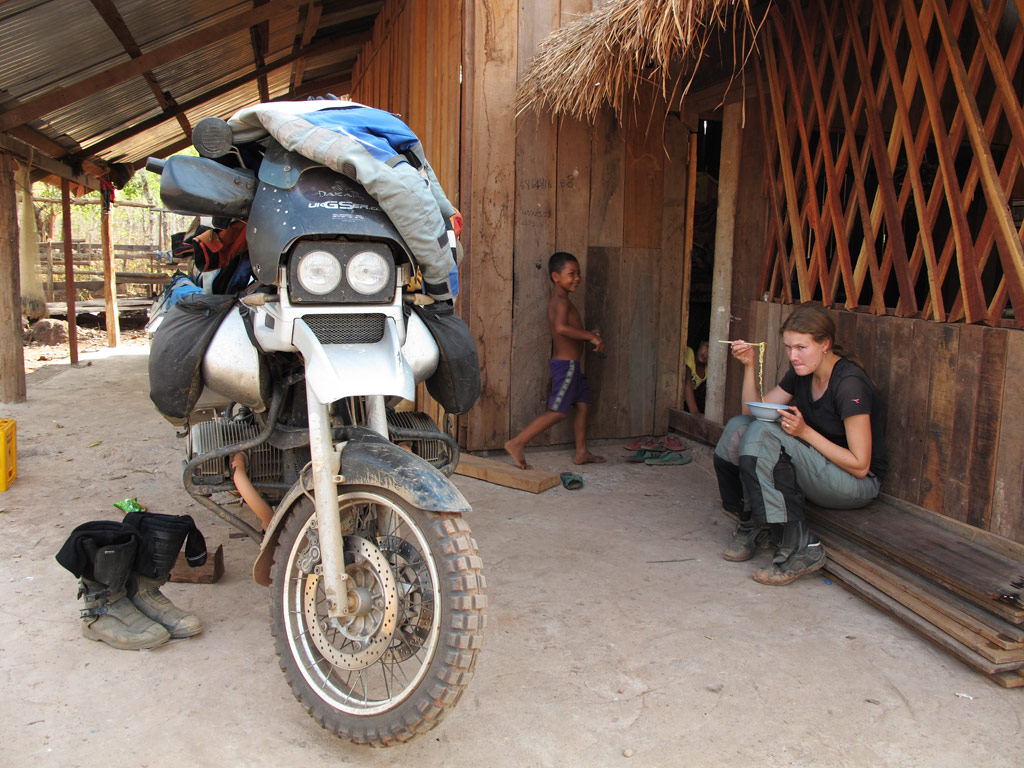
So we waited and waited, and the lady made us some instant noodle soup.
It was getting dark soon, and finally a pickup showed up, going just in the same direction, and for some money, eager to take us and the bike to the nearest village with a mechanic shop. The setting sun saw us bouncing in the back of the truck down the same road we had come.
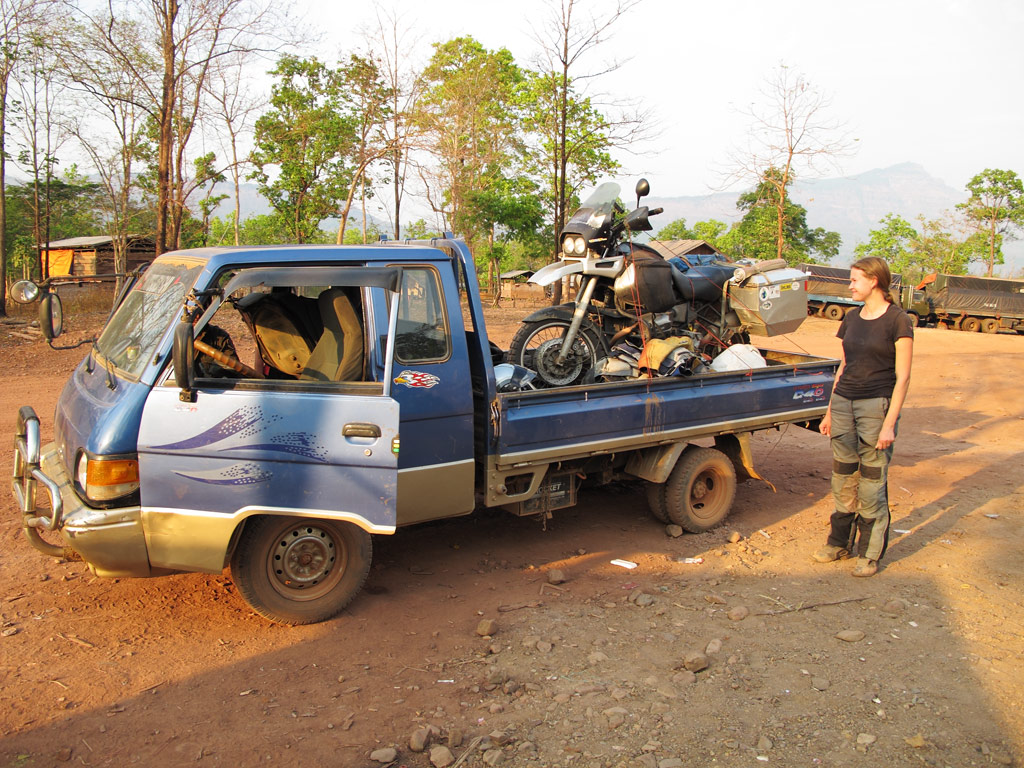
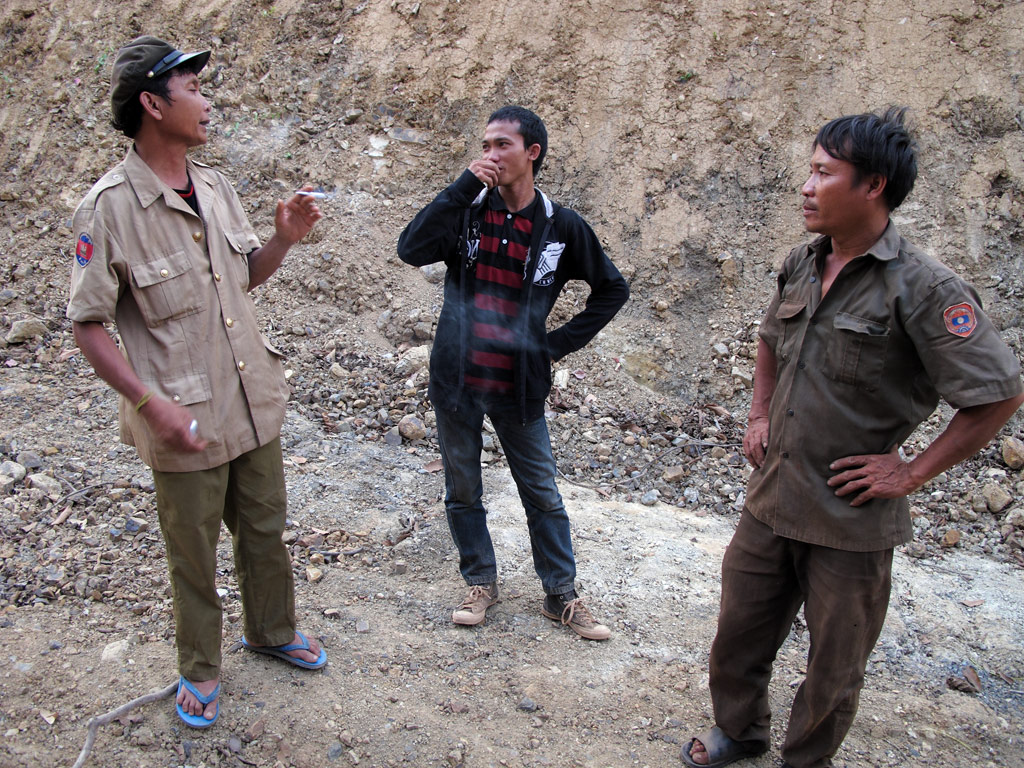
The driver stopped a couple of times along the way to smoke a sigarette with some local chaps.
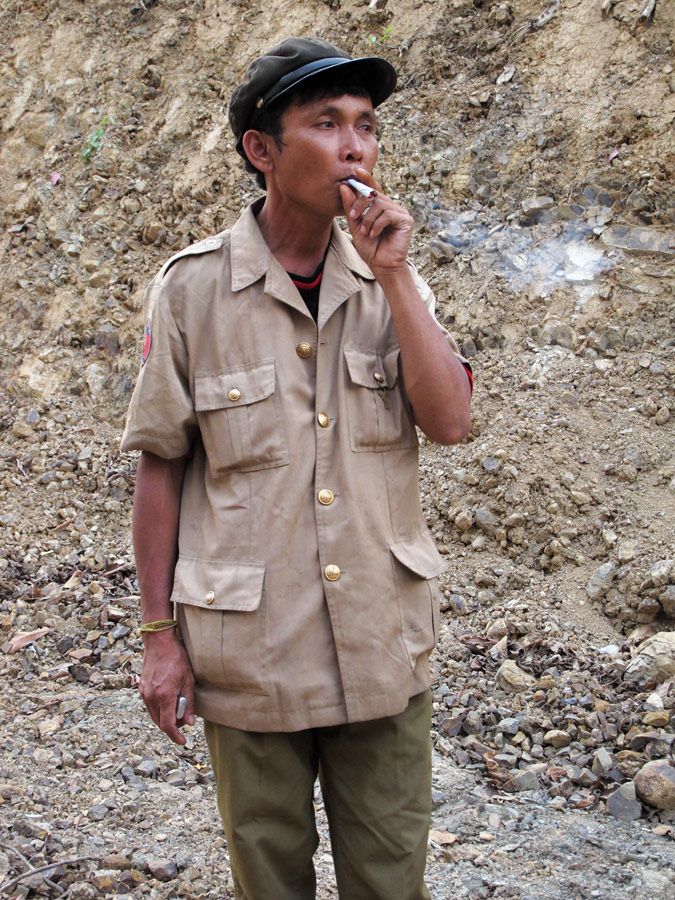
A communist-styled clothed bloke smoking a self-made cigarette.
By the time we arrived in the village it was pitch dark. We were unloaded at some workshop, and a crowd gathered. We could not see if there were friendly faces or not - it was so dark. Obviously it was too late to start working on the bike, so we asked if there was a hotel nearby. We were told that there was, but we would have had to leave the bike in the workshop, with the people we had not even seen. We did not feel to secure about it. Then the owner, mister Ki said we could spend the night at the workshop.
What a relief! After a long day we had ended up in a strange place, but people were kind enough to let us stay near our bike in their workshop. We were deeply grateful, and already started to put our mats on the floor next to the bike, as we were told that we would not neet to sleep on the greasy floor. Instead, we could sleep on the carpeted patio. What a warm welcome from a stranger!
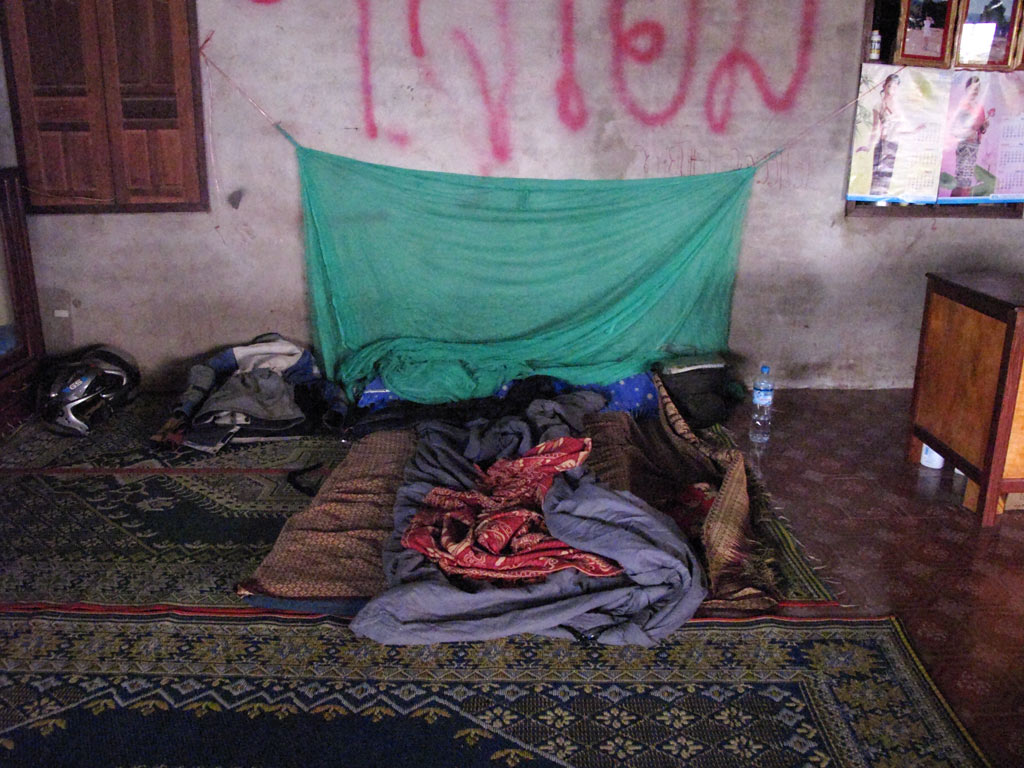
Later on we were offered beer and we were invited to eat with the family. The food was truly simple, but it tasted delicious.
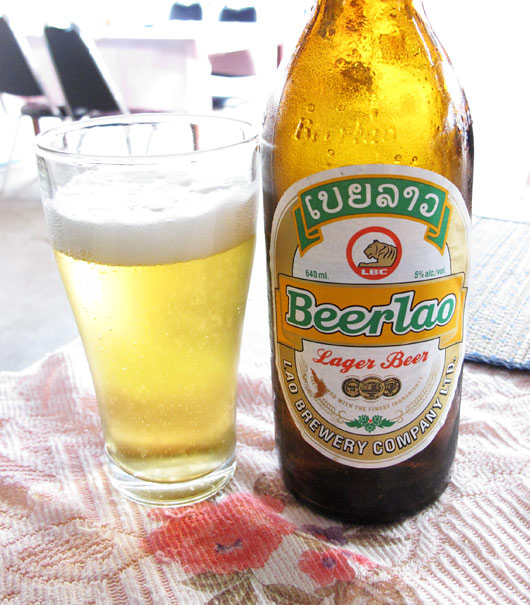
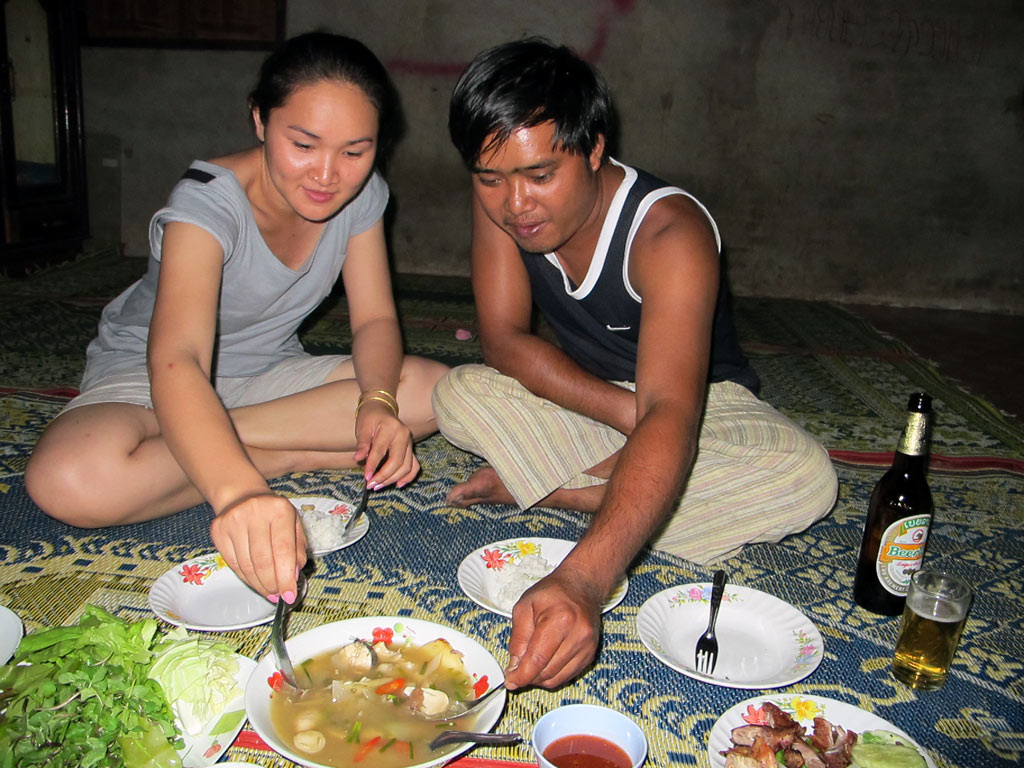
Ki and his wife.
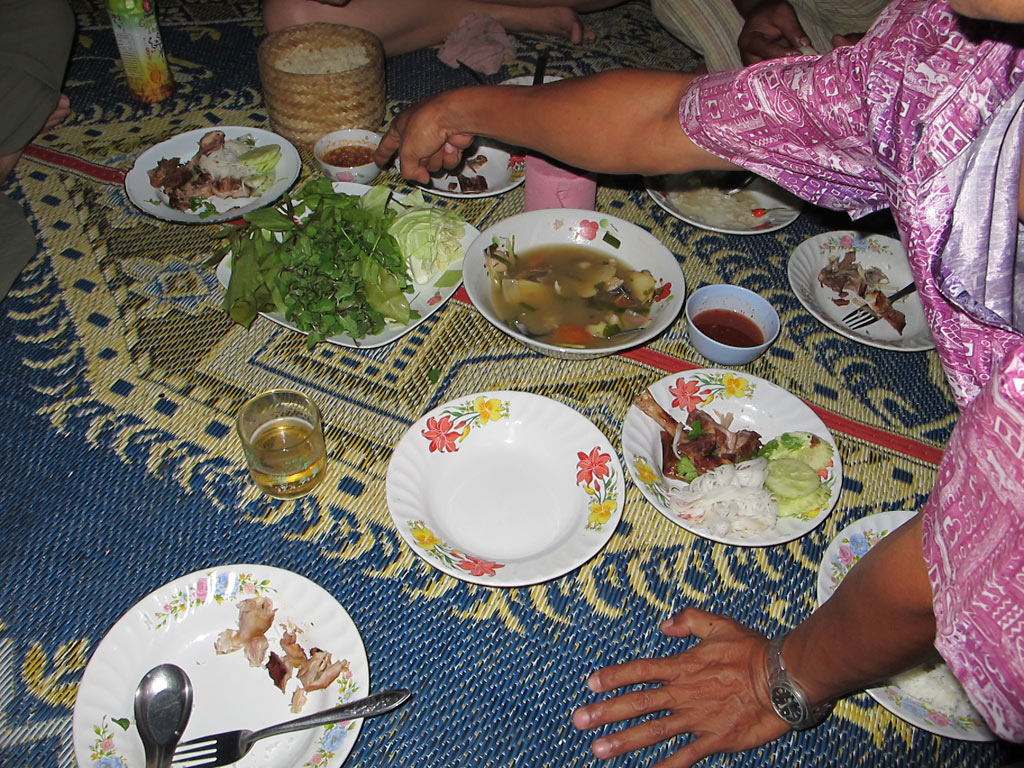
The next day we woke up early. The women strated boiling rice at five o'clock in the morning, when the sun had not begun rising yet.
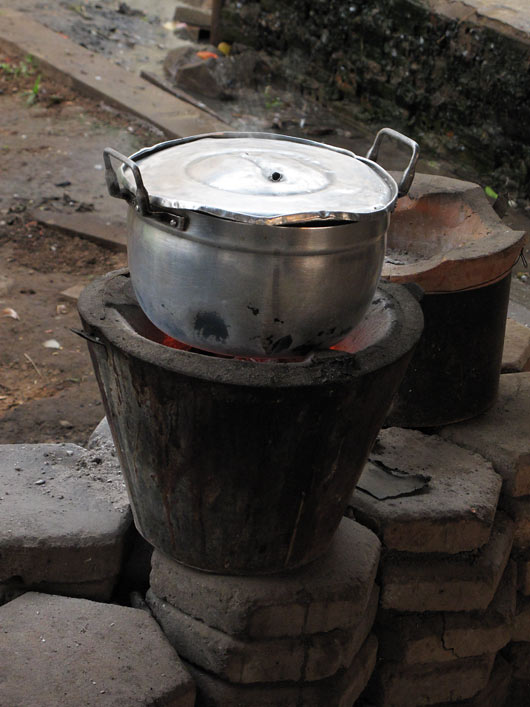
Once I got my hands on the GS with a good toolset, repairs went easy and swift. An hour or two. I used our camping cooker's burner to heat up the bevel box to open it, then additional heating for removing bearing was the biggest task. First I tried kicking it out, only got it moving barely, but then Ki came up with an idea to use his hydraulic lifter to remove the bearing once we kicked creative support bars between the shaft and bearing. Then heat up the casing again, mount it back on and we're good to go.
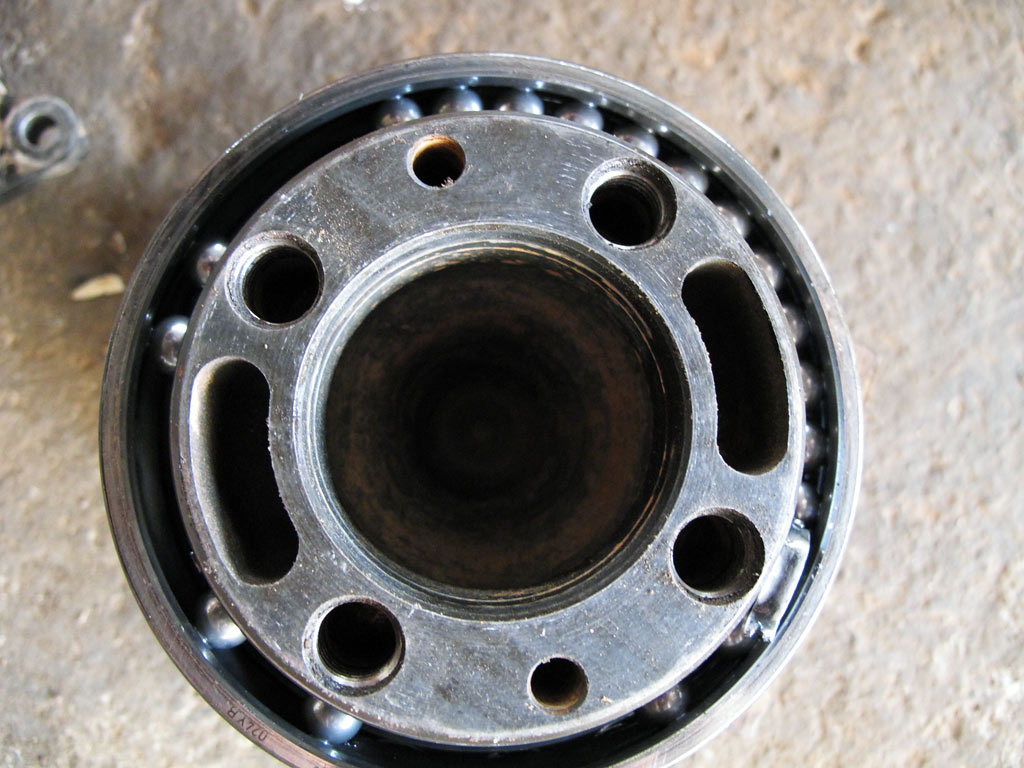
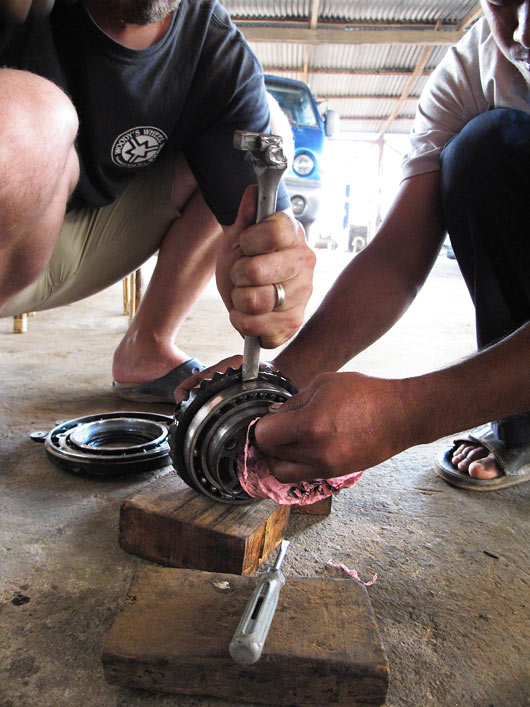
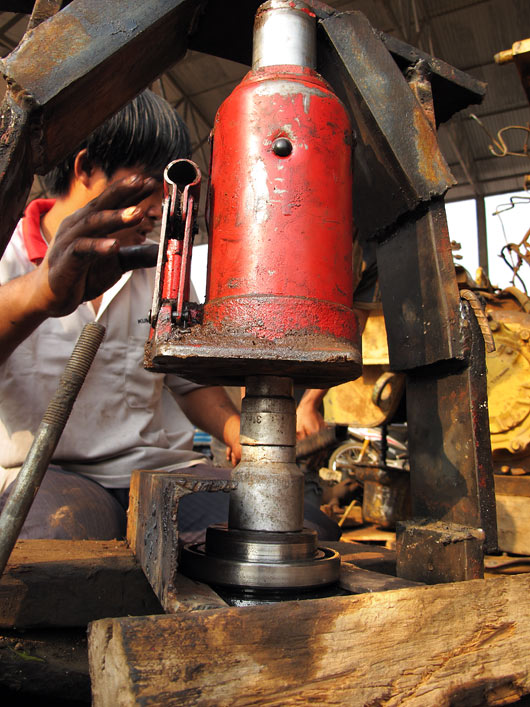
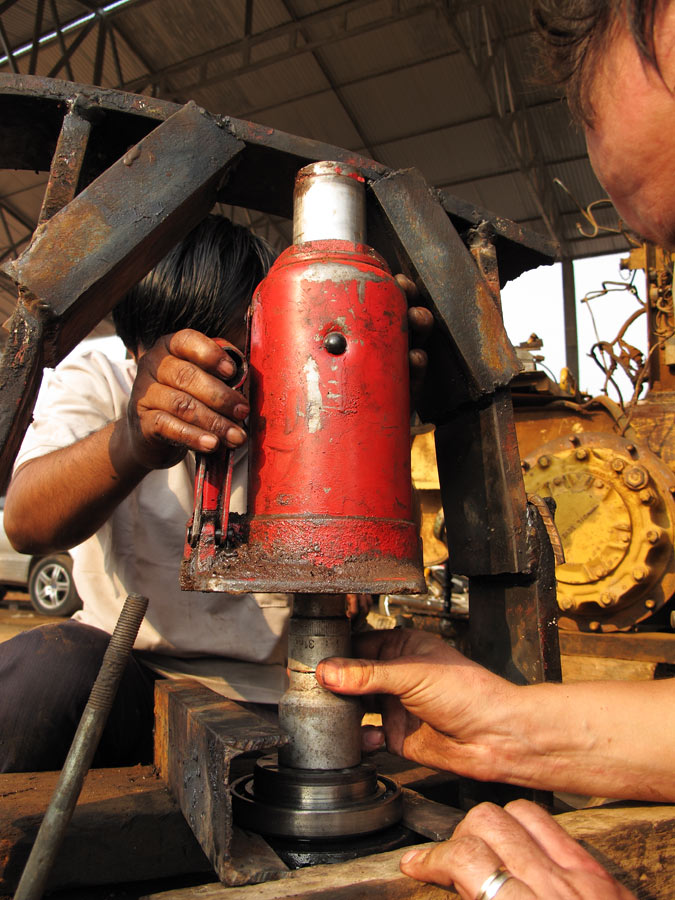
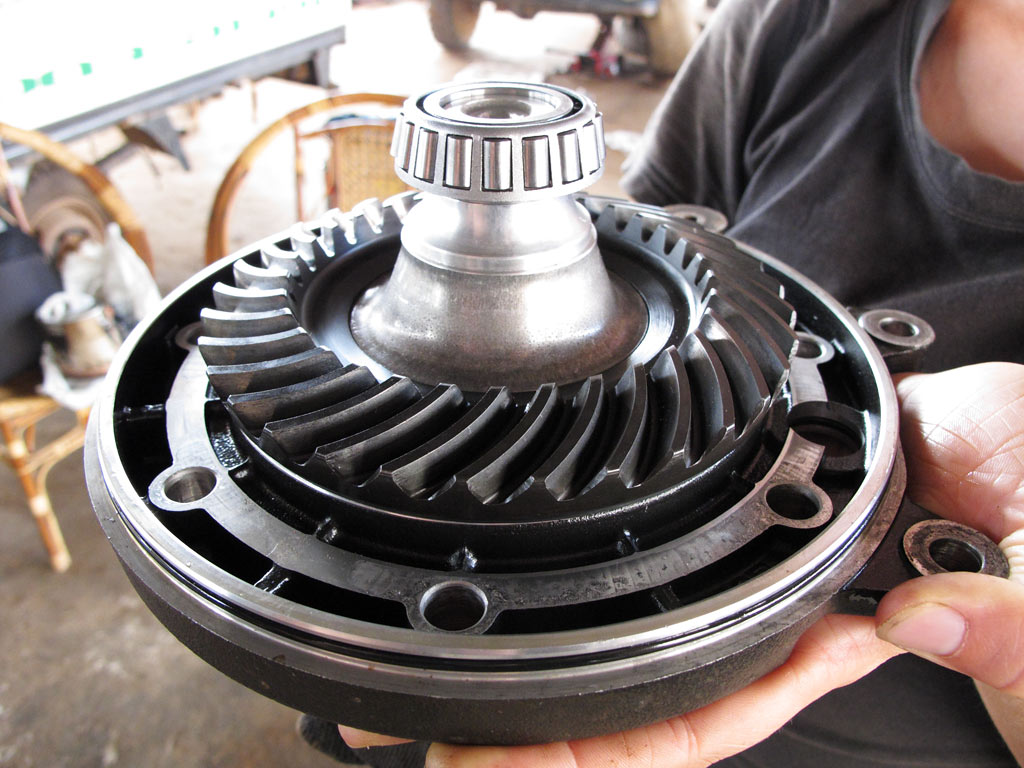
New bearing inside.
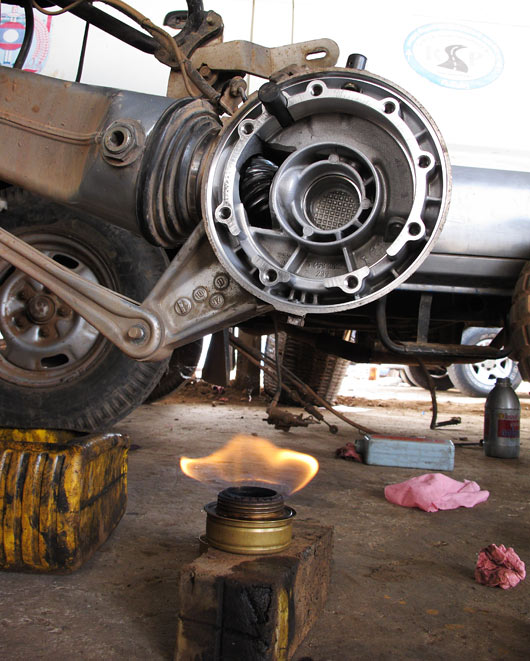
Heating up the casing to have an easygoing installation.

Ki's workshop panorama where I worked on my GS.
On pictures the job may look complicated, but it's very easy, especially doing it the second time - in fact if I compare the spent time of replacing final drive bearing to the time needed to change a chain and sprocket set, maybe just a bit longer job but not much. Lots of readers may now wonder, chain vs shaft? I'll put it in my personal way: carrying bearing+seal set takes 3 times less weight and room than carrying a chain and sprocket set, costs 1/3 of the chain set and lasts over 50 000 miles under abusive use, while I've never gotten much more than 12 000 miles out of a top quality o- and x-ring D.I.D. chains on my chained drive bikes that I've owned while carefully cleaning and lubing chain after every 300-500 miles, every day when it rains and frequently checking tension. With shaft drive I don't have to clean and lube it almost every day (I don't like automatic oilers since mostly I'm riding in very dirty/dusty conditons), adjust it, replace it, I don't have oily wheel and boots every day and my hands are clean every day. So in case you're wondering - despite the tendency of bearing to blow around constant 50-60 000 miles under our abusive use in third world roads, doing occasional real offroad 2-up that very few do with such a loaded bike, the shaft drive still is a winner for me! Would even be a winner if I had to replace the same bearing 18 000 miles. If it'd constantly last less then that, maybe then I'd consider to live with the hassle that comes with a chain drive in our mile-munching journey - our GS has 112 000 miles on odometer - how many chain sets would that be if I'm not easy on throttle and maintain the chain while on the road? For short journeys, chain drive would do fine if I have home and a garage to frequently maintain it.
I suppose I could have done it aside the road too using exhaust pipe of running bike on center-stand to get the extreme heat needed to remove the old bearing and heating up the new one on mounting in a very robust method, but looks like the decision to find a workshop and do it clean is a living proof of the old saying among the very experienced motorcycle travellers (NOT the inexperienced holiday travellers, who expect everything goes smooth): Interruptions are the journey.
Without coming here and meeting up with Ki and his family, we'd never learned about Laos culture and people so deep and wouldn't had made friends.
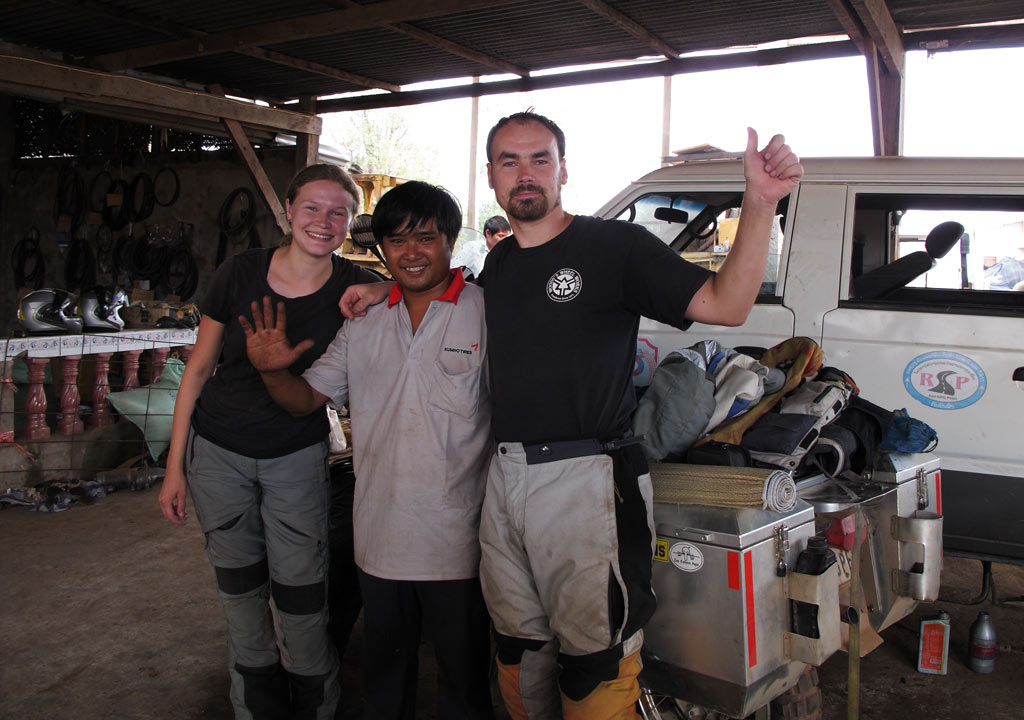
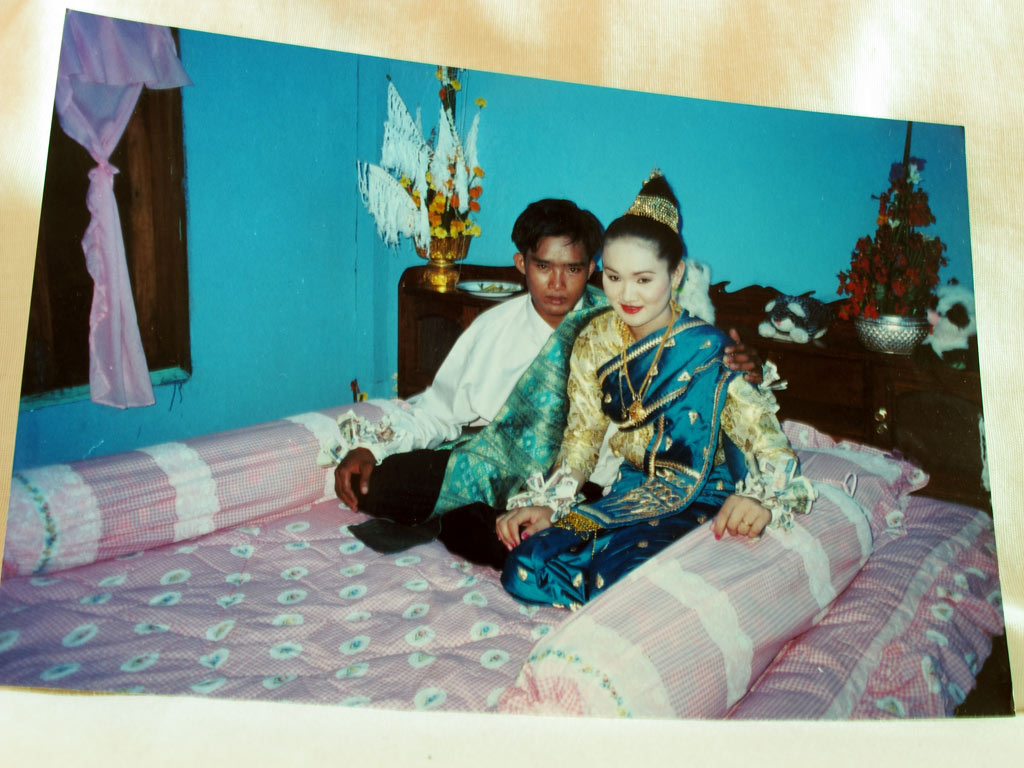
A happy ending pic and Ki gave us a pic of his wedding day - a symbol that we really were a part of the family now.
With fresh bearing in our final drive it was the right time to take more risks and head for the really bad roads to kill the bike!
Started off riding small roads in Boli Kham Xai and Xiang Khoang provinces that rarely see tourists. And no tourists without the reasons - first of all the roads are just murderous for your vehicle and it is one of the most densely mined areas (be the Americans during Vietnam war) of Laos, so it's extremely inadvisable even to go take a pee couple of meters off the road.
We've never seen so many river crossings (here: without the bridges, obviously) during our expedition. We did well over 10 river crossing per day, some were easy, some bloody hard and deep water while riverbed consisted of big rocks - this is not a place to fall off the bike since the running engine will suck water inside immediately and there's no help coming - very few traffic goes around other than few locals with their small Honda Cubs going very slowly not to kill their precious vehicles in those conditions.
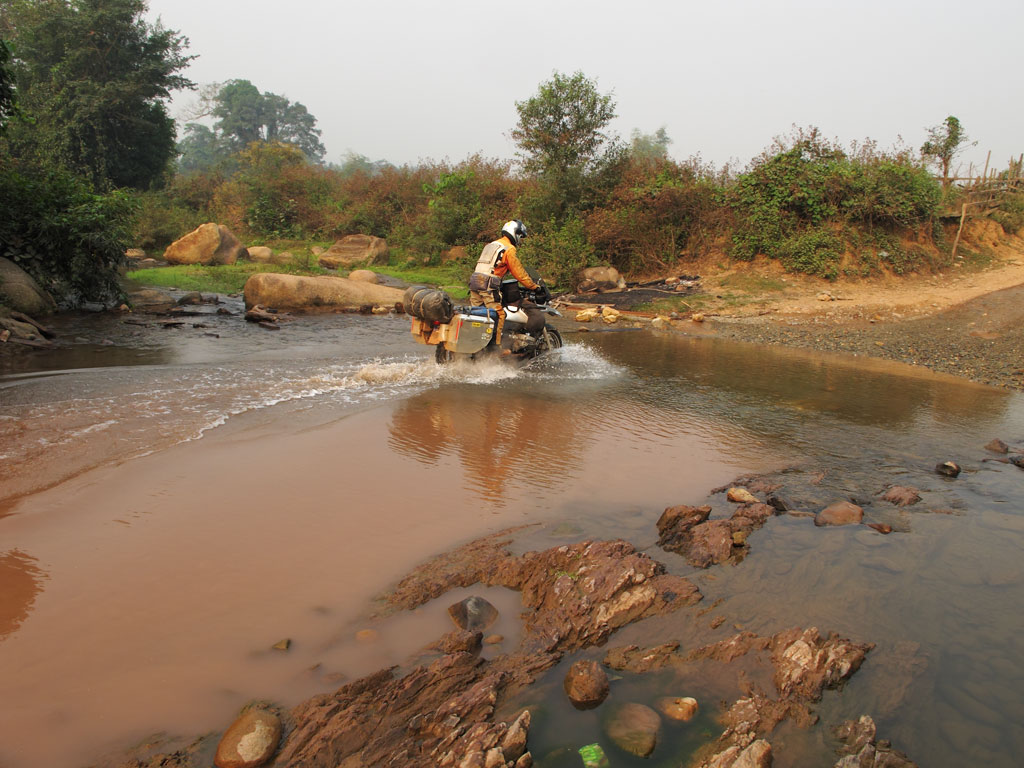
An easier rivercrossing in Northern Laos.

Road ended in the river and didn't continue on the other side - we had to ride inside the river for some time to catch up with the road again.
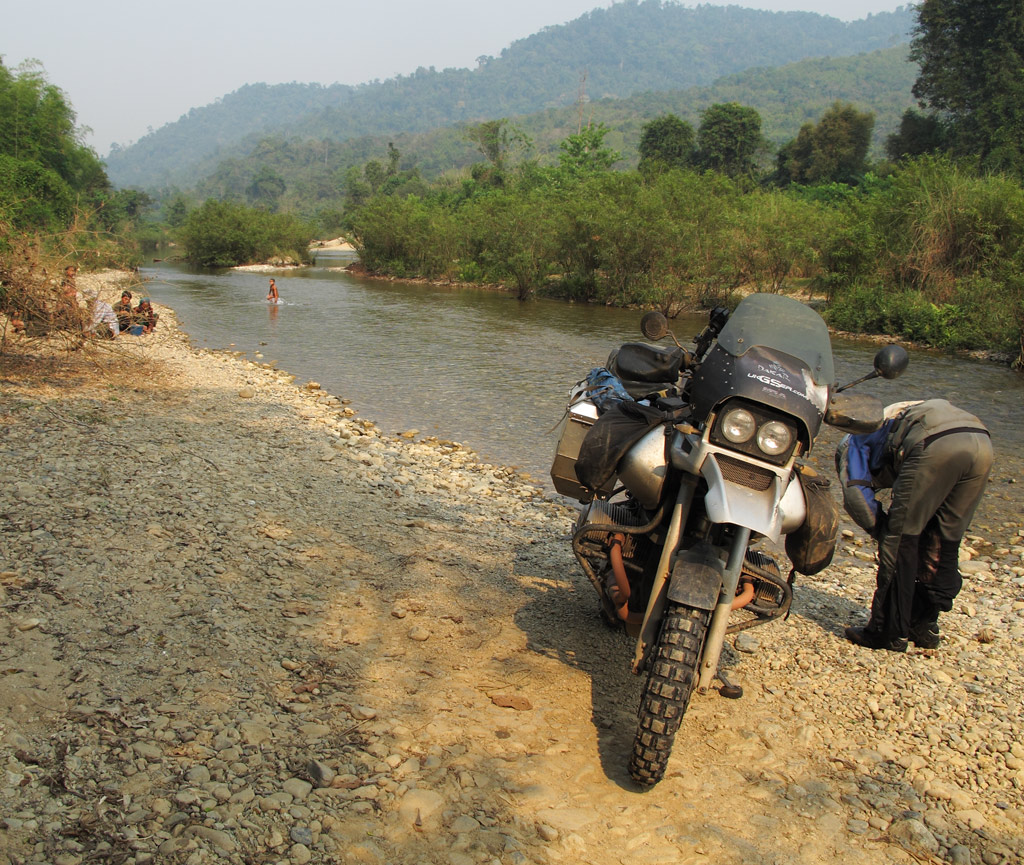
Another river crossed and time to pour out water from our boots.
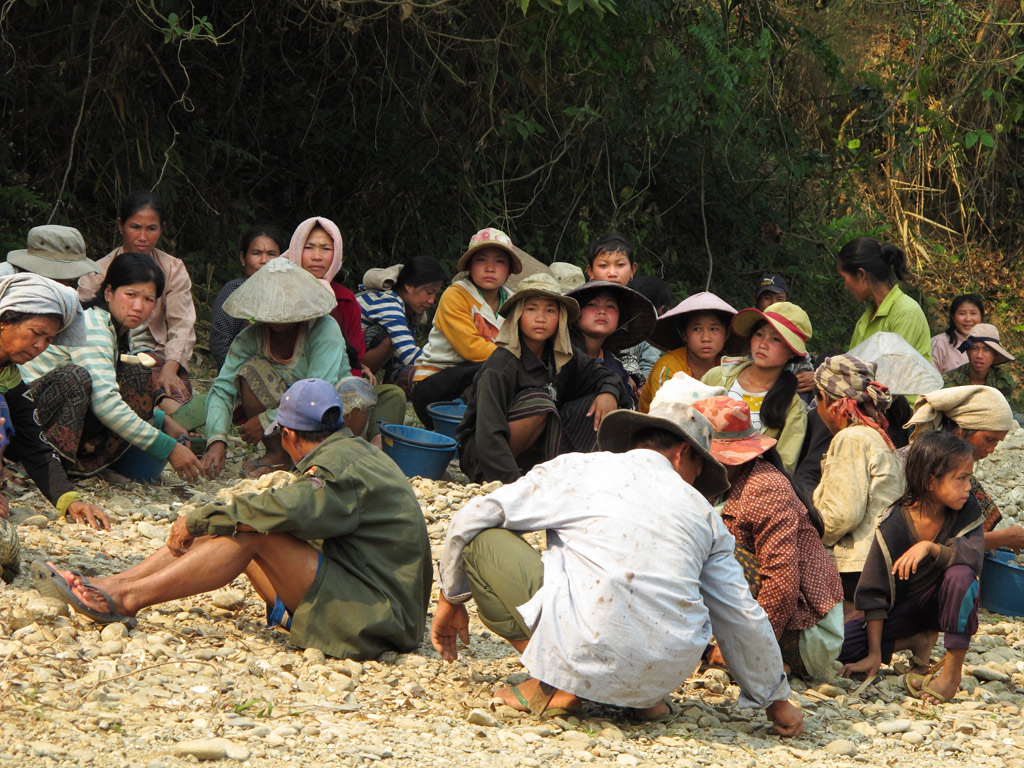
By some rivers locals were collecting rocks - don't know what for. But those locals were special - they saw me crashing while crossing the river, but as this picture shows, those ones did not laugh. :huh
The landscapes had something primeval to them. Laos stands out from the South-East Asian crowd as the country with the biggest percentage of unexploited land, i.e. pristine forests etc. That, of course, is not solely because of a good environmental management, but more due to the amount of unexploded ordnance still lying around. It costs lots of money to clear the land, and only after that can it be turned into profitable land. That said, we could still see trucks hauling huge tree trunks along the roads - it is the timber going to China in exchange for constructing roads in Laos. And let me tell you that, there is massive road construction going on right now in Laos!
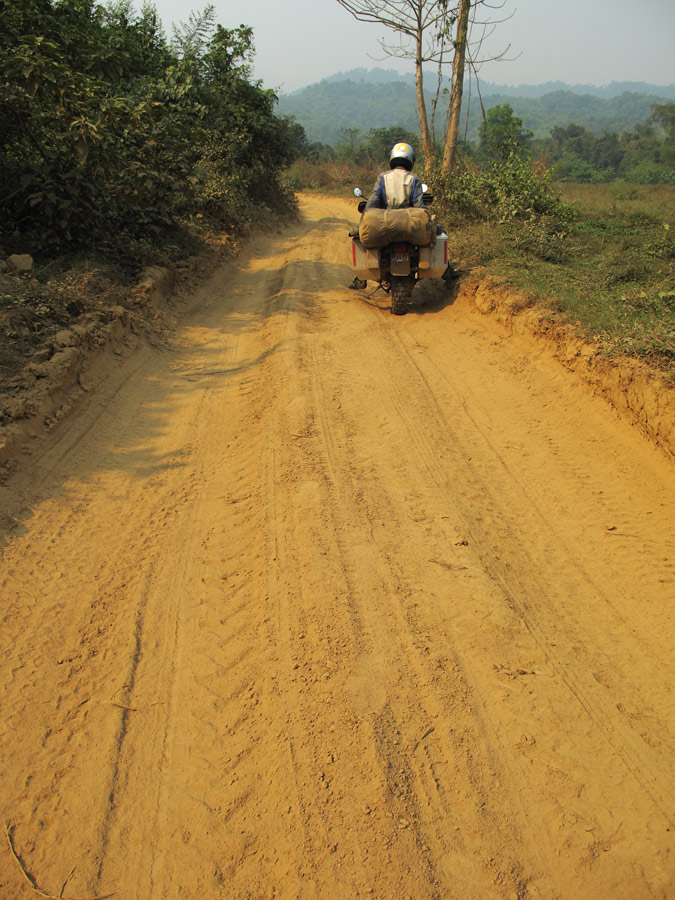
Yes, that's the current MAIN road. It'll change soon with Chinese already working on Laos roads.
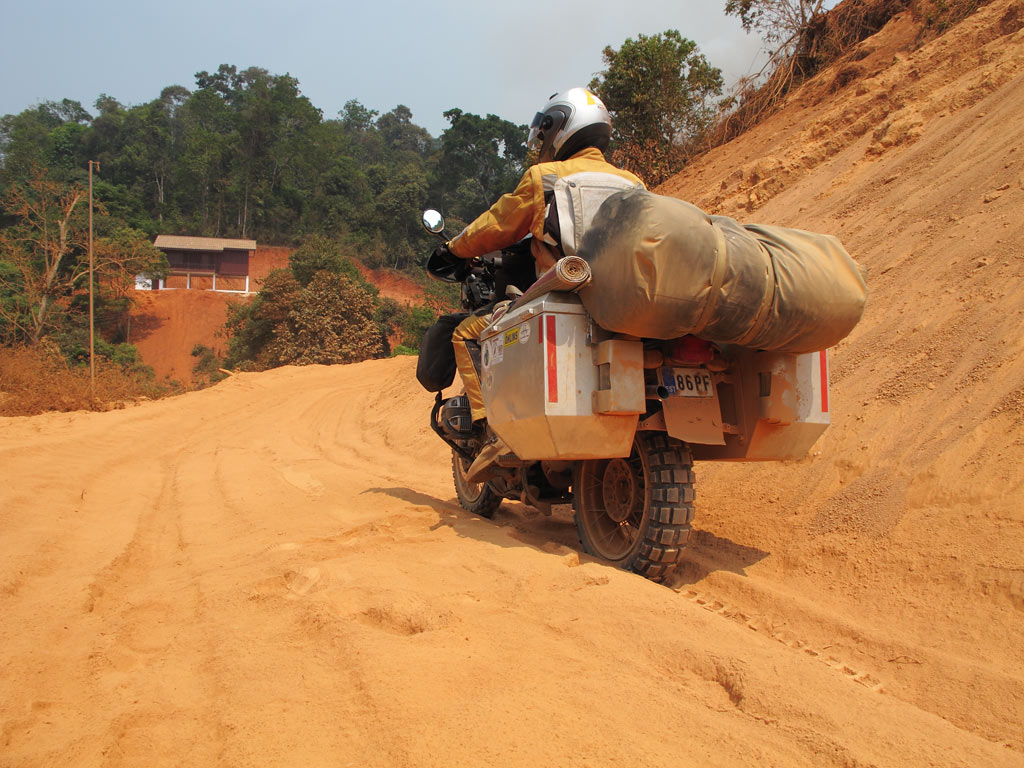

Click to enlarge panoramas.

Another problem here is the tradition of slash-and-burn agriculture that destroys the old growth forest and fills the air with smoke.

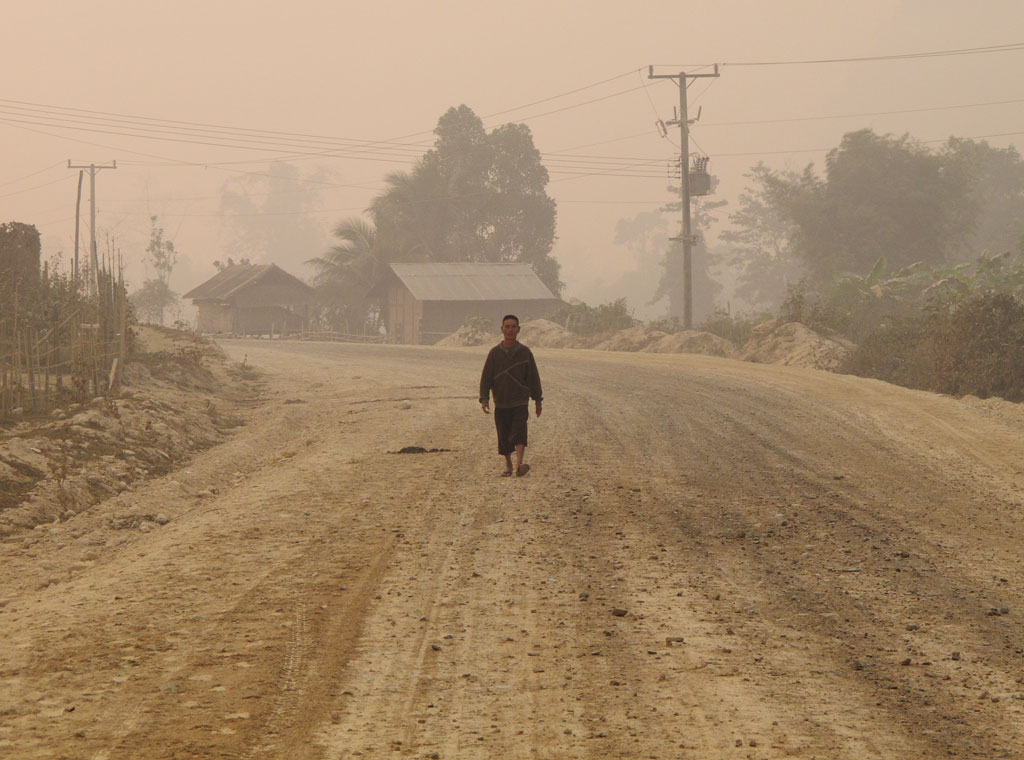
In fact, there is currently so much smoke in the air that even when the sun is up high, it is still red coloured, and everything looks very early morningish.
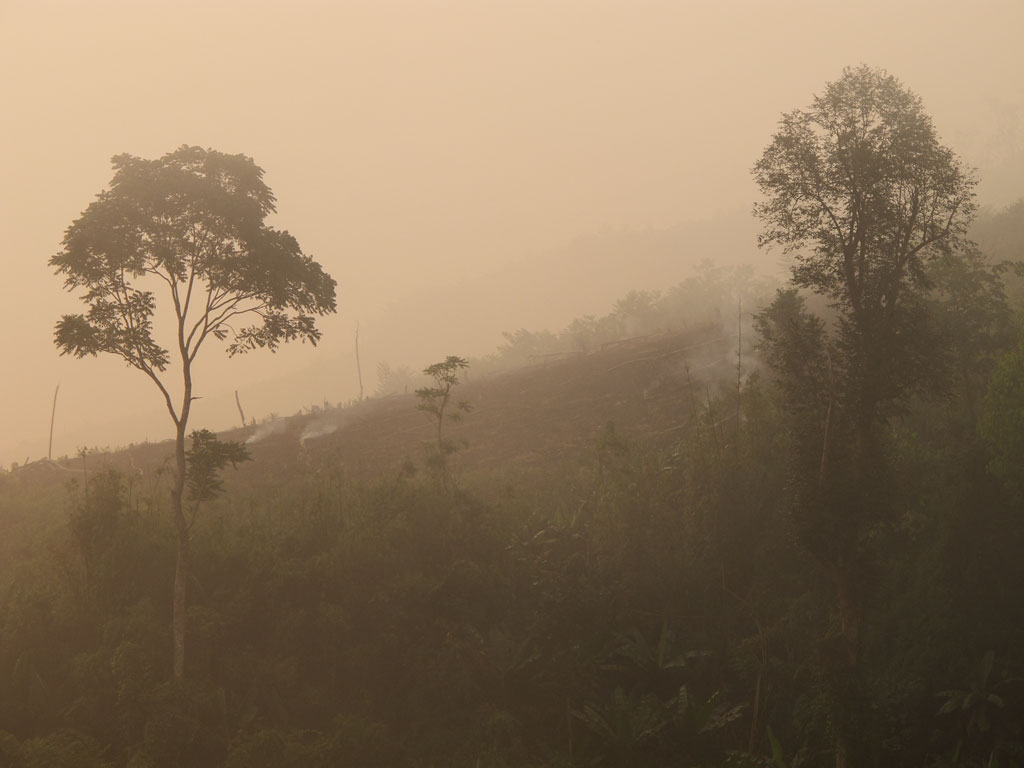
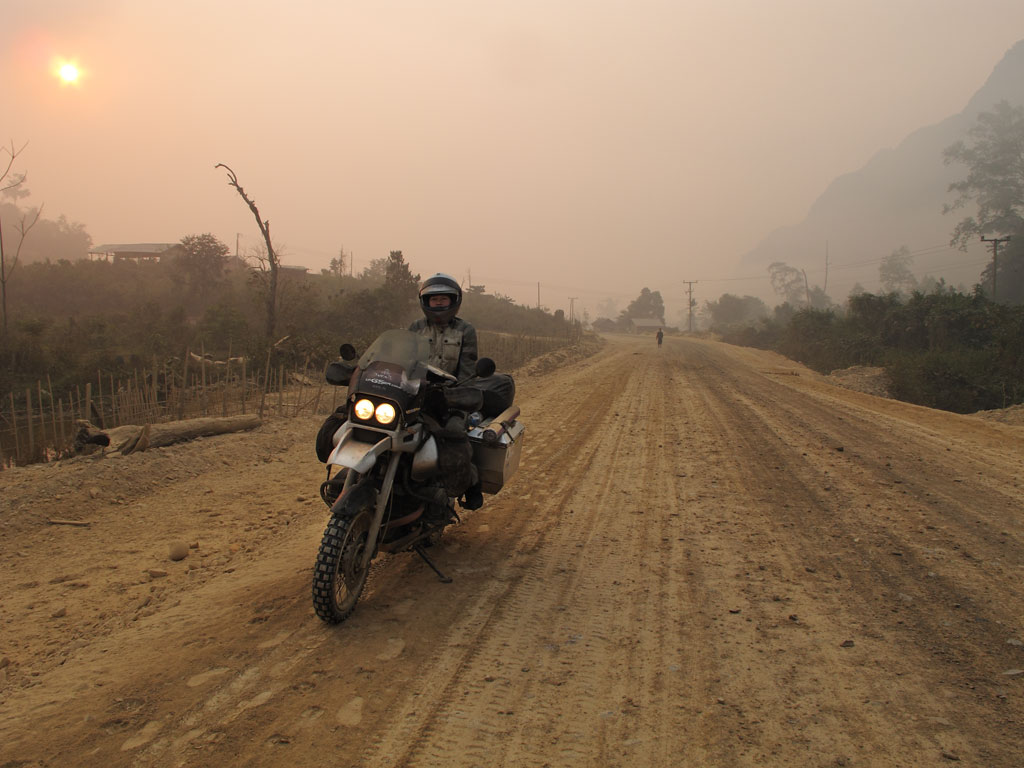
Through this mystical mist, we passed quiet villages, where hundreds of little hands waved to us, and where we were stared at just as if we were from another planet.
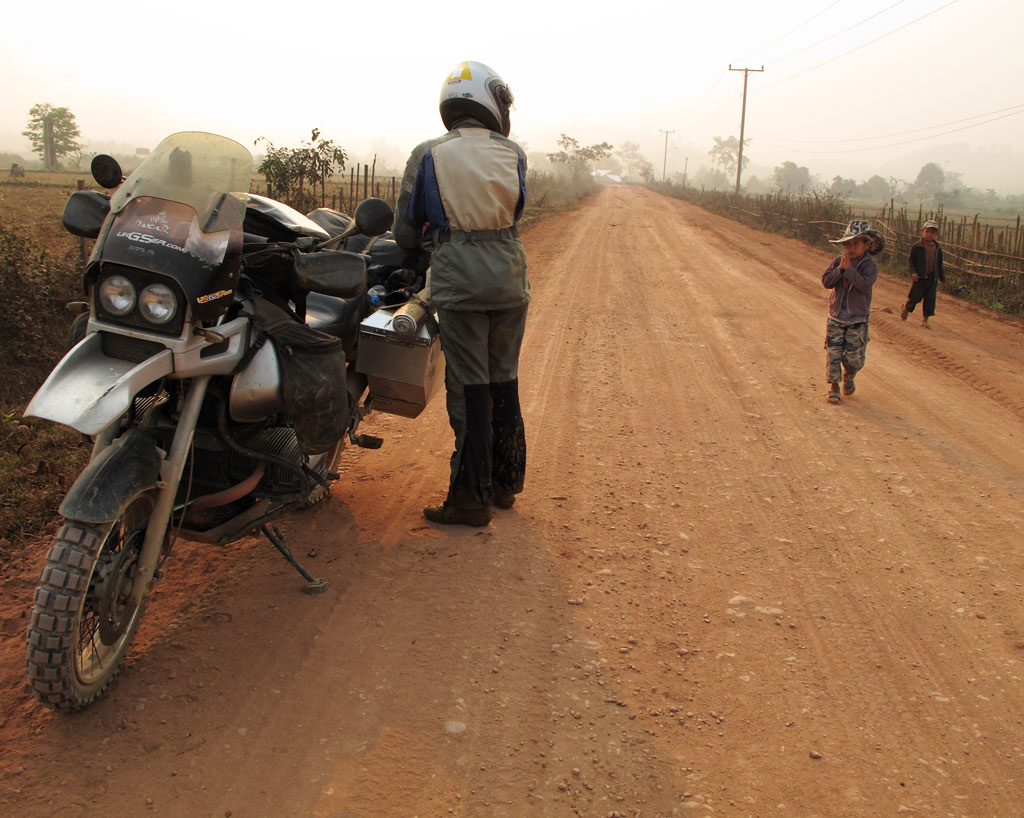
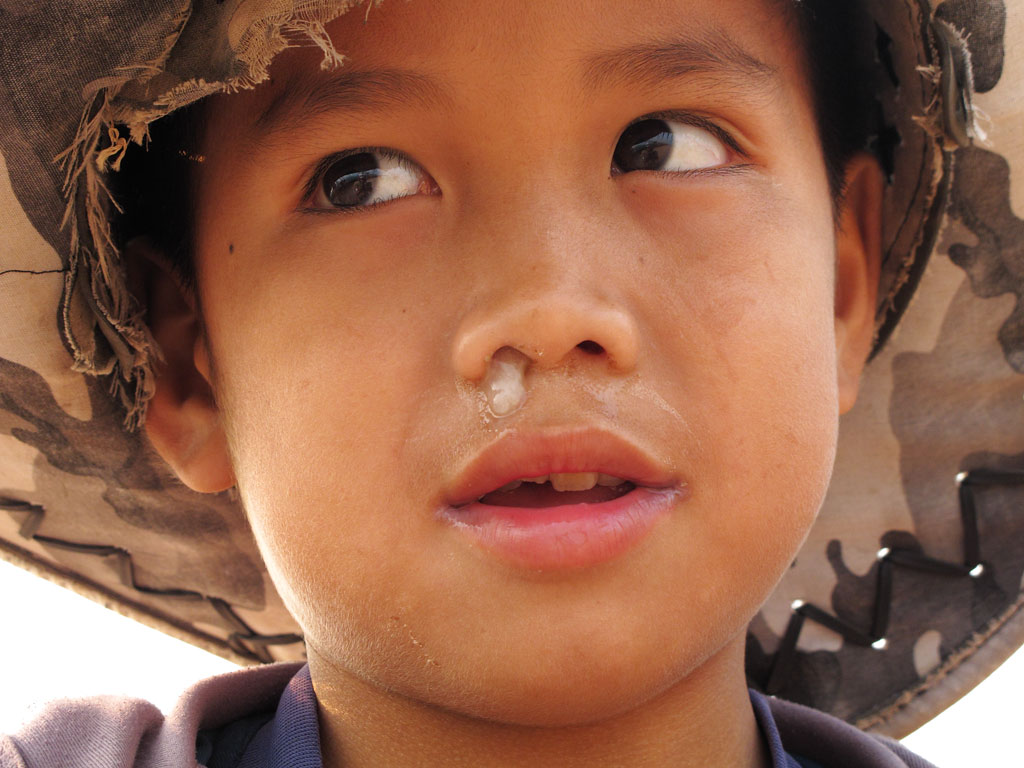
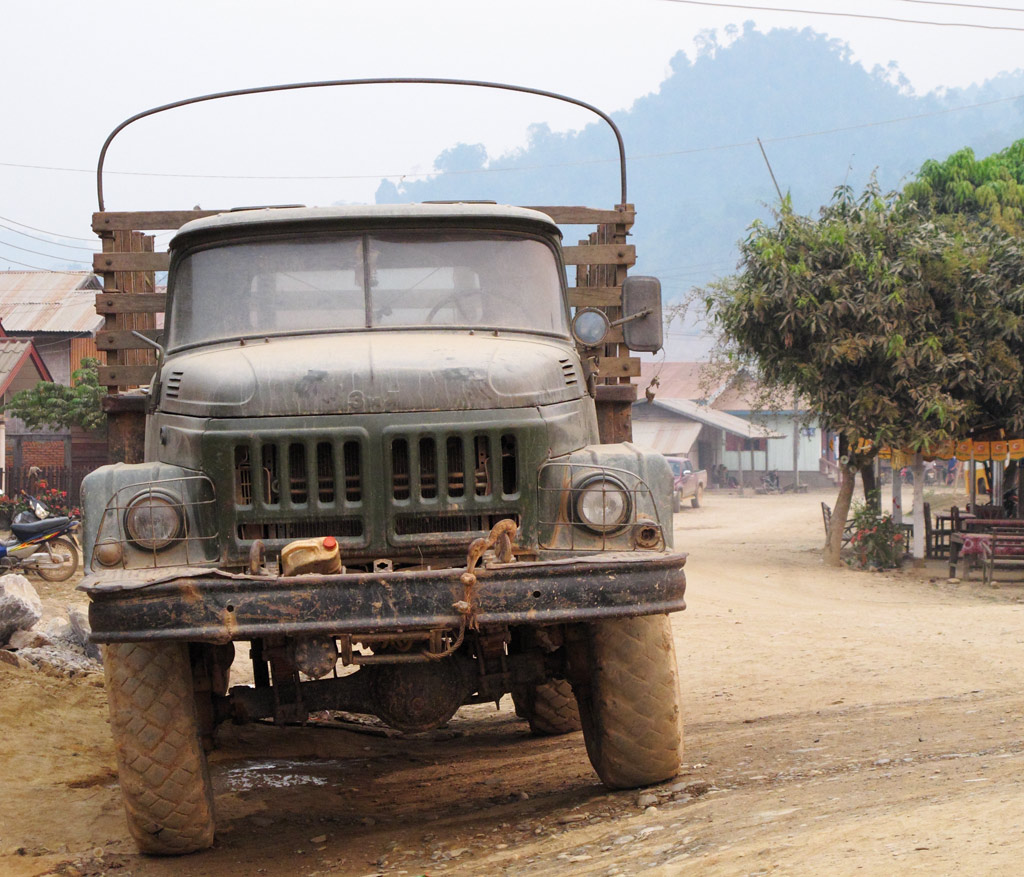
There's a lot of ex-Soviet military purpose equipment in Laos.
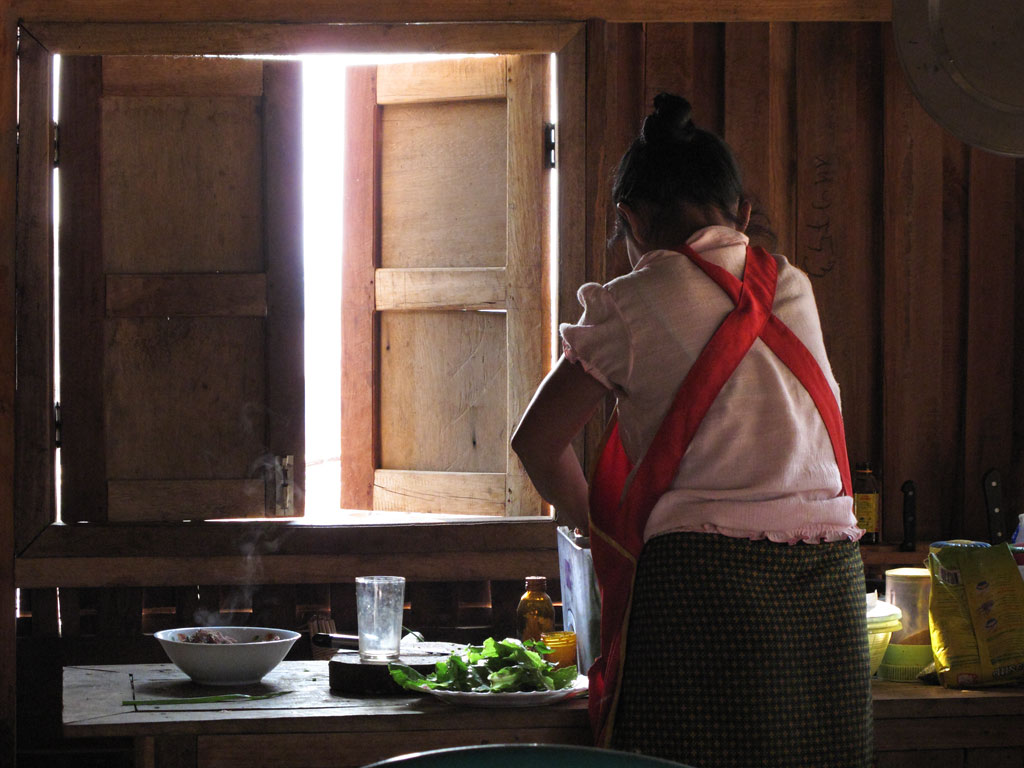
A woman in the village cooked a superbly tasting noodle soup for us.
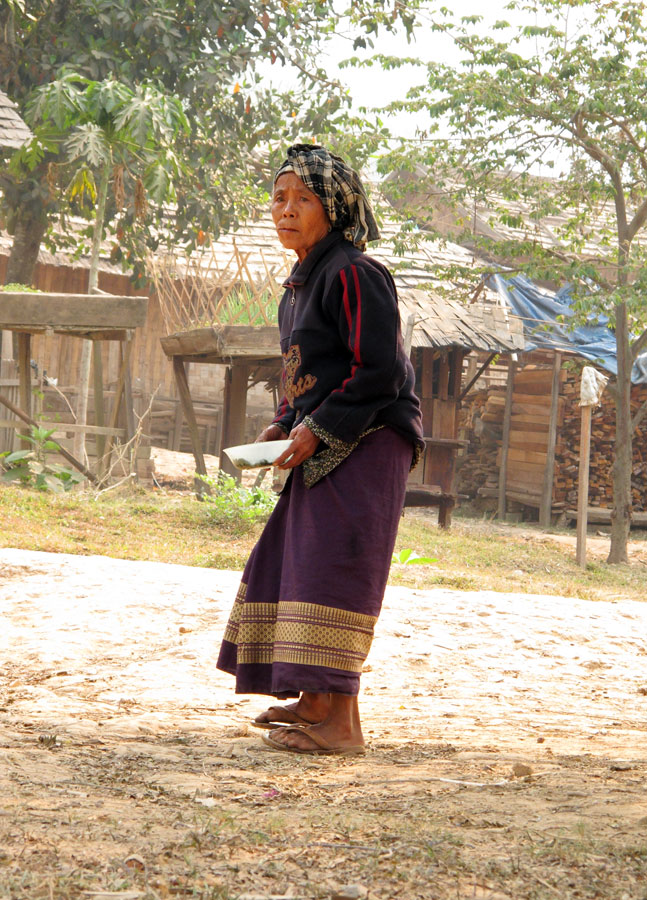
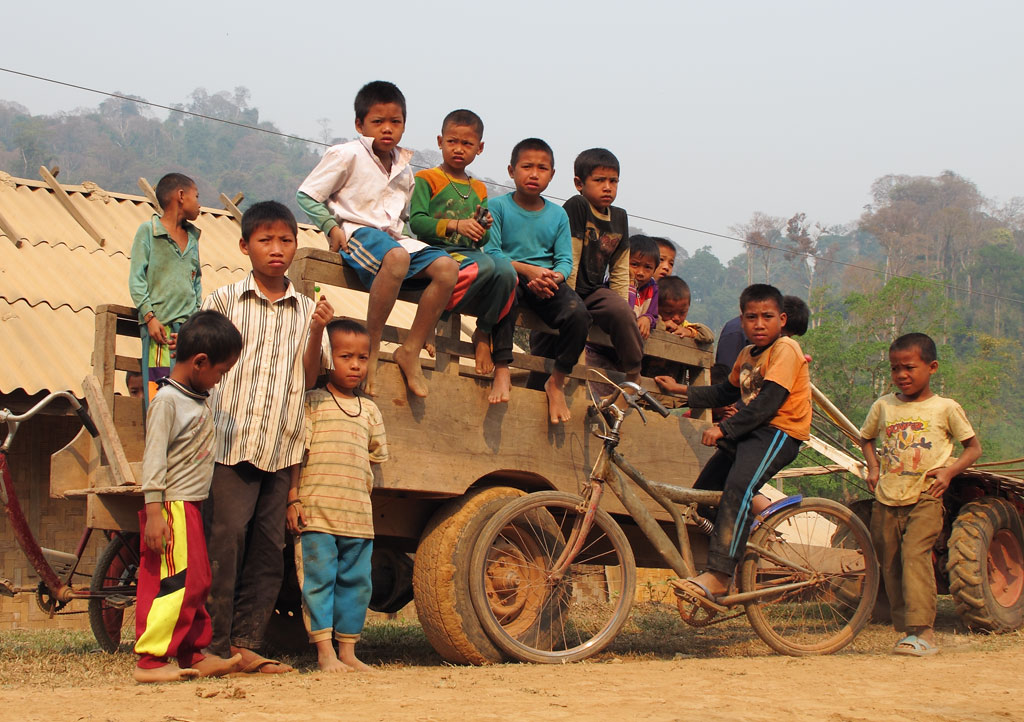
Village boys were so curious, inspected our bike carefully from the distance, yet were shy enough to come closer.
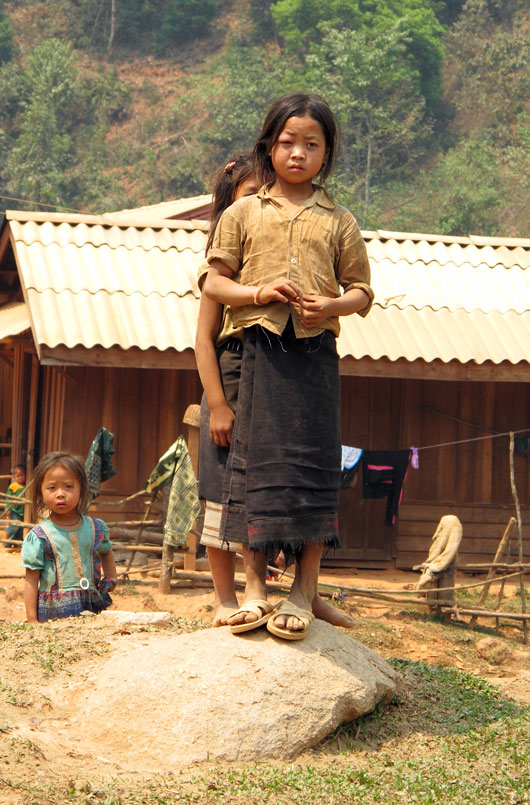

Click to enlarge panoramas from the Laos mountain-villages.
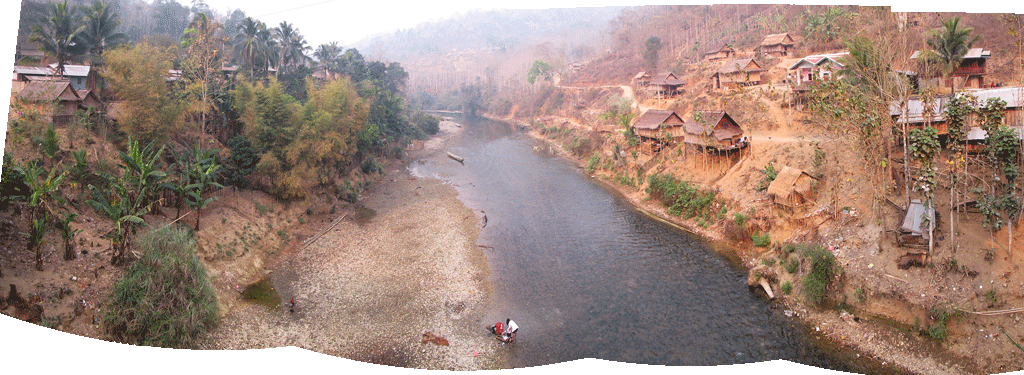

Until we arrived at the even more mystical place - the Plain of Jars. No one knowns for sure who made those jars or fr what purpose, but some archeologists believe them to be part of burial rituals of some now extinct people who lived some 2000 years ago. Anyway the jars are big enough to provoke some questions.
If there is such a thing as a tourist Mecca in Laos, it must be Luang Prabang - a UNESCO World Heritage listed town. Of course it is laden with tourists, and with all the guesthouses, restaurants, massage parlours and souvenir shops, it is a very tourist friendly destination indeed. And yet it has undeniable charm of the fine colonial architecture and numerous temples, and of course, the great Mekong river.
Due to the ever present smoke from burning forests, the town was dimly lit, and contemplating the magnificent temples did not hurt so much the eyes. The magnolia trees lining the streets and walkways only enhanced the somewhat nostalgic feeling.
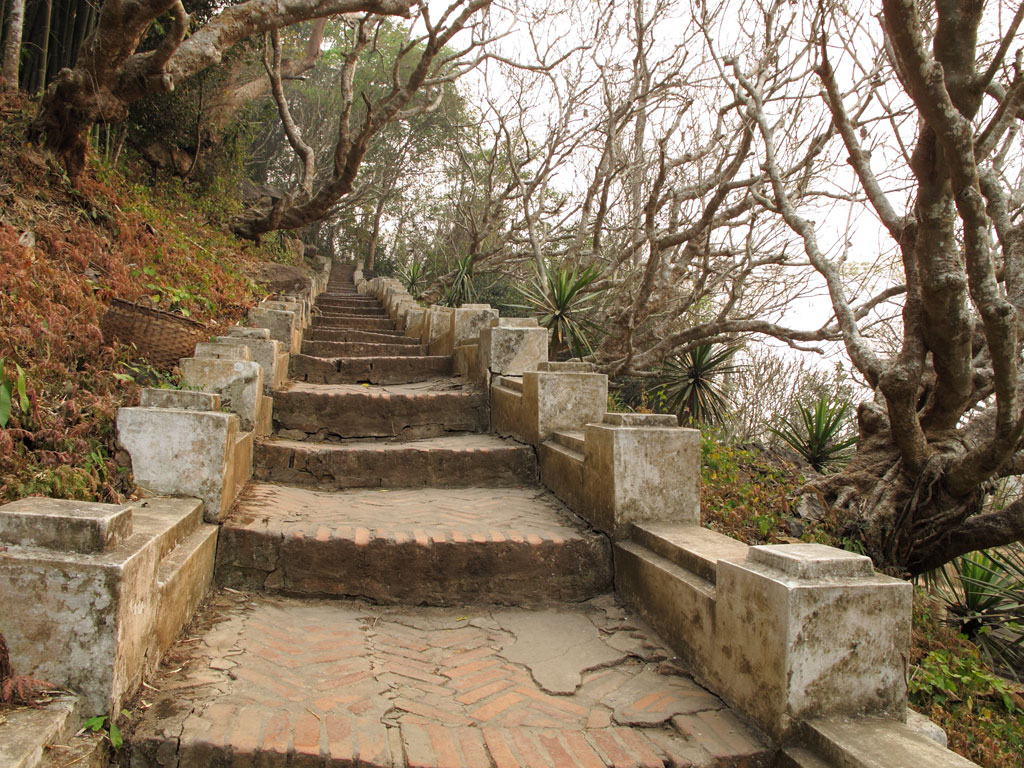
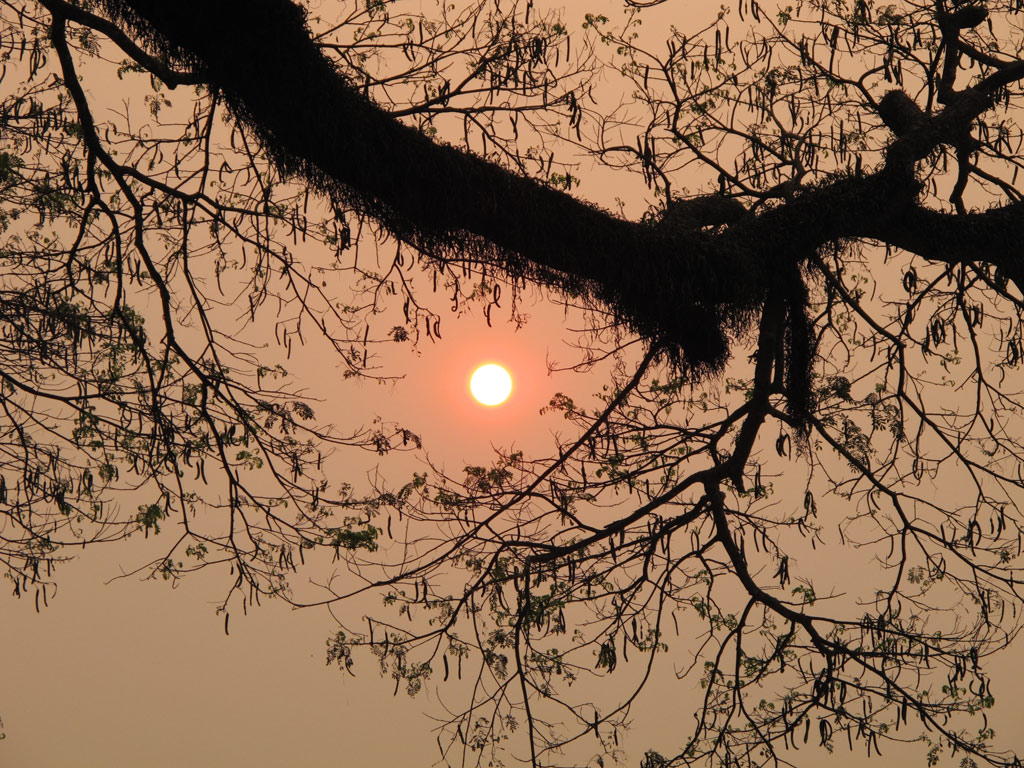
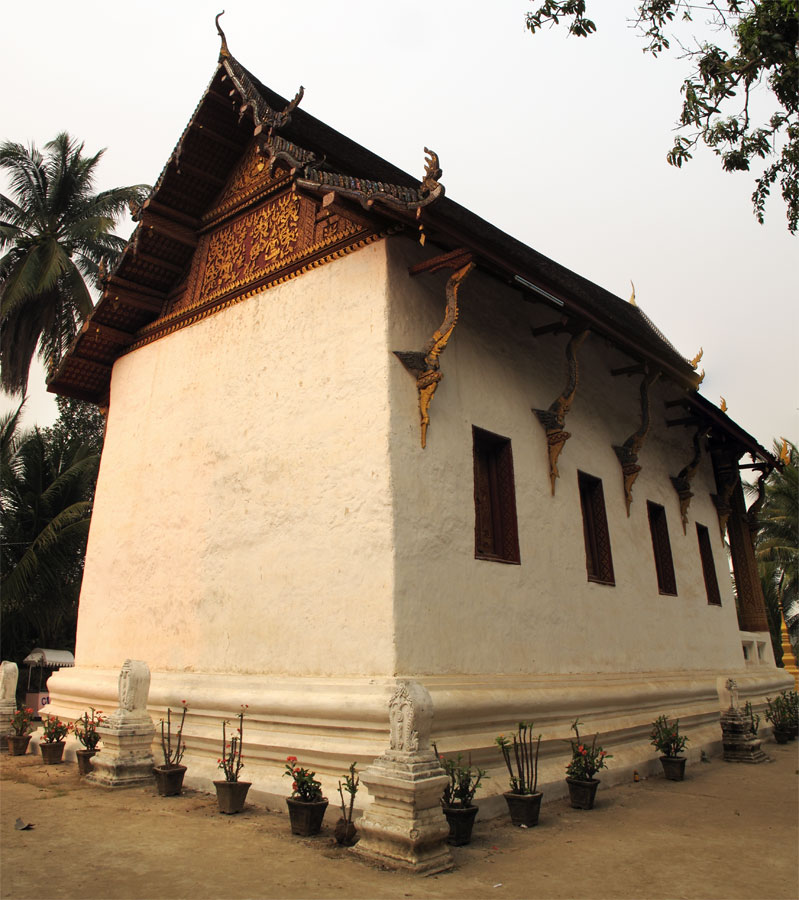
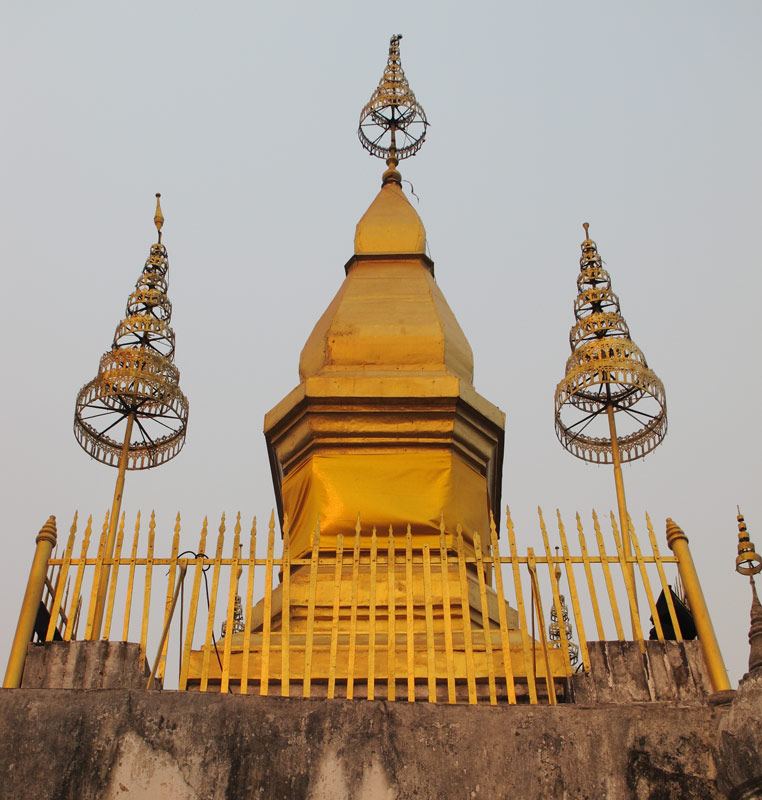
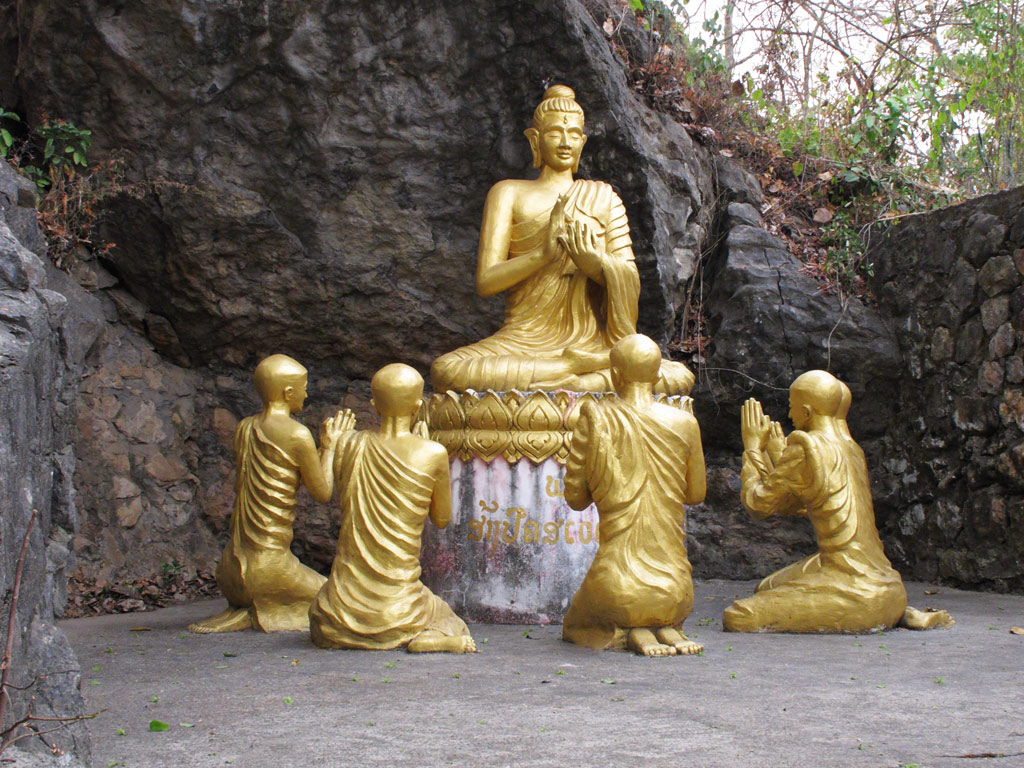
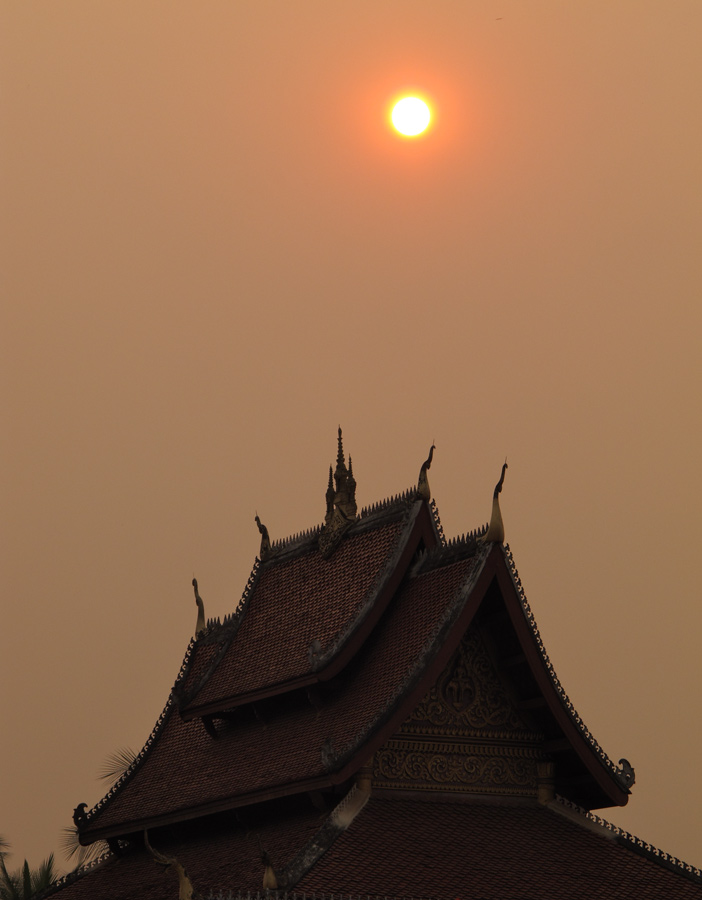
We were guided to one of the temples by a fairly aggressive drum sound. When we arrived, we saw a group of young, orange-robed monks playing a huge (really, huge!) drum, which kind of echoed back from the nearbt structures and resonated in our bodies. A spiritual experience! Later on we watched the monks try to move the drum from one place to another. Not only was it hard work, but it seemed to be a lot of fun.
The most beautiful Buddhist temple we have ever seen was Wat Xieng Thong. It was built in the 16th century, and it is much different from many others. The walls of the main sanctuary are velvety black painted with gold, and other sanctuaries in the complex have red walls adorned with glass mosaics. Truly magnificent.
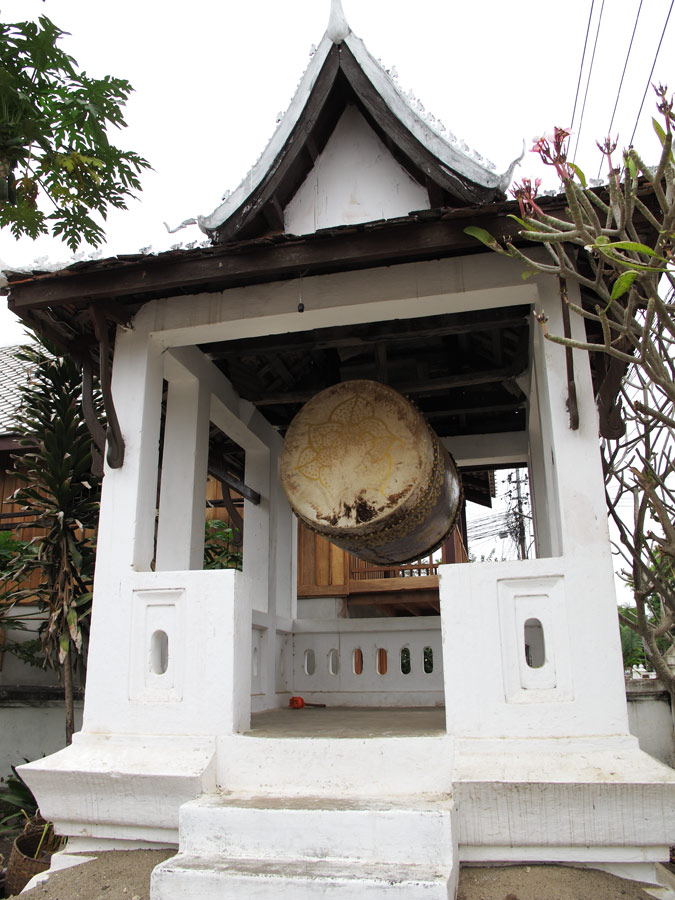
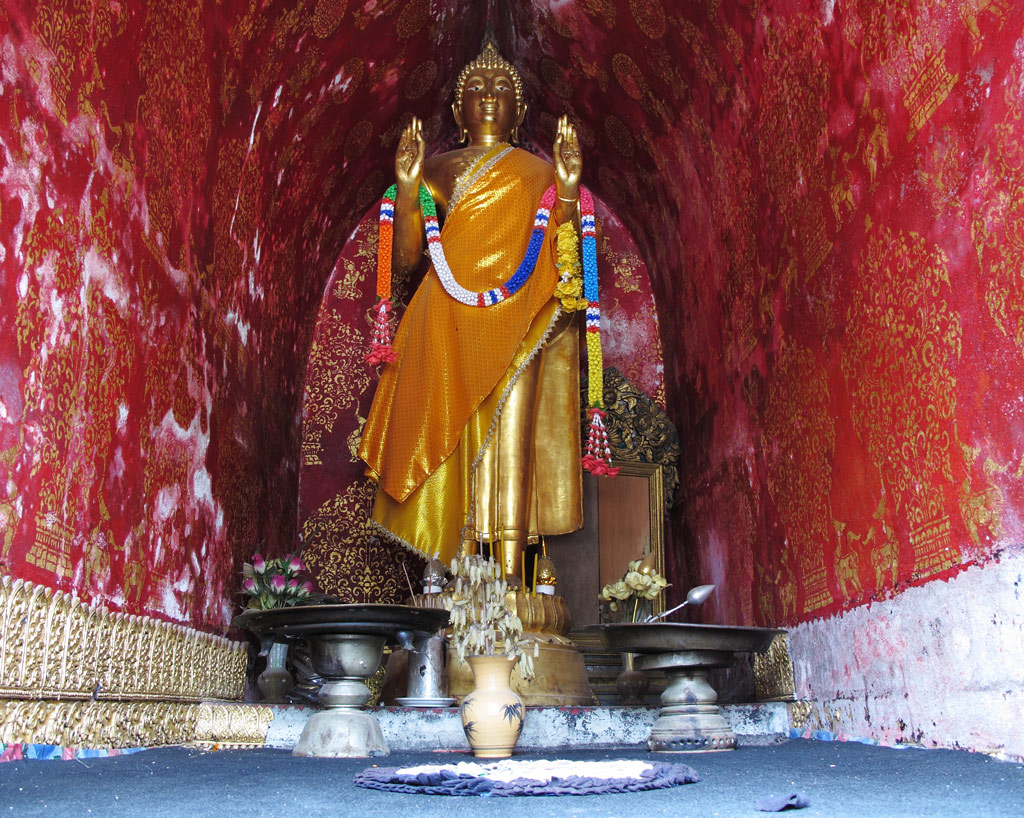
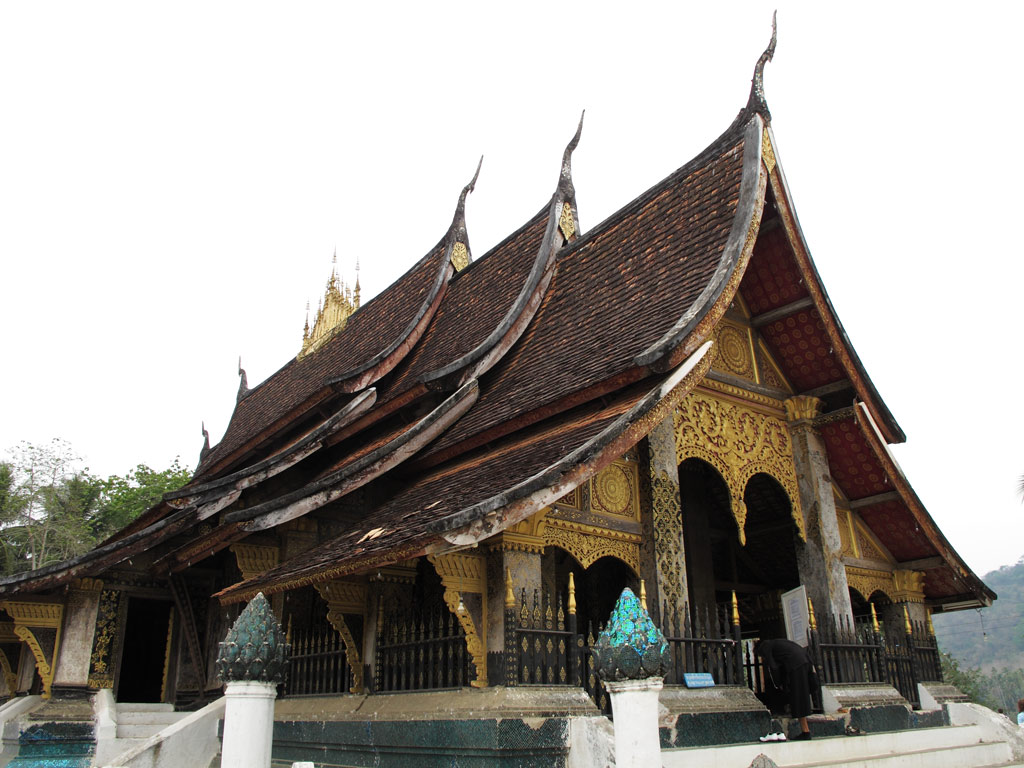
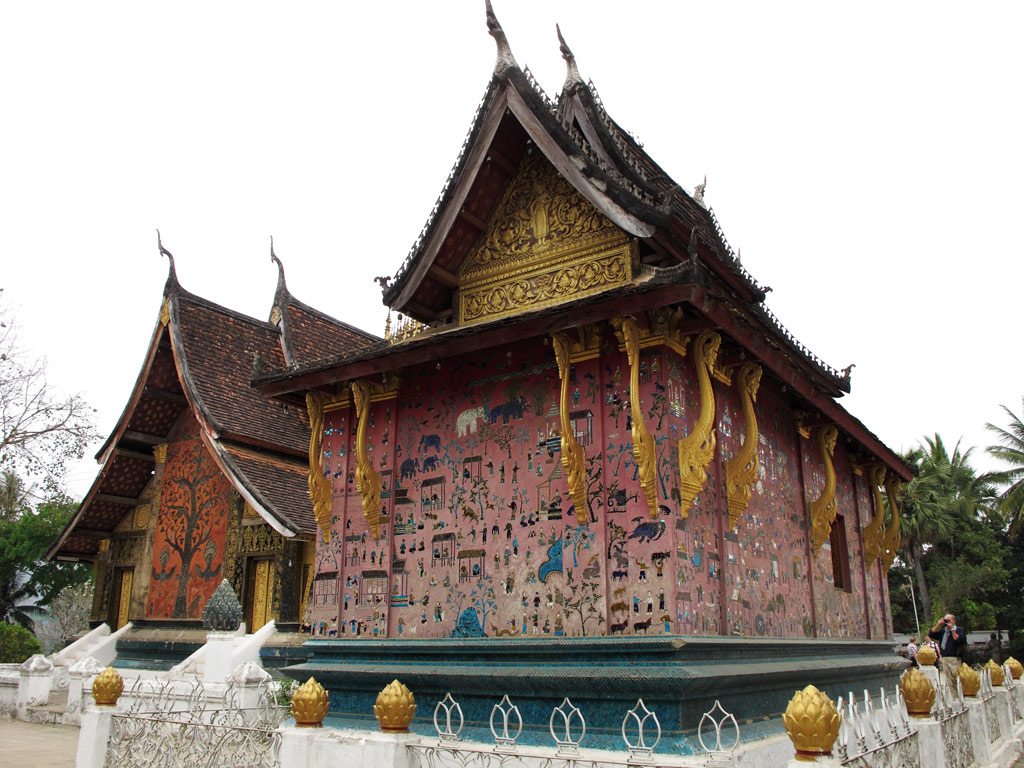
Walls made out of pieces of different colour mirror combining a mosaic.
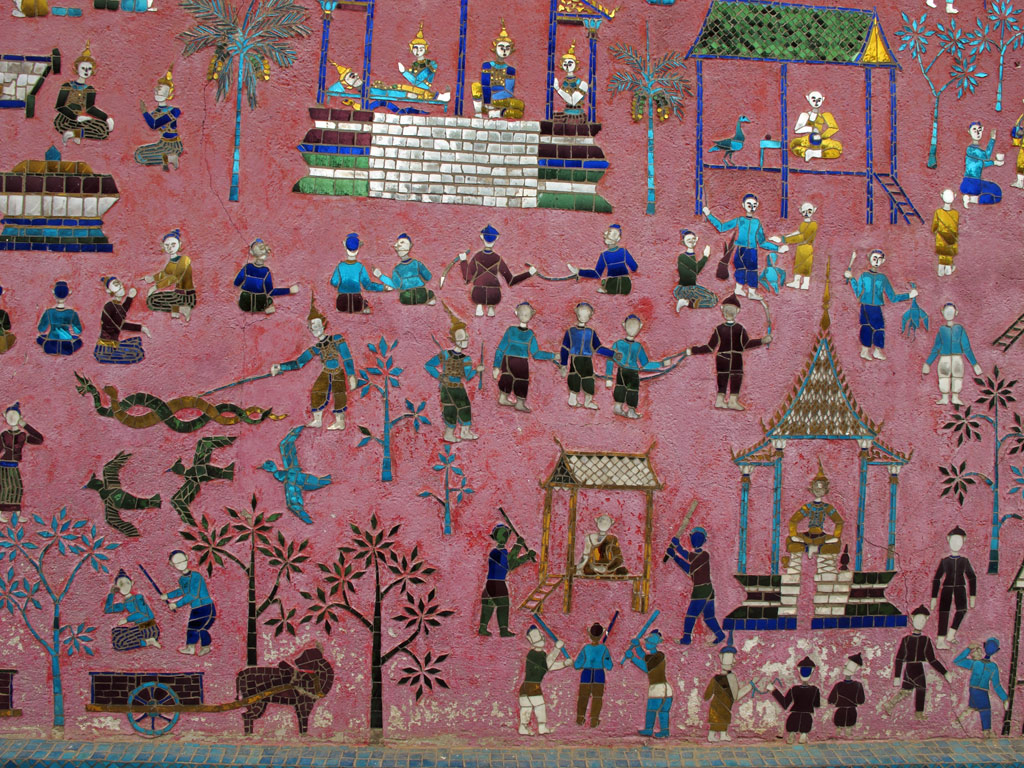
Telling you the story.
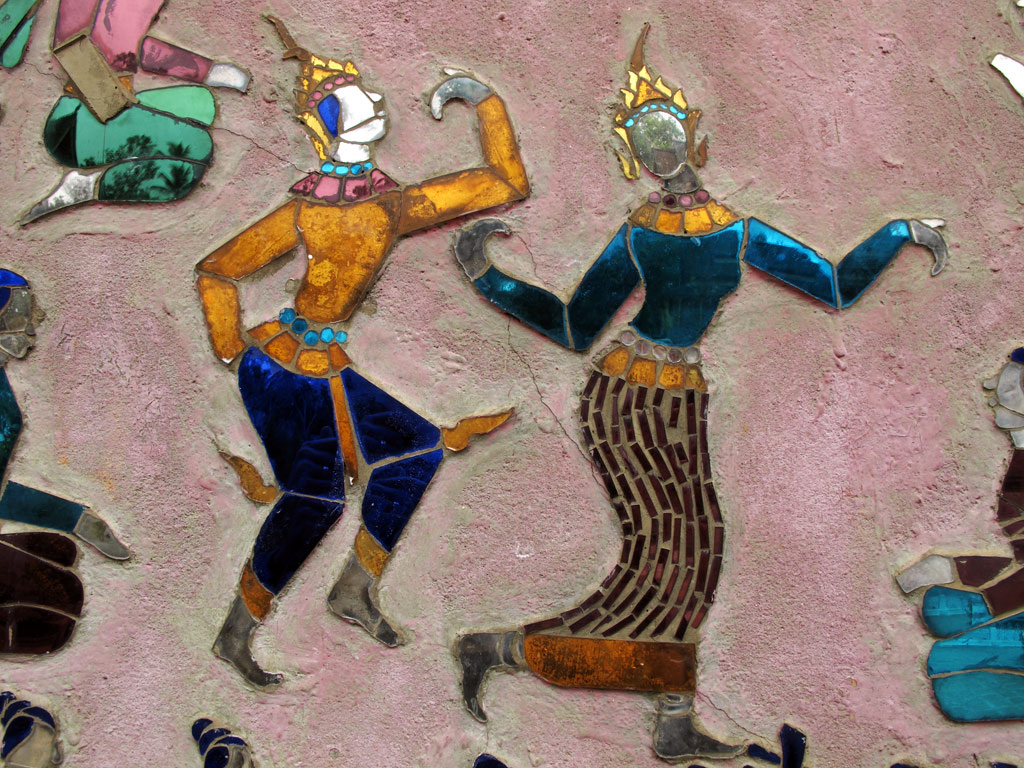
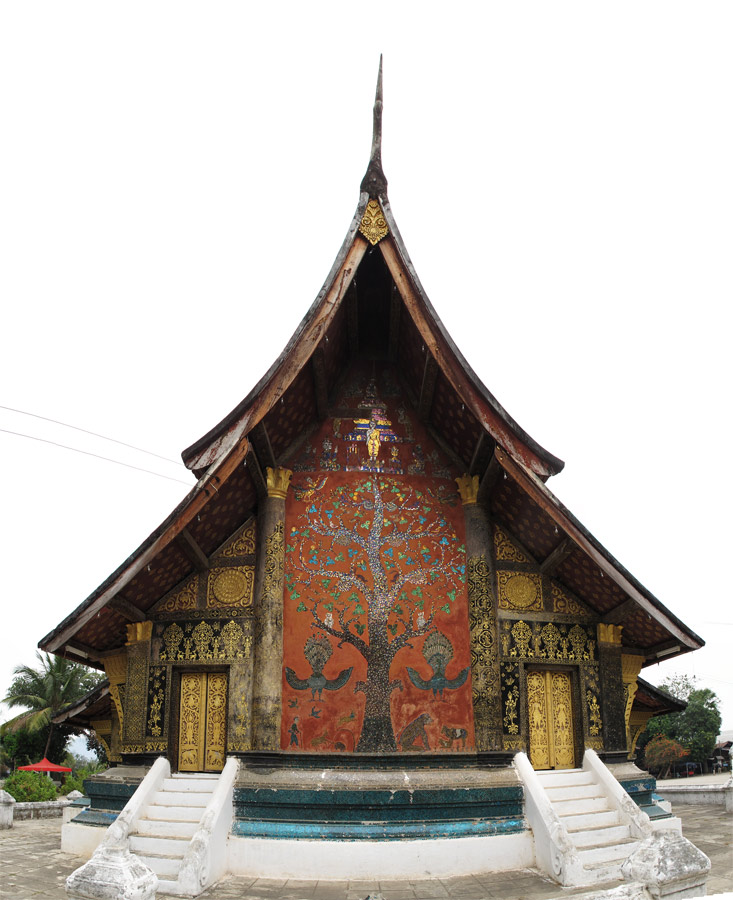
Luang Prabang is also famed for its food, and most often for its French ancestry. To be honest, we did not manage to find those outrageously cheap steaks the guidebooks are talking about (they might be cheap by Western standards, but they woud still eat a hole into our budget). So instead we continued with the laypeople's fare. Of course, the Lao people eat a lot of rice, but the most common is the so-called sticky rice which you take from a bamboo container with your hand, then form it into a ball, and dip in a sauce before putting it into your mouth.
Another staple is the good old noodle soup. Here in Laos, it is actually served in a pick-and-mix fashion - you get a bowl of soup with noodles and some meat, and then you get a number of smaller bowls (beansprouts, chillies, mint, coriander leaves, different condiments) to make it taste the way you like it.
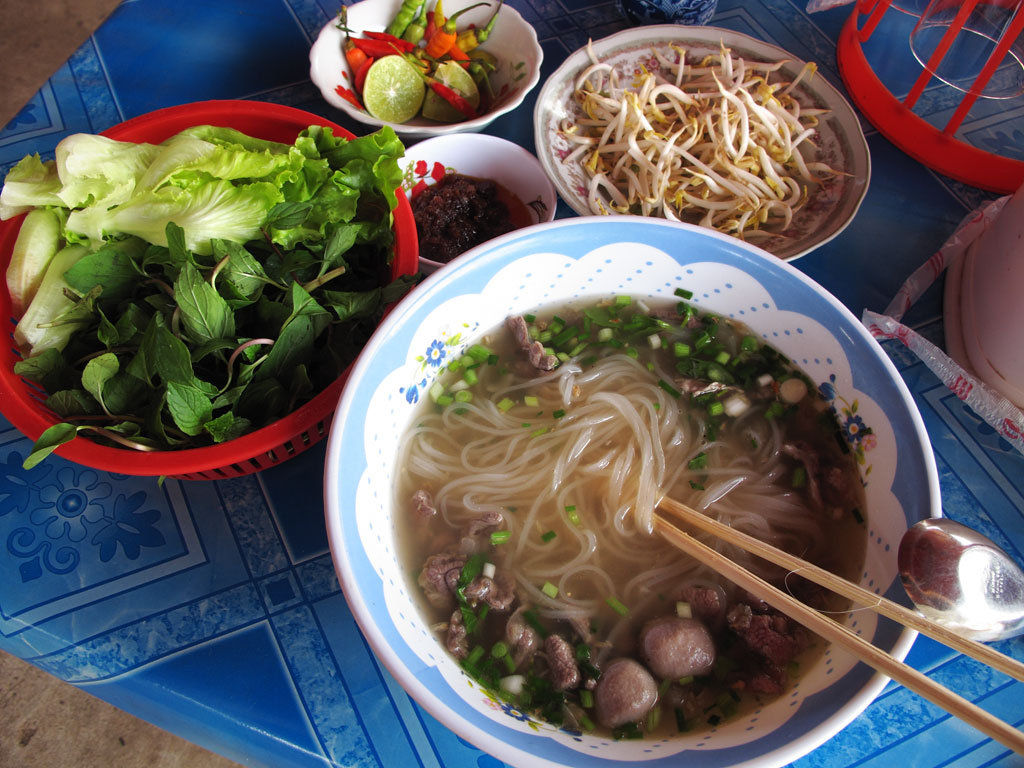
But back to the French (actually the common name for the tourists here, farang, is a shortened version of what the locals called the French - farangseh). We must be grateful to them as they introduced the allmighty baguette, which is here filled with whatever is available - mayonnaise, lettuce, cucumber, tomato, some meat. Delicious and cheap.
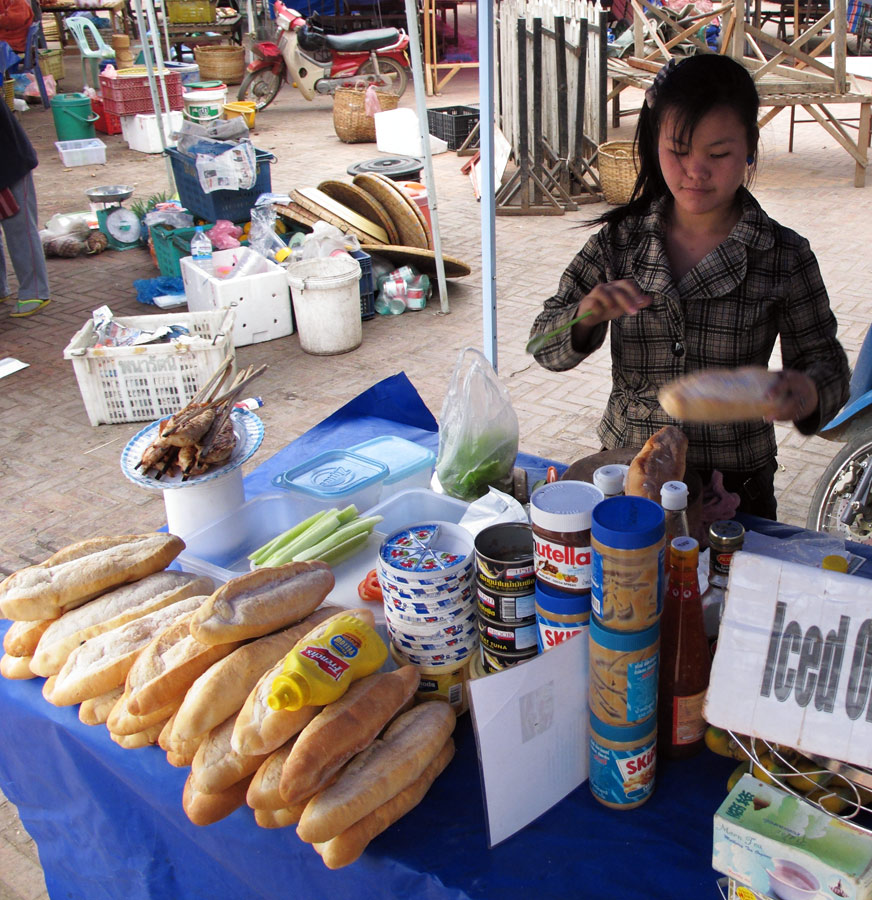

Baguette.
The locals normally wash it all down with some iced green tea.
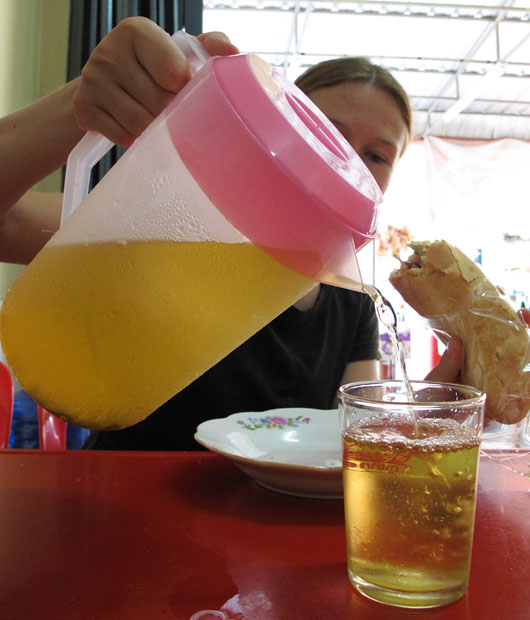
Every town here seems to have a night market, and Luang Prabang is no exception. It is a good source for cheap grilled stuff. We discovered that the grilled fish filled with lemongrass was just awesome, and went back the second day to get some more.
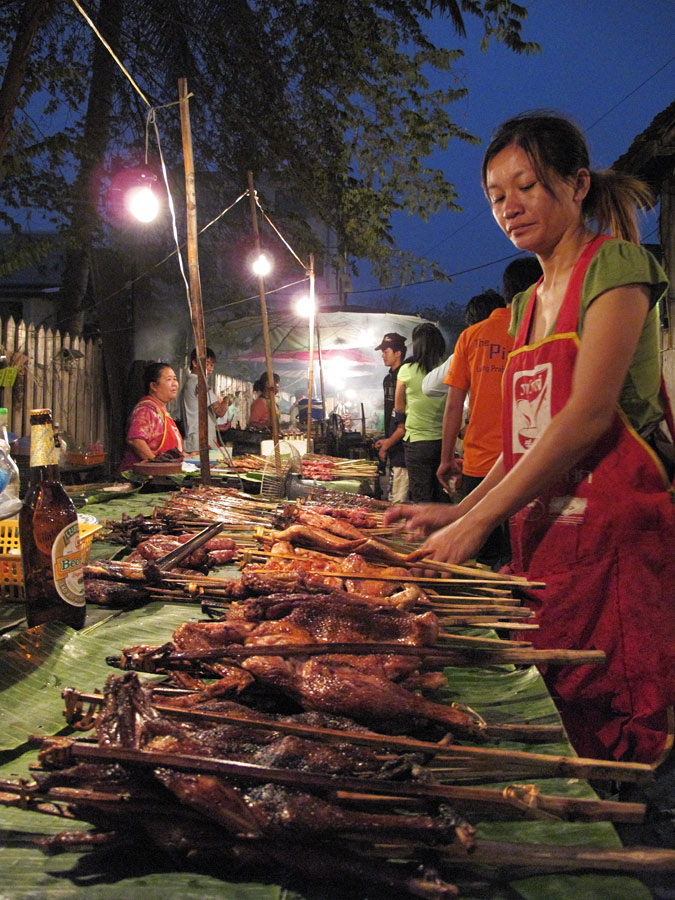
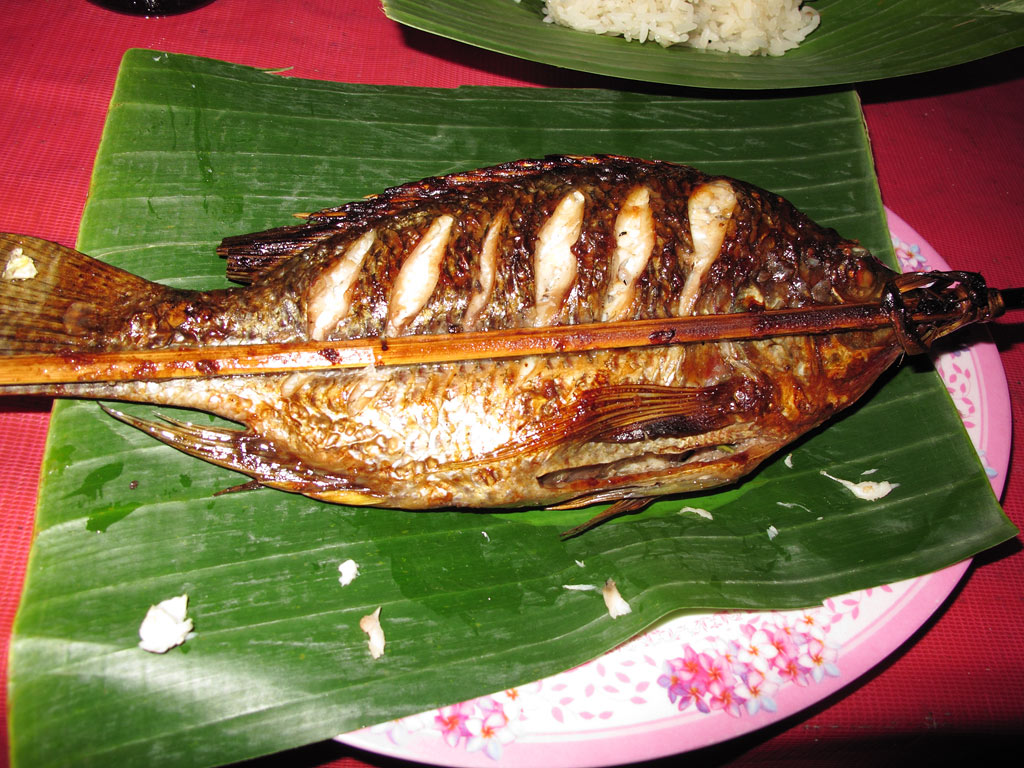
A fish filled with lemongrass and BBQ-d - superb!
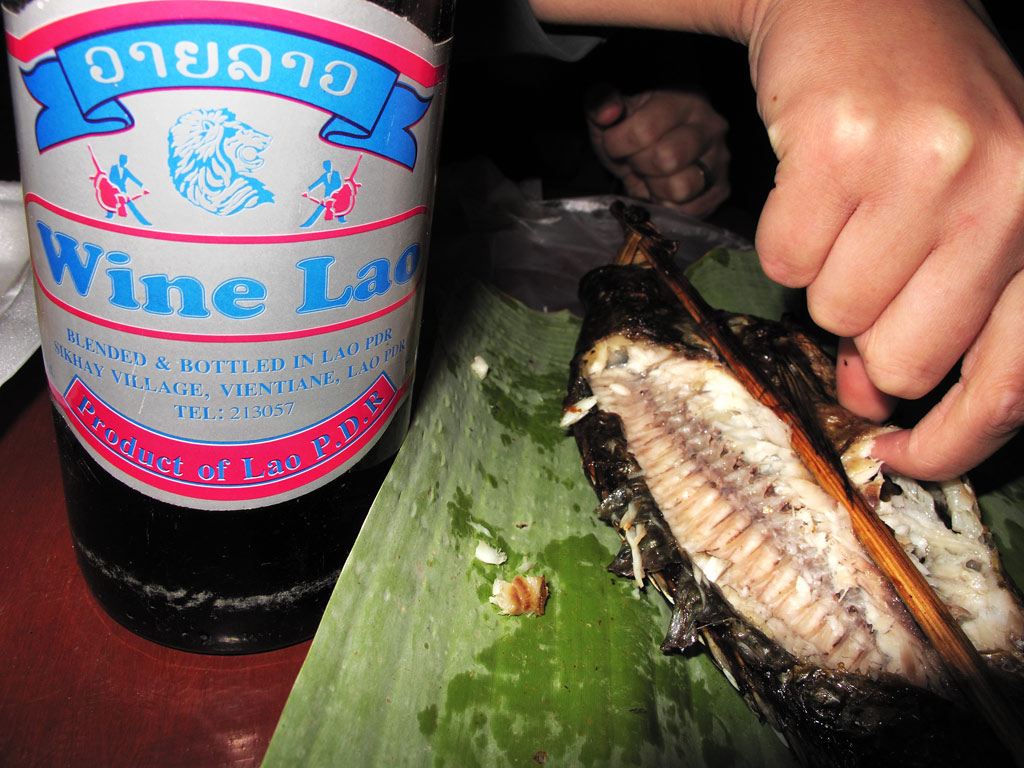
Laos wine, and yes, Kariina has learned to eat with her hands like locals do here in South-East Asia - she says things taste better when you can feel the food you're eating. I never really gotten a habit for it yet, maybe I should try harder?.
We made a slight omission by buying a locally produced bottle of wine to accompany the fish. The wine was not bad in itself, but it reminded more of some raspberry liquor mixed with sparkling wine. It would have been much better with Beer Lao Gold, which is, in fact, even better that the regular Beer Lao.
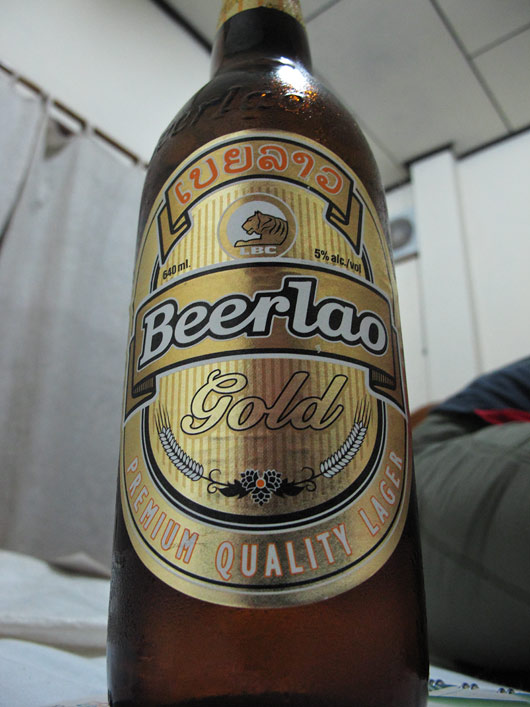
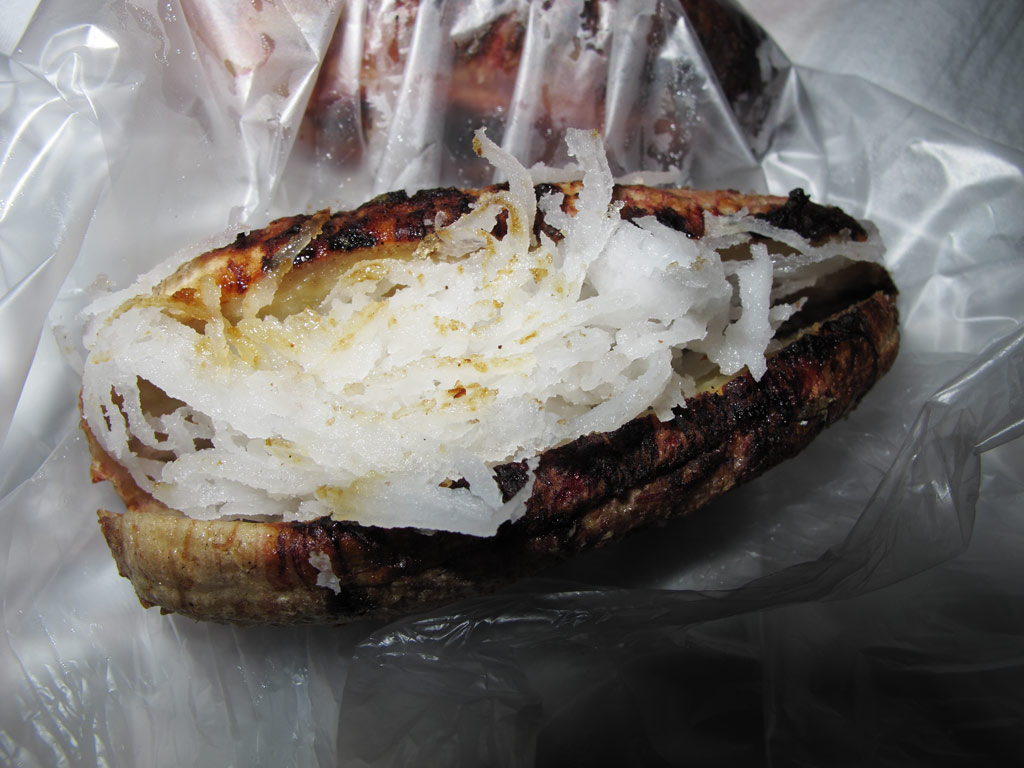
Another delicacy you can find here on the market is grilled banana filled with fresh grated coconut. Yummy!
After we had been enjoying the charms of this nice little town for a couple of days, we rode off, in search of more adventure and positive emotions. Once again we stumbled across sleepy mountain villages, and once again we were greeted by friendly people and the omnipresent "sabaydee" ("hello") by the children. Only the turkeys were not too happy seeing us. Maybe it is because many of their brothers had been run over by some scooterists?
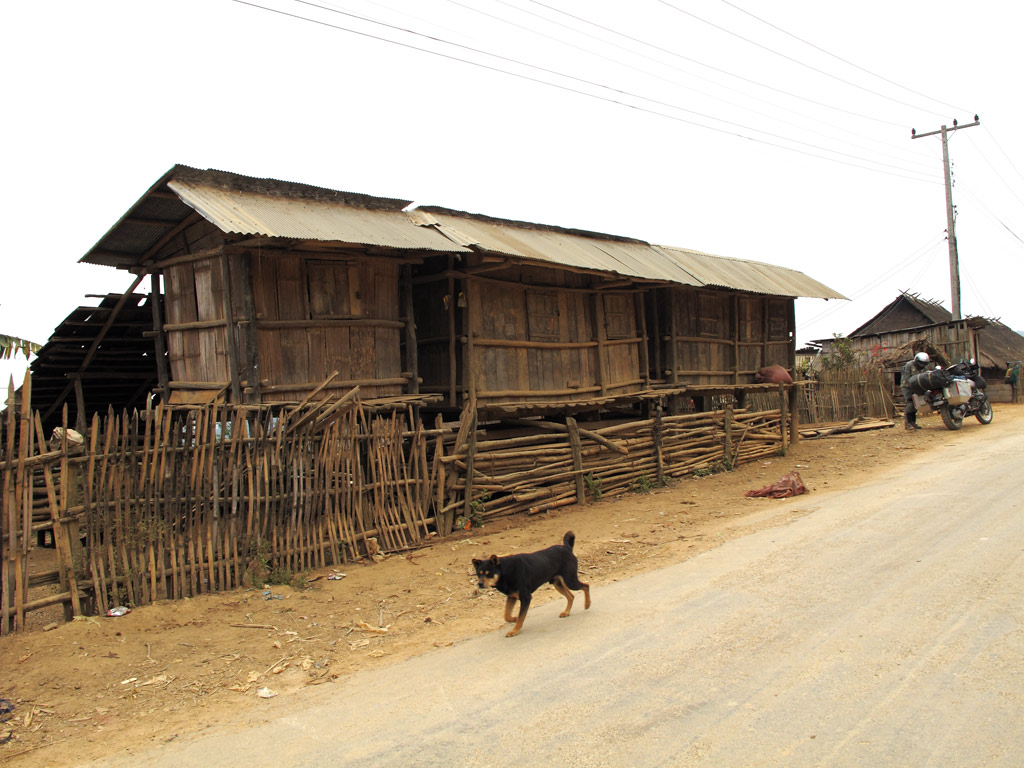
Laos mountainvillage.
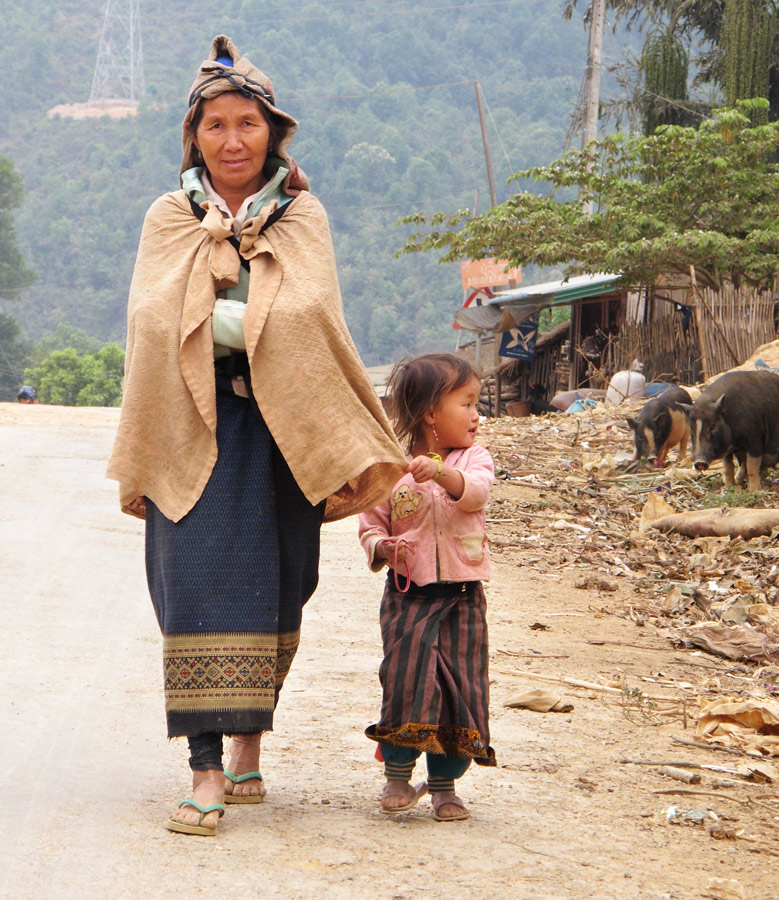
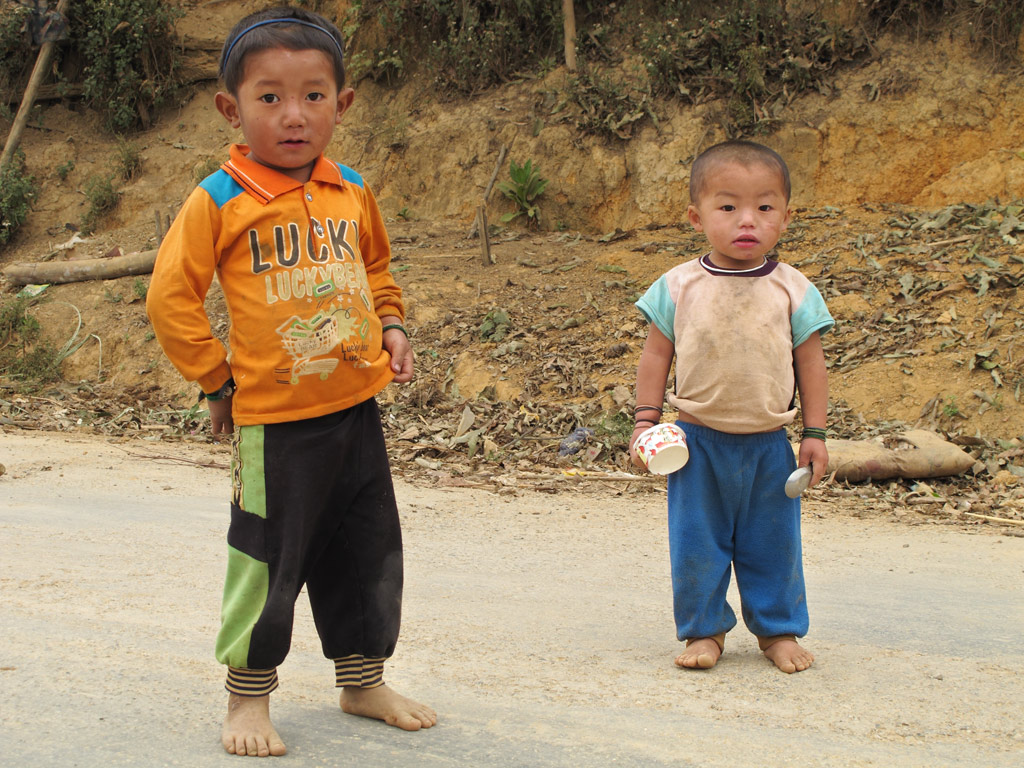
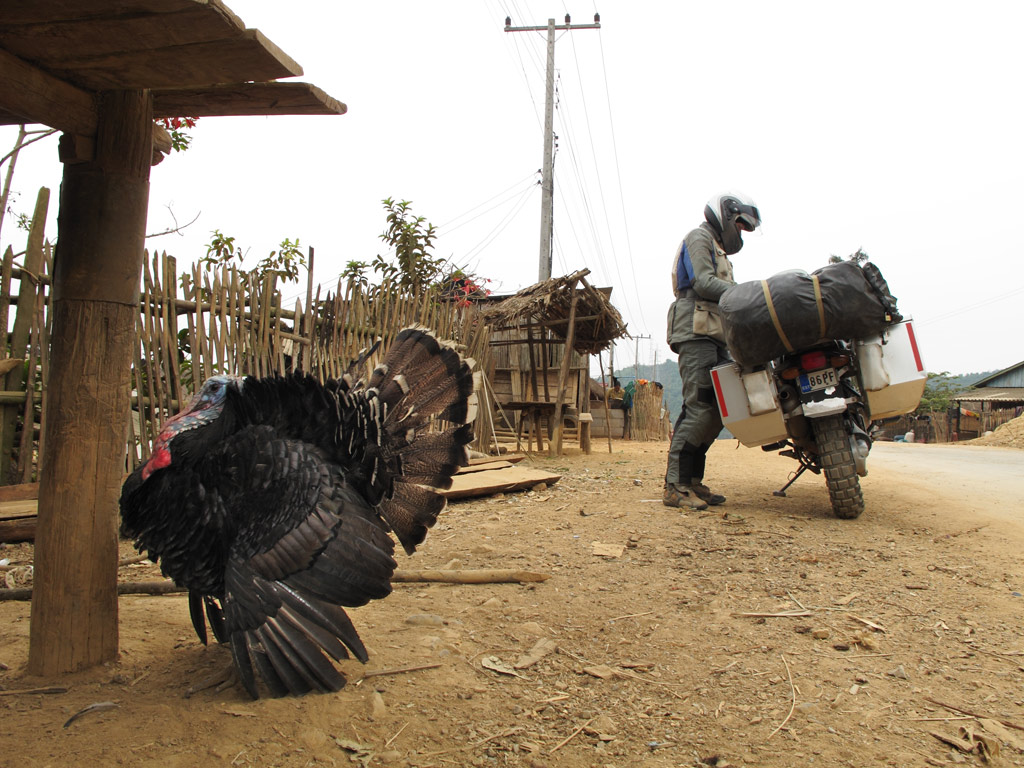
An agressive male turkey playing tough-guy.
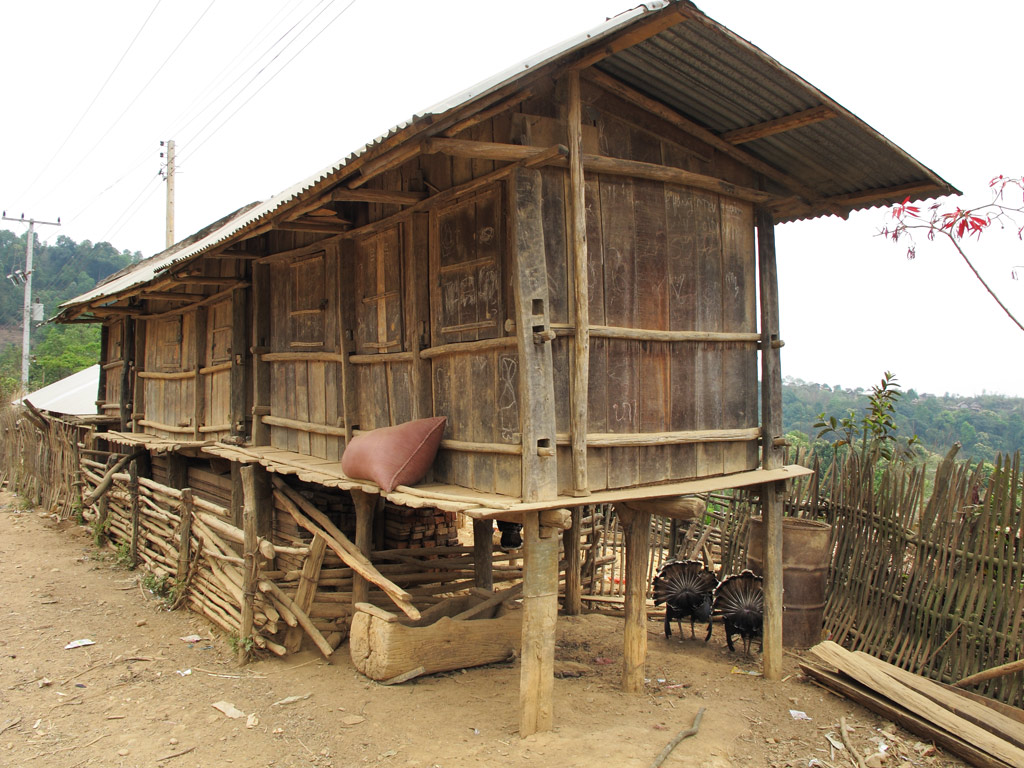
Typical living house in Laos villages.
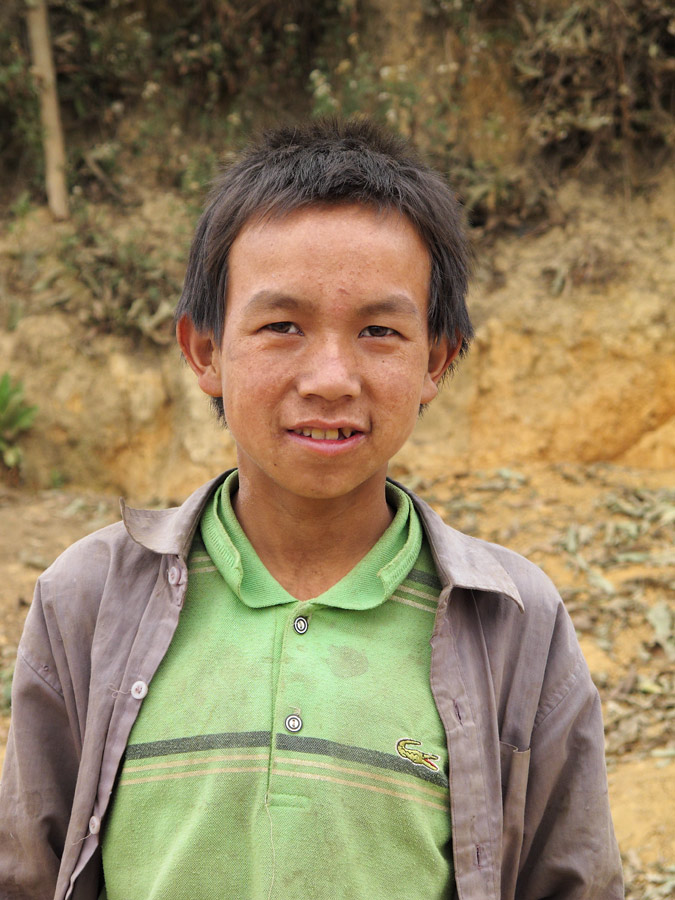
Curious young man in Laos came to check our GS out.
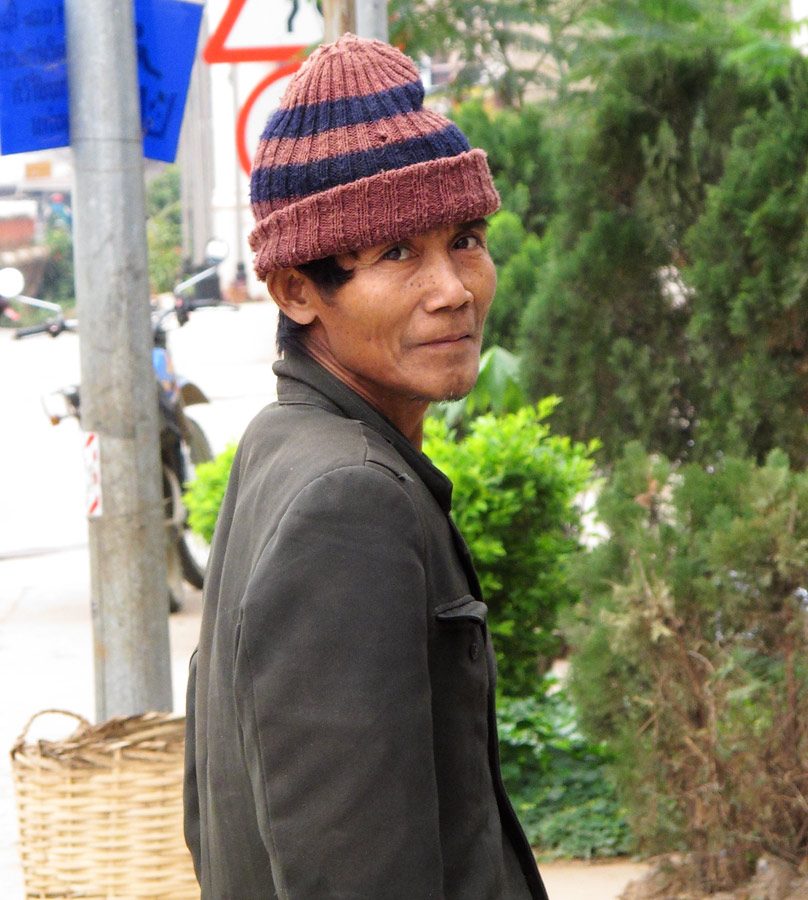
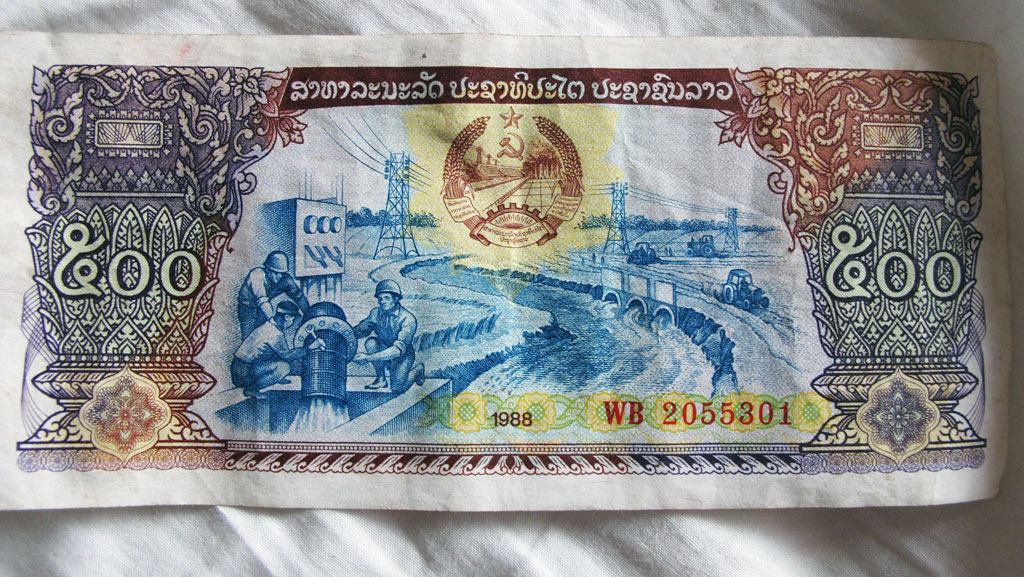
And more flashbacks from the Soviet times. We found that the 500-kip note bears striking resemblance to the communist posters we have seen before.
Northern Laos is well known for many hill tribes - many of them from China and Myanmar - who live here, and mostly people go to see them on an organized tour. Somehow we happened to have a waypoint called "Akha village" in our GPS, so we decided to give it a try.
The road was rough, as always, and as we do not have a good map of the area, we were not even really sure it it was gonna take us where we wanted to. But we kept on rolling, at a steady 10 mph, and once again thought of the future of Laos. We saw immense rice paddies, and there were too many clearings in the surrounding hills due to the logging.
We recorded some sounds of the existing nature.
In many places we saw simple bamboo huts standing by the road, which were obviously made for the local workers. As we approached one, a group of young men started waving their hands wor us to stop. That is what we did. The ignition went on and off, and so did the lights even before we could react. Not only were they curious, but they did not seem to have a slightest idea of the notion of personal space that we all so revere about in the West. Well, I did not lose any time either, but just kept on taking photos. Everybody was happy.

Click to enlarge the panorama.
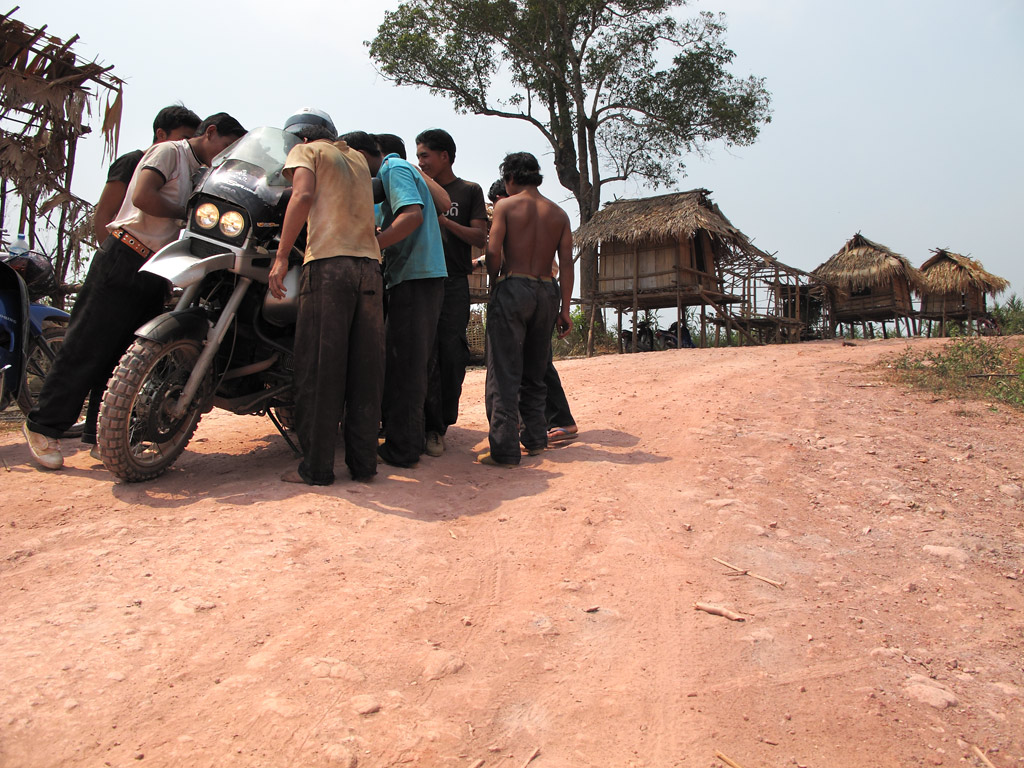
Our GS seems always to be a huge curiosity object with it's single sided swingarm having shaft drive, stunning-looking boxer engine, fuel injected throttle bodyes on it, ABS sensors on wheels and telelever front end is like extraterrestrial-technology for the people in this part of the world.
Soon our GPS showed that we were very close to the village we were looking for, and indeed there was a village on the slope in front of us. Looked pretty damn regular village.

Click to enlarge the panorama from village.
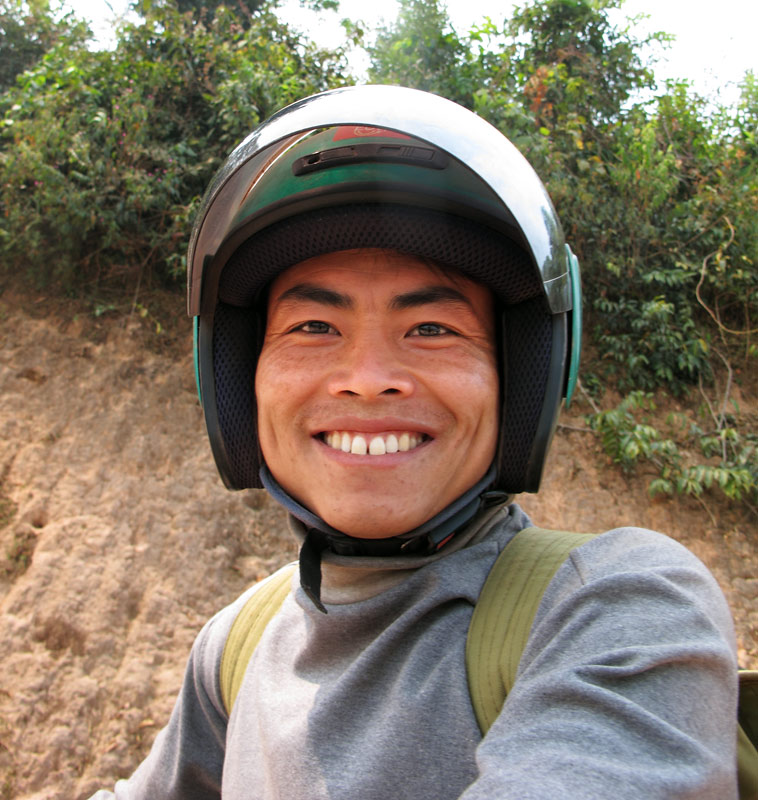
Then a local guy with a scooter passed by.
Then a bunch of kids, screaming "Sabaydee! Sabaydee!" and sounds from village:
.::LISTEN::.
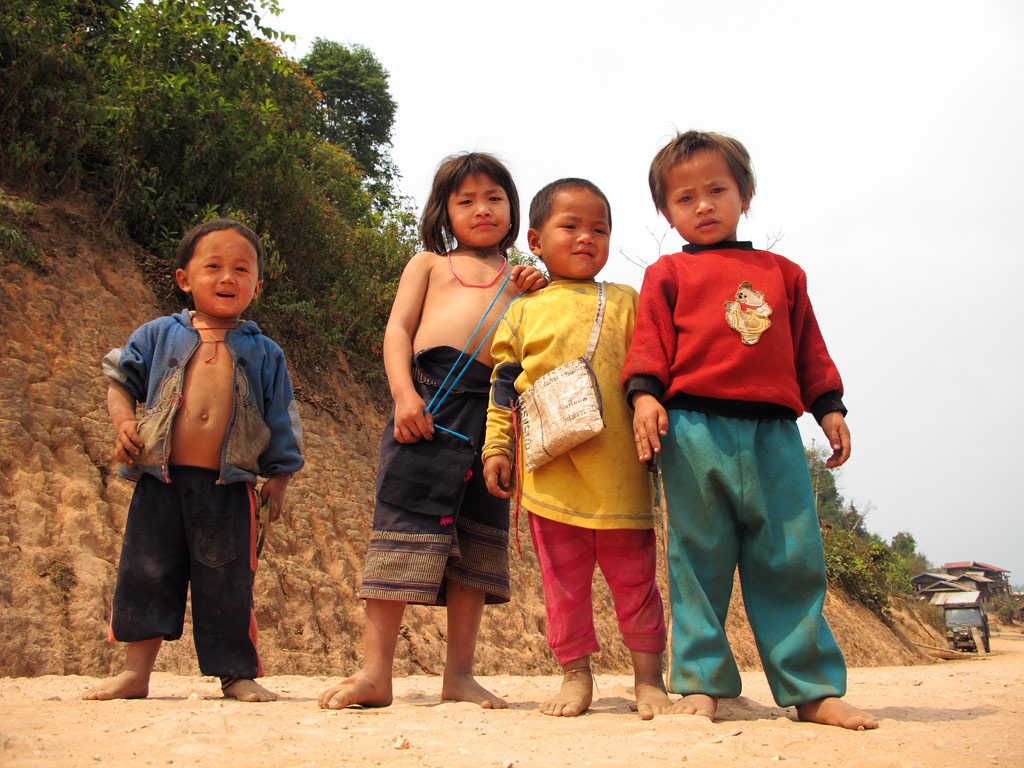
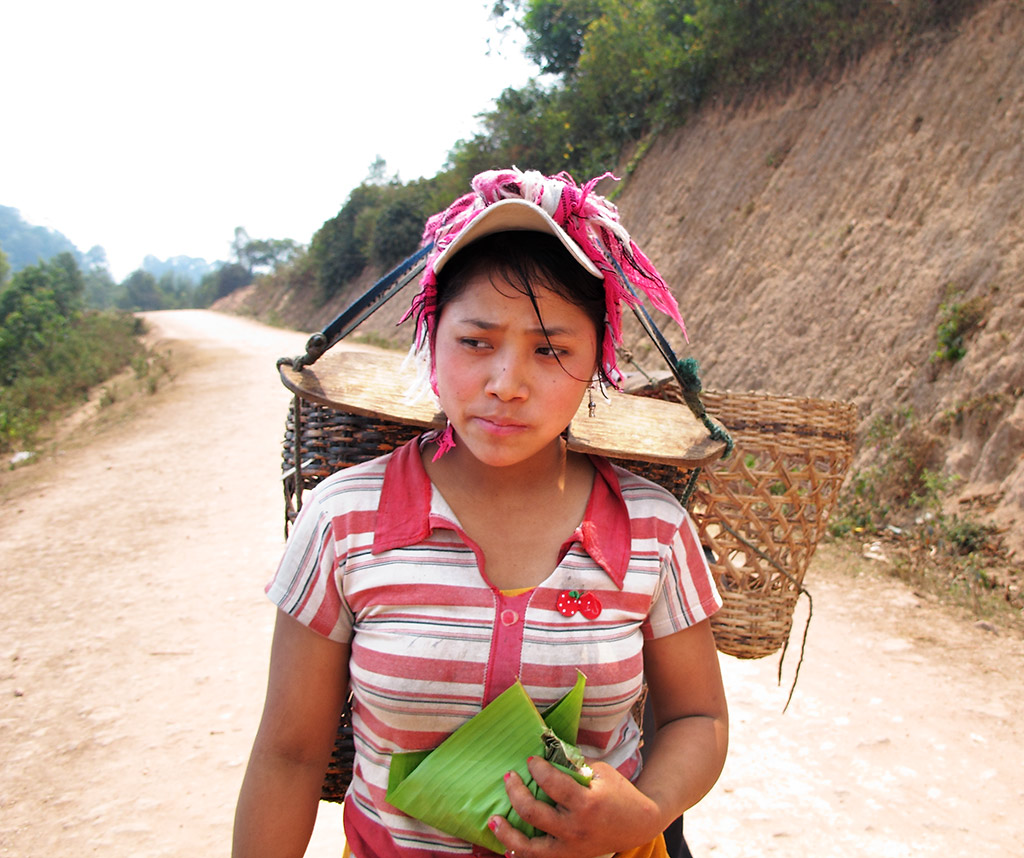
Then a couple of young ladies rushing to work in the field.
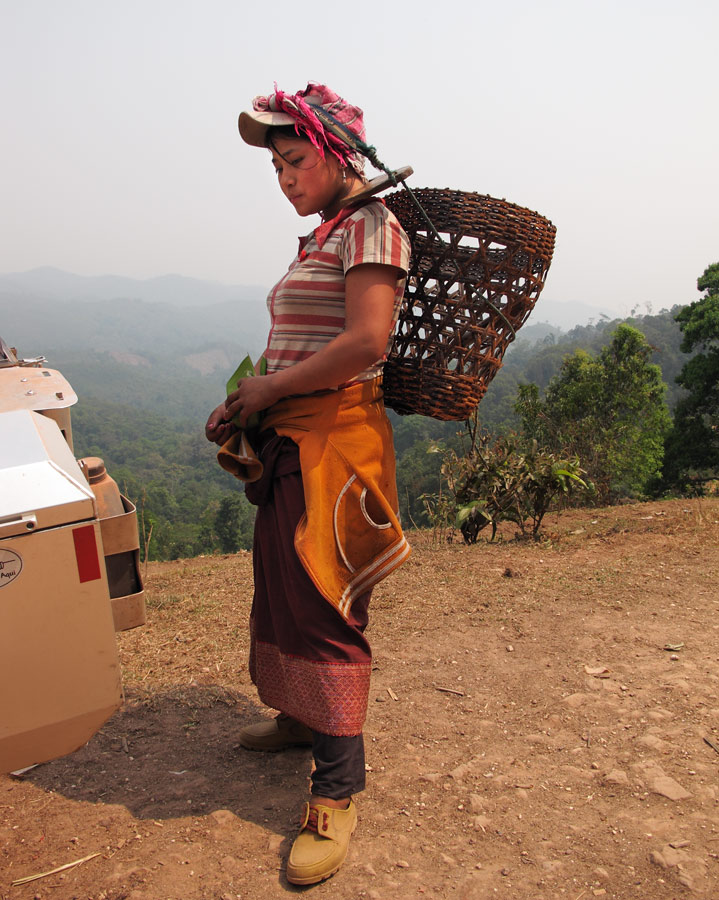
Lady checking out the GS.
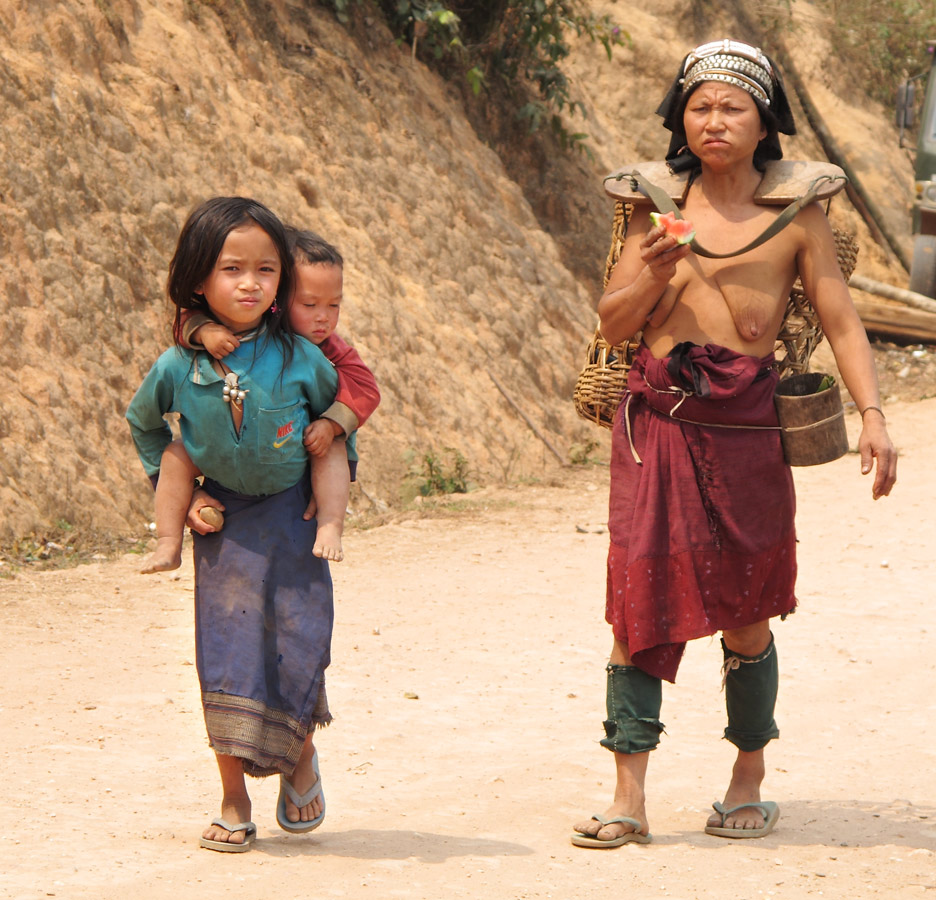
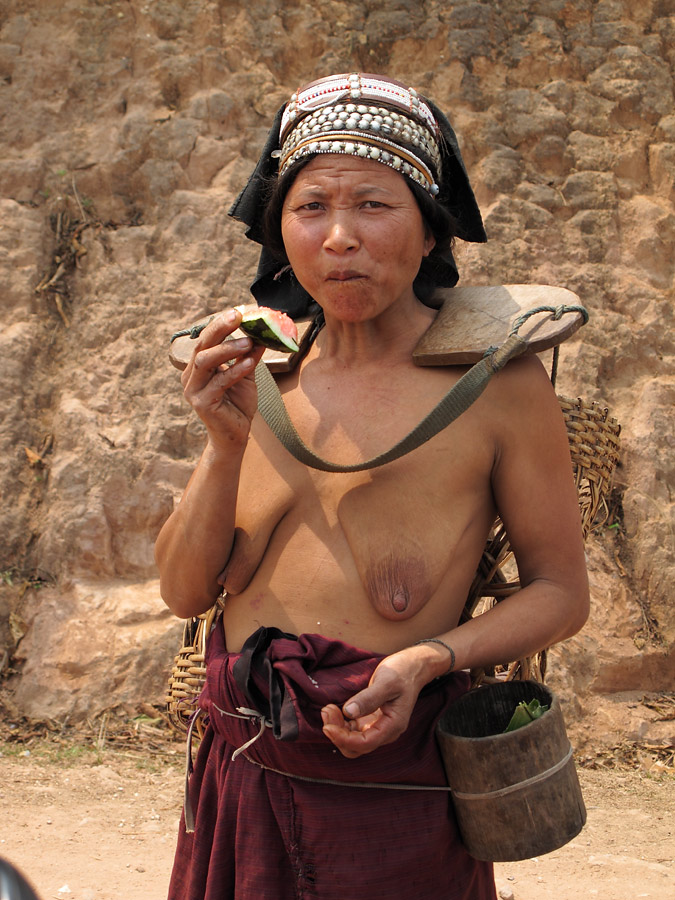
And then a topless elderly lady, wearing an Akha traditional beaded headdress, and eating watermelon.
We realised that it was no "damn regular village" at all, and plunged deeper inside. The regular crowd gathered, and all was good. No comments needed.
Just a couple more thoughts on Laos before we move on to the next chapter. This country had quite some surprises in stock for us, mostly due to the fact that before we did not know much about Laos. Except that the roads were bad and that they were worth it because of atmospheric mountain villages. As always, the real picture was more complicated than that. Sure, the roads of North Laos are nothing to shout about, but this will change soon, as there is loads and loads of road construction going on. And sure the villages are great, but after having seen those in East-Timor and Indonesia, this is nothing new to us. The things that we will remember about Laos are the following: the French colonial heritage, the communist flags, colourful hill tribes, strong coffee and the unexpected kindness of the strangers.
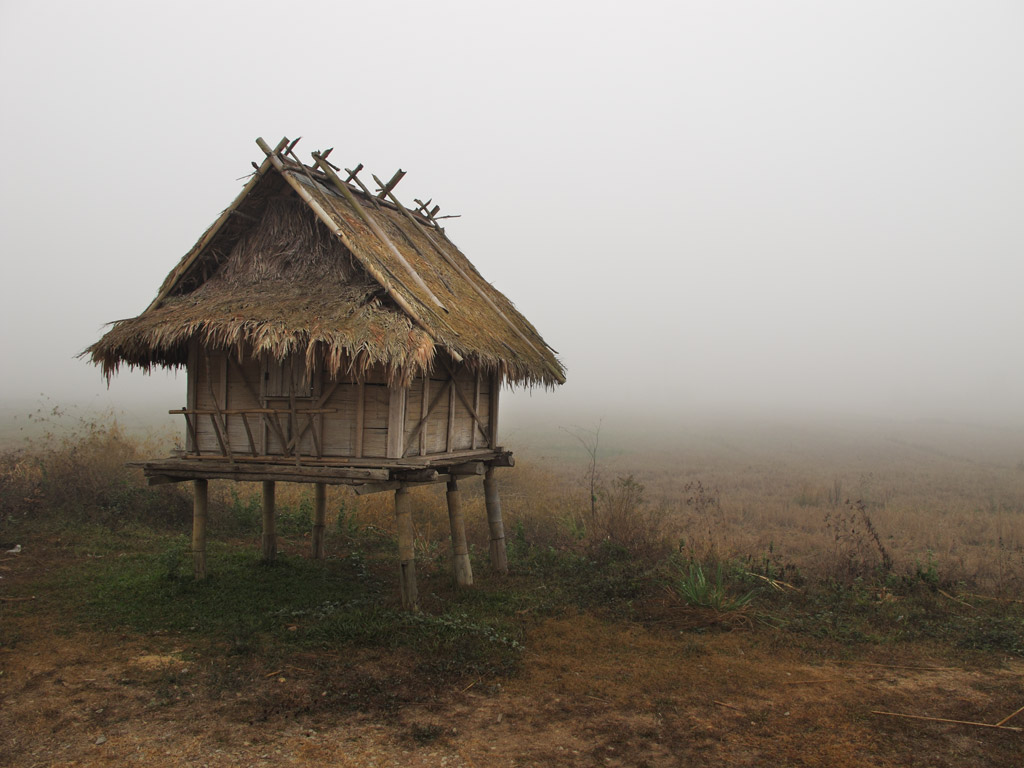
And last but not least, a video from Laos:
<object width="640" height="385"><param name="movie" value="http://www.youtube.com/v/keqRCIyExGw&hl=en_US&fs=1&"></param><param name="allowFullScreen" value="true"></param><param name="allowscriptaccess" value="always"></param><embed src="http://www.youtube.com/v/keqRCIyExGw&hl=en_US&fs=1&" type="application/x-shockwave-flash" allowscriptaccess="always" allowfullscreen="true" width="640" height="385"></embed></object>
PS: bike's horn goes off when tankbag puts pressure on it
Hope you enjoyed the installment,
Margus
We rode off the border post and made a small detour to see what is supposed to be one of South-East Asia's biggest waterfalls, at least by volume. Although it is the dry season here, the Khong Phapheng still looked pretty impressive.
As we travelled further north we were stunned by the good (and I mean it!) quality of the road, because we had only heard about how bad and muddy the Lao roads are. But it was all smooth tarmac, just as if we had arrived in some develpoed country. But the countryside looked pretty rustic and undeveloped with the thatched huts, and we were surprised to see communist memorials and bright red flags here and there. We had not suspected Laos was a communist country.


Communism is alive an kicking in Laos. The same soviet rhetorics still going strong.

Communist monument.

Typical Lao village.

Local transport in front of Lao village.

Transport in Laos way
We plunged deeper into the countryside and decided to check out some smaller roads. We had managed to pick a road that was just in the process of being constructed, and it was rough indeed - pretty rocky and included some river crossings and conditions got tougher all the time - there were almost no traffic on the road in the end - it was more varying technical terrain riding, with some patches of better gravel. On one patch as we stopped to take a picture and to relax from hard physical work we had to endure on technical sections, Kariina told me that I was not going to like what she had to show me.

The final drive was leaking, badly, and we could see small pieces of metal in the oil. Great! According to our map, the nearest village was tens of kilometers away, so we just stood there and watched it drain. And while we did, some bugs were making strange, almost hypnotizing noises in the trees, just as if it was a movie and something odd was going to happen.
Some road work trucks passed us, but none stopped.

We kept our cool. In fact, we did not feel any anxiety at all, and as two guys on a scooter approached us, speaking no English at all, and giggled at the sight of oil flowing onto the dusty ground, all we could do is laugh with them. It was an absurd situation.


They rolled off, we stayed. It was not a first time sight for us. The first time the shaft drive leaked we were on Ruta 40 in Argentina, and we had managed to replace both the bearing and the seal in the small village of Perito Moreno. Both back then and now we had the spare parts with us, so no problem, but undertaking the repairs while still aside the road would have been perhaps too much adventure. Continuing to ride to the next village would not have been an option (although that is what we did the last time, but back then it was dripping slowly), since the shaft drive this time had leaked basically empty (the seal was totally ripped) and riding like that would have done a lot of damage. We had to wait for someone to come and pick us up.
But there was virtually no traffic, and after a half an hour we decided to switch to Plan B - to ride, despite all, to the nearest place where there are people. After three kilometers of slow and careful riding we arrived in a place with a couple of simple huts. It was no village, but there were people. We tried explaining to them what had happened and that we needed a pick-up truck or something, but no English was spoken, as usual, so we decided to wait by one of the huts.
The family was friendly, and their kids were curious about us and our bike.



Mouth-open amazed seeing us and a GS.

Shy village children staring.


The children did not appear to have any toys, so no wonder they play with whatever they find. One of the boys, for example, took a big bug, and ate it in front of us!
<object width="640" height="480"><param name="movie" value="http://www.youtube.com/v/FUo3Cc-KMTI&hl=en_US&fs=1&"></param><param name="allowFullScreen" value="true"></param><param name="allowscriptaccess" value="always"></param><embed src="http://www.youtube.com/v/FUo3Cc-KMTI&hl=en_US&fs=1&" type="application/x-shockwave-flash" allowscriptaccess="always" allowfullscreen="true" width="640" height="480"></embed></object>
While waiting I decided to remove the rear wheel and determine the gravity of the problem. It appeared that the bearing had been virtually destroyed - there were big pieces of metal. Even the locals could understand by seeing it that the bike was not going anywhere without a pickup truck.



So we waited and waited, and the lady made us some instant noodle soup.
It was getting dark soon, and finally a pickup showed up, going just in the same direction, and for some money, eager to take us and the bike to the nearest village with a mechanic shop. The setting sun saw us bouncing in the back of the truck down the same road we had come.


The driver stopped a couple of times along the way to smoke a sigarette with some local chaps.

A communist-styled clothed bloke smoking a self-made cigarette.
By the time we arrived in the village it was pitch dark. We were unloaded at some workshop, and a crowd gathered. We could not see if there were friendly faces or not - it was so dark. Obviously it was too late to start working on the bike, so we asked if there was a hotel nearby. We were told that there was, but we would have had to leave the bike in the workshop, with the people we had not even seen. We did not feel to secure about it. Then the owner, mister Ki said we could spend the night at the workshop.
What a relief! After a long day we had ended up in a strange place, but people were kind enough to let us stay near our bike in their workshop. We were deeply grateful, and already started to put our mats on the floor next to the bike, as we were told that we would not neet to sleep on the greasy floor. Instead, we could sleep on the carpeted patio. What a warm welcome from a stranger!

Later on we were offered beer and we were invited to eat with the family. The food was truly simple, but it tasted delicious.


Ki and his wife.

The next day we woke up early. The women strated boiling rice at five o'clock in the morning, when the sun had not begun rising yet.

Once I got my hands on the GS with a good toolset, repairs went easy and swift. An hour or two. I used our camping cooker's burner to heat up the bevel box to open it, then additional heating for removing bearing was the biggest task. First I tried kicking it out, only got it moving barely, but then Ki came up with an idea to use his hydraulic lifter to remove the bearing once we kicked creative support bars between the shaft and bearing. Then heat up the casing again, mount it back on and we're good to go.





New bearing inside.

Heating up the casing to have an easygoing installation.

Ki's workshop panorama where I worked on my GS.
On pictures the job may look complicated, but it's very easy, especially doing it the second time - in fact if I compare the spent time of replacing final drive bearing to the time needed to change a chain and sprocket set, maybe just a bit longer job but not much. Lots of readers may now wonder, chain vs shaft? I'll put it in my personal way: carrying bearing+seal set takes 3 times less weight and room than carrying a chain and sprocket set, costs 1/3 of the chain set and lasts over 50 000 miles under abusive use, while I've never gotten much more than 12 000 miles out of a top quality o- and x-ring D.I.D. chains on my chained drive bikes that I've owned while carefully cleaning and lubing chain after every 300-500 miles, every day when it rains and frequently checking tension. With shaft drive I don't have to clean and lube it almost every day (I don't like automatic oilers since mostly I'm riding in very dirty/dusty conditons), adjust it, replace it, I don't have oily wheel and boots every day and my hands are clean every day. So in case you're wondering - despite the tendency of bearing to blow around constant 50-60 000 miles under our abusive use in third world roads, doing occasional real offroad 2-up that very few do with such a loaded bike, the shaft drive still is a winner for me! Would even be a winner if I had to replace the same bearing 18 000 miles. If it'd constantly last less then that, maybe then I'd consider to live with the hassle that comes with a chain drive in our mile-munching journey - our GS has 112 000 miles on odometer - how many chain sets would that be if I'm not easy on throttle and maintain the chain while on the road? For short journeys, chain drive would do fine if I have home and a garage to frequently maintain it.
I suppose I could have done it aside the road too using exhaust pipe of running bike on center-stand to get the extreme heat needed to remove the old bearing and heating up the new one on mounting in a very robust method, but looks like the decision to find a workshop and do it clean is a living proof of the old saying among the very experienced motorcycle travellers (NOT the inexperienced holiday travellers, who expect everything goes smooth): Interruptions are the journey.
Without coming here and meeting up with Ki and his family, we'd never learned about Laos culture and people so deep and wouldn't had made friends.


A happy ending pic and Ki gave us a pic of his wedding day - a symbol that we really were a part of the family now.
With fresh bearing in our final drive it was the right time to take more risks and head for the really bad roads to kill the bike!
Started off riding small roads in Boli Kham Xai and Xiang Khoang provinces that rarely see tourists. And no tourists without the reasons - first of all the roads are just murderous for your vehicle and it is one of the most densely mined areas (be the Americans during Vietnam war) of Laos, so it's extremely inadvisable even to go take a pee couple of meters off the road.
We've never seen so many river crossings (here: without the bridges, obviously) during our expedition. We did well over 10 river crossing per day, some were easy, some bloody hard and deep water while riverbed consisted of big rocks - this is not a place to fall off the bike since the running engine will suck water inside immediately and there's no help coming - very few traffic goes around other than few locals with their small Honda Cubs going very slowly not to kill their precious vehicles in those conditions.

An easier rivercrossing in Northern Laos.

Road ended in the river and didn't continue on the other side - we had to ride inside the river for some time to catch up with the road again.

Another river crossed and time to pour out water from our boots.

By some rivers locals were collecting rocks - don't know what for. But those locals were special - they saw me crashing while crossing the river, but as this picture shows, those ones did not laugh. :huh
The landscapes had something primeval to them. Laos stands out from the South-East Asian crowd as the country with the biggest percentage of unexploited land, i.e. pristine forests etc. That, of course, is not solely because of a good environmental management, but more due to the amount of unexploded ordnance still lying around. It costs lots of money to clear the land, and only after that can it be turned into profitable land. That said, we could still see trucks hauling huge tree trunks along the roads - it is the timber going to China in exchange for constructing roads in Laos. And let me tell you that, there is massive road construction going on right now in Laos!

Yes, that's the current MAIN road. It'll change soon with Chinese already working on Laos roads.


Click to enlarge panoramas.

Another problem here is the tradition of slash-and-burn agriculture that destroys the old growth forest and fills the air with smoke.


In fact, there is currently so much smoke in the air that even when the sun is up high, it is still red coloured, and everything looks very early morningish.


Through this mystical mist, we passed quiet villages, where hundreds of little hands waved to us, and where we were stared at just as if we were from another planet.



There's a lot of ex-Soviet military purpose equipment in Laos.

A woman in the village cooked a superbly tasting noodle soup for us.


Village boys were so curious, inspected our bike carefully from the distance, yet were shy enough to come closer.


Click to enlarge panoramas from the Laos mountain-villages.


Until we arrived at the even more mystical place - the Plain of Jars. No one knowns for sure who made those jars or fr what purpose, but some archeologists believe them to be part of burial rituals of some now extinct people who lived some 2000 years ago. Anyway the jars are big enough to provoke some questions.
If there is such a thing as a tourist Mecca in Laos, it must be Luang Prabang - a UNESCO World Heritage listed town. Of course it is laden with tourists, and with all the guesthouses, restaurants, massage parlours and souvenir shops, it is a very tourist friendly destination indeed. And yet it has undeniable charm of the fine colonial architecture and numerous temples, and of course, the great Mekong river.
Due to the ever present smoke from burning forests, the town was dimly lit, and contemplating the magnificent temples did not hurt so much the eyes. The magnolia trees lining the streets and walkways only enhanced the somewhat nostalgic feeling.






We were guided to one of the temples by a fairly aggressive drum sound. When we arrived, we saw a group of young, orange-robed monks playing a huge (really, huge!) drum, which kind of echoed back from the nearbt structures and resonated in our bodies. A spiritual experience! Later on we watched the monks try to move the drum from one place to another. Not only was it hard work, but it seemed to be a lot of fun.
The most beautiful Buddhist temple we have ever seen was Wat Xieng Thong. It was built in the 16th century, and it is much different from many others. The walls of the main sanctuary are velvety black painted with gold, and other sanctuaries in the complex have red walls adorned with glass mosaics. Truly magnificent.




Walls made out of pieces of different colour mirror combining a mosaic.

Telling you the story.


Luang Prabang is also famed for its food, and most often for its French ancestry. To be honest, we did not manage to find those outrageously cheap steaks the guidebooks are talking about (they might be cheap by Western standards, but they woud still eat a hole into our budget). So instead we continued with the laypeople's fare. Of course, the Lao people eat a lot of rice, but the most common is the so-called sticky rice which you take from a bamboo container with your hand, then form it into a ball, and dip in a sauce before putting it into your mouth.
Another staple is the good old noodle soup. Here in Laos, it is actually served in a pick-and-mix fashion - you get a bowl of soup with noodles and some meat, and then you get a number of smaller bowls (beansprouts, chillies, mint, coriander leaves, different condiments) to make it taste the way you like it.

But back to the French (actually the common name for the tourists here, farang, is a shortened version of what the locals called the French - farangseh). We must be grateful to them as they introduced the allmighty baguette, which is here filled with whatever is available - mayonnaise, lettuce, cucumber, tomato, some meat. Delicious and cheap.


Baguette.
The locals normally wash it all down with some iced green tea.

Every town here seems to have a night market, and Luang Prabang is no exception. It is a good source for cheap grilled stuff. We discovered that the grilled fish filled with lemongrass was just awesome, and went back the second day to get some more.


A fish filled with lemongrass and BBQ-d - superb!

Laos wine, and yes, Kariina has learned to eat with her hands like locals do here in South-East Asia - she says things taste better when you can feel the food you're eating. I never really gotten a habit for it yet, maybe I should try harder?.
We made a slight omission by buying a locally produced bottle of wine to accompany the fish. The wine was not bad in itself, but it reminded more of some raspberry liquor mixed with sparkling wine. It would have been much better with Beer Lao Gold, which is, in fact, even better that the regular Beer Lao.


Another delicacy you can find here on the market is grilled banana filled with fresh grated coconut. Yummy!
After we had been enjoying the charms of this nice little town for a couple of days, we rode off, in search of more adventure and positive emotions. Once again we stumbled across sleepy mountain villages, and once again we were greeted by friendly people and the omnipresent "sabaydee" ("hello") by the children. Only the turkeys were not too happy seeing us. Maybe it is because many of their brothers had been run over by some scooterists?

Laos mountainvillage.



An agressive male turkey playing tough-guy.

Typical living house in Laos villages.

Curious young man in Laos came to check our GS out.


And more flashbacks from the Soviet times. We found that the 500-kip note bears striking resemblance to the communist posters we have seen before.
Northern Laos is well known for many hill tribes - many of them from China and Myanmar - who live here, and mostly people go to see them on an organized tour. Somehow we happened to have a waypoint called "Akha village" in our GPS, so we decided to give it a try.
The road was rough, as always, and as we do not have a good map of the area, we were not even really sure it it was gonna take us where we wanted to. But we kept on rolling, at a steady 10 mph, and once again thought of the future of Laos. We saw immense rice paddies, and there were too many clearings in the surrounding hills due to the logging.
We recorded some sounds of the existing nature.
In many places we saw simple bamboo huts standing by the road, which were obviously made for the local workers. As we approached one, a group of young men started waving their hands wor us to stop. That is what we did. The ignition went on and off, and so did the lights even before we could react. Not only were they curious, but they did not seem to have a slightest idea of the notion of personal space that we all so revere about in the West. Well, I did not lose any time either, but just kept on taking photos. Everybody was happy.

Click to enlarge the panorama.

Our GS seems always to be a huge curiosity object with it's single sided swingarm having shaft drive, stunning-looking boxer engine, fuel injected throttle bodyes on it, ABS sensors on wheels and telelever front end is like extraterrestrial-technology for the people in this part of the world.
Soon our GPS showed that we were very close to the village we were looking for, and indeed there was a village on the slope in front of us. Looked pretty damn regular village.

Click to enlarge the panorama from village.

Then a local guy with a scooter passed by.
Then a bunch of kids, screaming "Sabaydee! Sabaydee!" and sounds from village:
.::LISTEN::.


Then a couple of young ladies rushing to work in the field.

Lady checking out the GS.


And then a topless elderly lady, wearing an Akha traditional beaded headdress, and eating watermelon.
We realised that it was no "damn regular village" at all, and plunged deeper inside. The regular crowd gathered, and all was good. No comments needed.
Just a couple more thoughts on Laos before we move on to the next chapter. This country had quite some surprises in stock for us, mostly due to the fact that before we did not know much about Laos. Except that the roads were bad and that they were worth it because of atmospheric mountain villages. As always, the real picture was more complicated than that. Sure, the roads of North Laos are nothing to shout about, but this will change soon, as there is loads and loads of road construction going on. And sure the villages are great, but after having seen those in East-Timor and Indonesia, this is nothing new to us. The things that we will remember about Laos are the following: the French colonial heritage, the communist flags, colourful hill tribes, strong coffee and the unexpected kindness of the strangers.

And last but not least, a video from Laos:
<object width="640" height="385"><param name="movie" value="http://www.youtube.com/v/keqRCIyExGw&hl=en_US&fs=1&"></param><param name="allowFullScreen" value="true"></param><param name="allowscriptaccess" value="always"></param><embed src="http://www.youtube.com/v/keqRCIyExGw&hl=en_US&fs=1&" type="application/x-shockwave-flash" allowscriptaccess="always" allowfullscreen="true" width="640" height="385"></embed></object>
PS: bike's horn goes off when tankbag puts pressure on it

Hope you enjoyed the installment,
Margus



